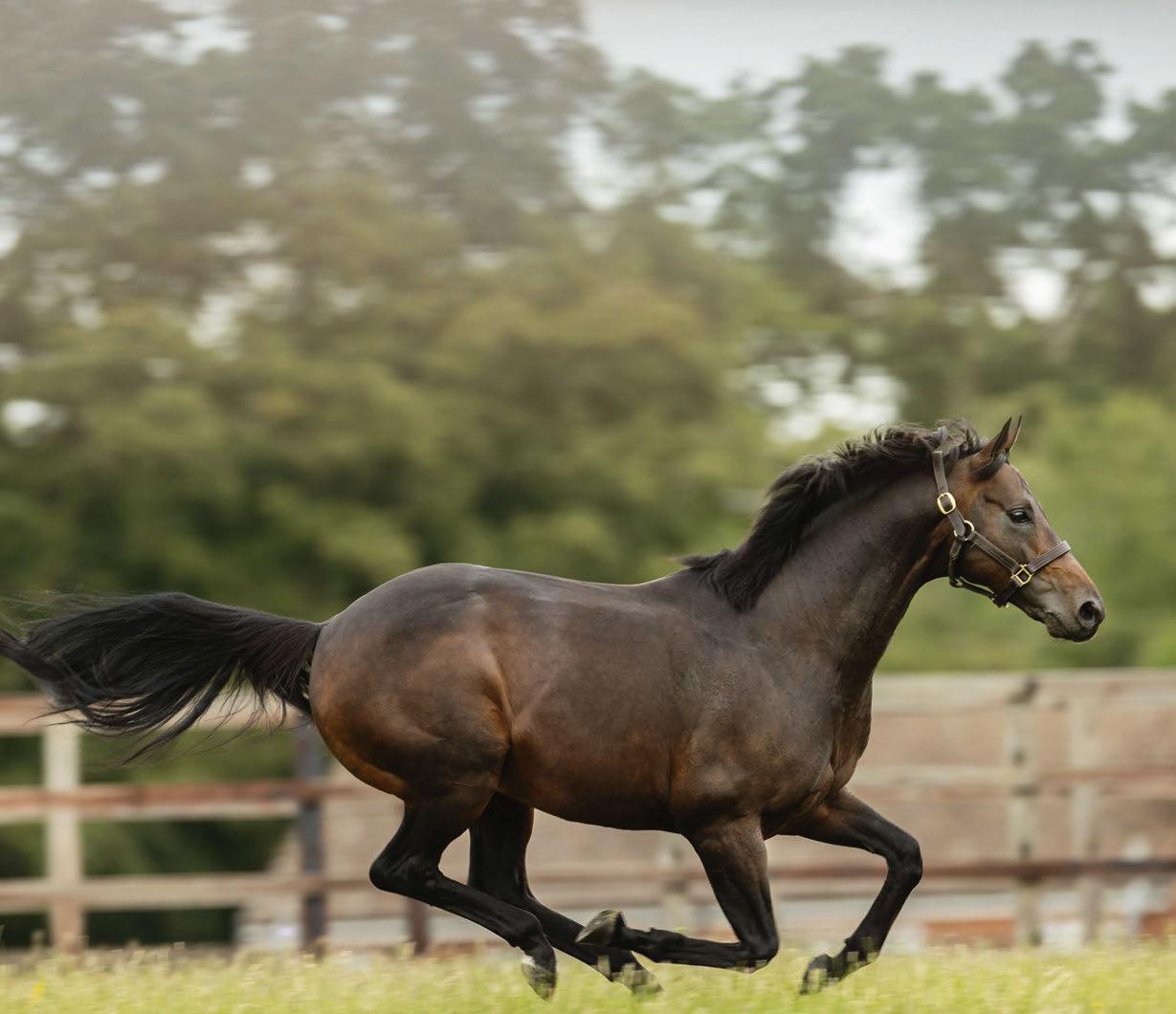

The journey starts with you
Juddmonte would like to thank all those breeders from around the world who have supported our stallions in 2024.



Juddmonte would like to thank all those breeders from around the world who have supported our stallions in 2024.
Editor: Edward Rosenthal
Bloodstock Editor: Nancy Sexton
Design/production: Thoroughbred Group
Editorial: 12 Forbury Road, Reading, Berkshire RG1 1SB editor@ownerbreeder.co.uk www.theownerbreeder.com
X: @TheOwnerBreeder Instagram: theownerbreeder
Advertising: Giles Anderson
UK: 01380 816777
IRE: 041 971 2000 USA: 1 888 218 4430 advertise@anderson-co.com
Subscriptions: Keely Brewer subscriptions@ownerbreeder.co.uk 01183 385 686
The Owner Breeder can be purchased by non-members at the following rates:
1 Year 2 Year
UK £60 £100 Europe £90 £150 RoW £120 £195
The Owner Breeder is owned by the Racehorse Owners Association
Editorial views expressed in this magazine are not necessarily those of the ROA or TBA
Our monthly average readership is 20,000
Racehorse Owners Association Ltd
12 Forbury Road, Reading, Berkshire RG1 1SB Tel: 01183 385680 info@roa.co.uk • www.roa.co.uk

It was welcome news to read that the total attendance over the five days at Royal Ascot was up on last year. With jump racing’s premier meeting, the Cheltenham Festival, seeing crowd numbers fall in March, it was heartening to see the appetite for the Flat’s showpiece fixture remains strong.
This latest renewal seemed to have had a bit of everything, with any number of outstanding performances, equine and human, plus overseas-trained winners –despite the apparent difficulty in attracting foreign runners – and of course some excellent weather!
Wathnan Racing, the ownership banner for the Emir of Qatar, Sheikh Tamim bin Hamad Al Thani, burst onto the scene before last year’s royal meeting and scooped the Gold Cup with Courage Mon Ami and Queen’s Vase with Gregory.
This year Wathnan enjoyed four winners from 28 runners, all partnered by James Doyle, who left his job with Godolphin to ride for the younger operation.
Sourcing talent from yearling auctions, breeze-up sales and private purchases of horses in training has been the model so far and while it may appear as if money is no object when it comes to this outfit, Wathnan’s racing advisor Richard Brown says that is not the case.
“There’s been plenty [of horses in training] we either haven’t been able to buy or we’ve decided not to buy because they’ve cost too much,” he tells James Thomas ( see feature, pages 34-38 ). “We’d have bought less than 50 per cent of the horses we bid on at the breeze-ups and even less than that at the yearling sales.
“We’re very careful with our valuations and if the horses go beyond the valuation then we’ll stop. We either get the horse or we walk away, those are the two options. And we’ve walked away from a great deal.”
Whether or not Wathnan start a breeding operation – “at the moment it’s just about
Edward Rosenthal Editor

producing horses that the Emir can enjoy and be proud of; that’s the remit and I think it will continue to be that for a while,” Brown says – this huge investment in British racing is a real positive for the sport.
While the King and Queen failed to hit the bullseye with their runners as they did in 2023 with King George V Handicap victor Desert Hero, their constant presence throughout the week was most reassuring for the racing community at a time of some uncertainty.
The British Horseracing Authority (BHA) and the Jockey Club will need to recruit into top positions after Julie Harrington and
“This huge investment in British racing is a real positive”
Nevin Truesdale announced they will be leaving their Chief Executive roles at the end of the year.
With the BHA also needing to find a new Chair to replace Joe Saumarez Smith, whose term ends next May, the sport has an opportunity to re-energise its leadership ranks at a time when the political outlook is somewhat cloudy and with issues such as levy reform still unresolved.
Also in this issue, Martin Stevens looks at the Japanese breeding scene and the recent recruitment of middle-distance stars Westover, Adayar and Hukum as stallions ( see feature, pages 40-43 ), while our Think Tank jury looks at the most important issues facing racing that need to be addressed by the incoming government ( see pages 87-88 ).




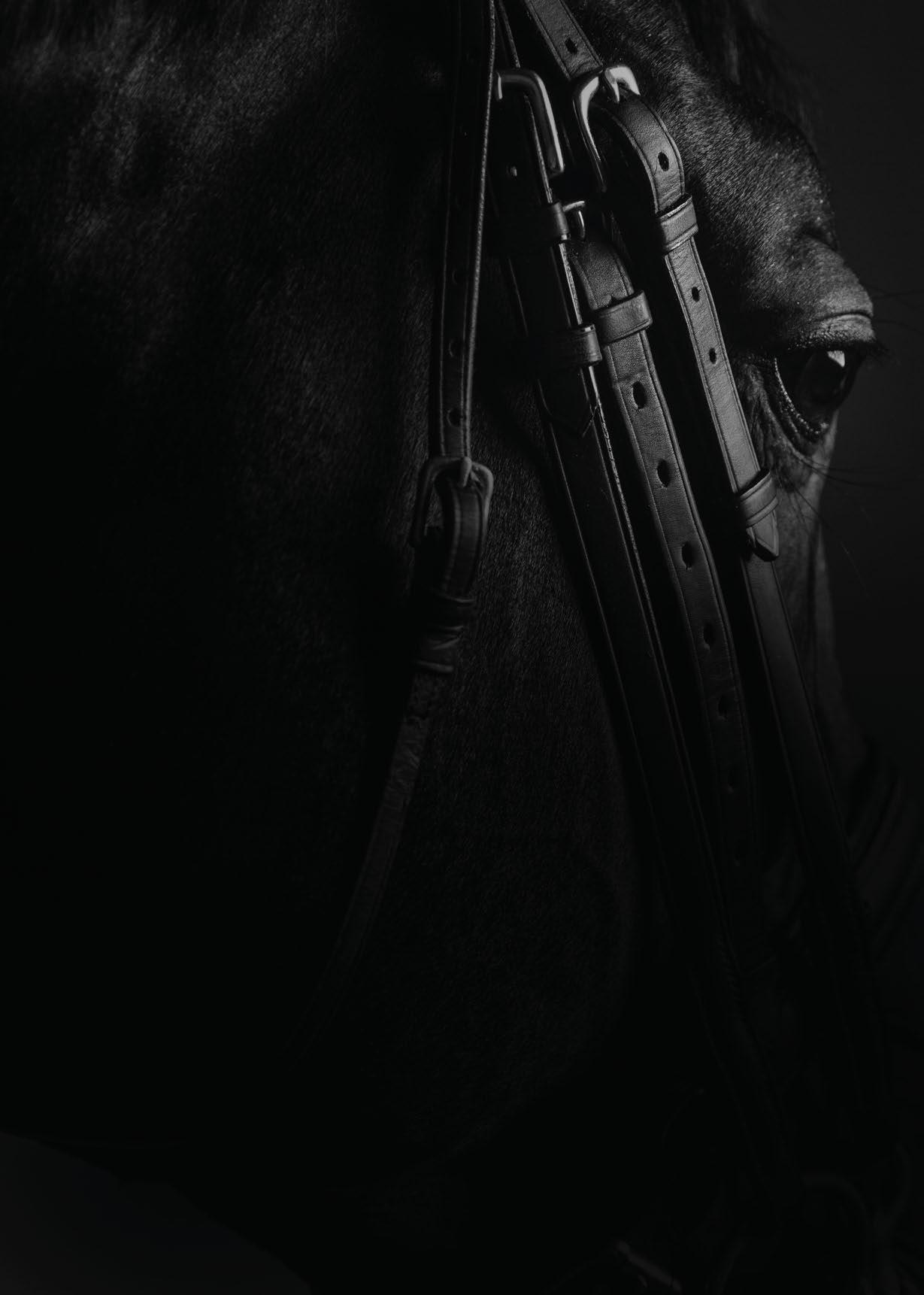
RACEHORSE SANCTUARY VISIT
Monday 8 July
Visit the Racehorse Sanctuary centre in Pulborough, including a tour of the centre, chance to meet the horses and a ridden demonstration of horses ready to re-home.
GLORIOUS GOODWOOD - RICHMOND ENCLOSURE
Tuesday 30 July - Saturday 3 August
Exclusive opportunity for members to book Richmond Enclosure badges for all five days of Glorious Goodwood. Tickets are currently priced at £84pp.
GLORIOUS GOODWOOD - GORDON ENCLOSURE
Tuesday 30 July - Wednesday 31 July
Members can book 25% off Gordon Enclosure badges for the first two days of Glorious Goodwood. Tickets are currently priced at £55pp.
GLORIOUS GOODWOOD - HOSPITALITY
Tuesday 30 July - Saturday 3 August
Access to Hospitality packages at Glorious Goodwood, with 10% off their most popular packages in the Secret Garden and Final Furlong restaurants.
EPSOM DOWNS - HOSPITALITY
Monday 26 August
A special hospitality package at Epsom on August Bank Holiday Monday. The bespoke box package includes admission ticket and badge, afternoon tea and cash bar. Tickets are £70pp.
NATIONAL STUD TOUR
Thursday 26 September
Join us as we take an exclusive tour around the National Stud, meeting star stallionsincluding the legendary stayer Stradivarius
YORK - HOSPITALITY
Saturday 12 October
We once again host this ever-popular day with exclusive access to a box in the Ebor Stand, lunch, drinks voucher, bar and car park label. Tickets are £70pp
BRITISH CHAMPIONS DAY DISCOUNT
Saturday 19 October
British Champions Day is firmly established itself in the racing calendar as the Flat season’s fantastic finale and we are pleased to be able to offer members entry tickets at the reduced rate of £25pp.
FOR MORE INFORMATION VISIT roa.co.uk/events
The saga of the levy review reached its conclusion in dramatic fashion when the Prime Minister called a surprise early election on May 22. In the days leading up to Rishi Sunak’s rain-soaked announcement, a final push had been taking place to agree a deal on the statutory levy.
Much has been written about what happened during these negotiations. The bottom line is that after intervention from the Treasury and with the promise of a review on an overseas levy as well as racing’s wider funding model, the Secretary of State was set to table a written statement to parliament on May 23 that would have seen an increase in the base levy rate. This would have been initially voluntary but with the intention of securing the statutory instrument within two months.
Obviously, with the snap election called, the Betting and Gaming Council took the opportunity to withdraw and then state that a deal was never agreed. Other claims around offers that had been made previously to racing are at best fanciful. There was never a workable offer that dealt with the issue of levy reform. The industry team led by the BHA invested a huge amount of time and effort into the 12-month process, so it was very disappointing to say the least not to have attained an agreement with the BGC.
Racing must now regroup and engage with the new government to secure a fair levy review that was promised to have been completed by May 2024. Two members of the industry team, British Horseracing Authority CEO Julie Harrington and Jockey Club CEO Nevin Truesdale, have both announced that they will be leaving their posts at the end of this year. Perhaps this will focus everyone’s minds on trying to get the review completed within that timeframe.
There has clearly been a degree of turbulence at some of racing’s larger institutions. Joe Saumarez Smith will end his stint as BHA Chair next May and the search for his replacement has commenced, Dido Harding takes over from Sandy Dudgeon as Senior Steward at the Jockey Club this month, and of course both Julie and Nevin have announced their departures. There is a degree of coincidence about the movements, but with new leadership teams in place it will give the sport an opportunity to continue to build on the governance changes concluded in 2022 and seek to arrest the decline that has been seen within the industry.
The Jockey Club is a key player, being the second largest racecourse group in Britain and by far the most important factor in National Hunt racing. The sport often measures itself as a whole, yet there are two distinct and very different strands. The continued growth in international Flat racing and the opportunities that exist in super-charging Britain’s premier
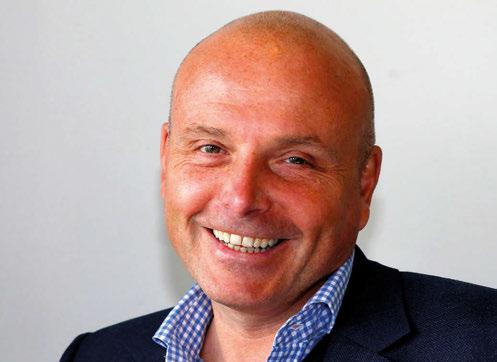
position in that arena are enticing, and obviously the Jockey Club could play a vital role. Perhaps the bigger challenge is dealing with the decline in National Hunt racing.
With both Cheltenham and Aintree in their stable, the popularity and indeed continued survival of jump racing rests to a large degree with the Jockey Club. Falling attendance figures at Cheltenham and Aintree are of great concern but public engagement is not the only issue; it will be high on the priority list for the new Senior Steward and CEO.
As I write, Labour is 40-1 on to assume power in early July. British racing has in the past had extremely strong links with the Conservative party and indeed the lobbying that we were
“There are many links between the sport and traditional Labour values and seats”
able to organise during the levy reform process undoubtedly made a difference in getting to the point we did. With a Labour government, we must in essence start again and build relationships to make our case.
Racing is a vital contributor to the rural economy and there are many links between the sport and traditional Labour values and seats. The new team at the BHA will need to be fully engaged with the new political landscape and look to build strong links between our fantastic sport and the powers that be.
As we head into the summer, racing again faces some big challenges with some key changes to personnel. We must hope that the opportunities that undoubtedly exist can be seized, and we can really begin to build momentum, both financially and engagement-wise.
+44 (0) 207 938 3033
Nicki.Parsons@howdengroup.com www.howdengroup.co.uk
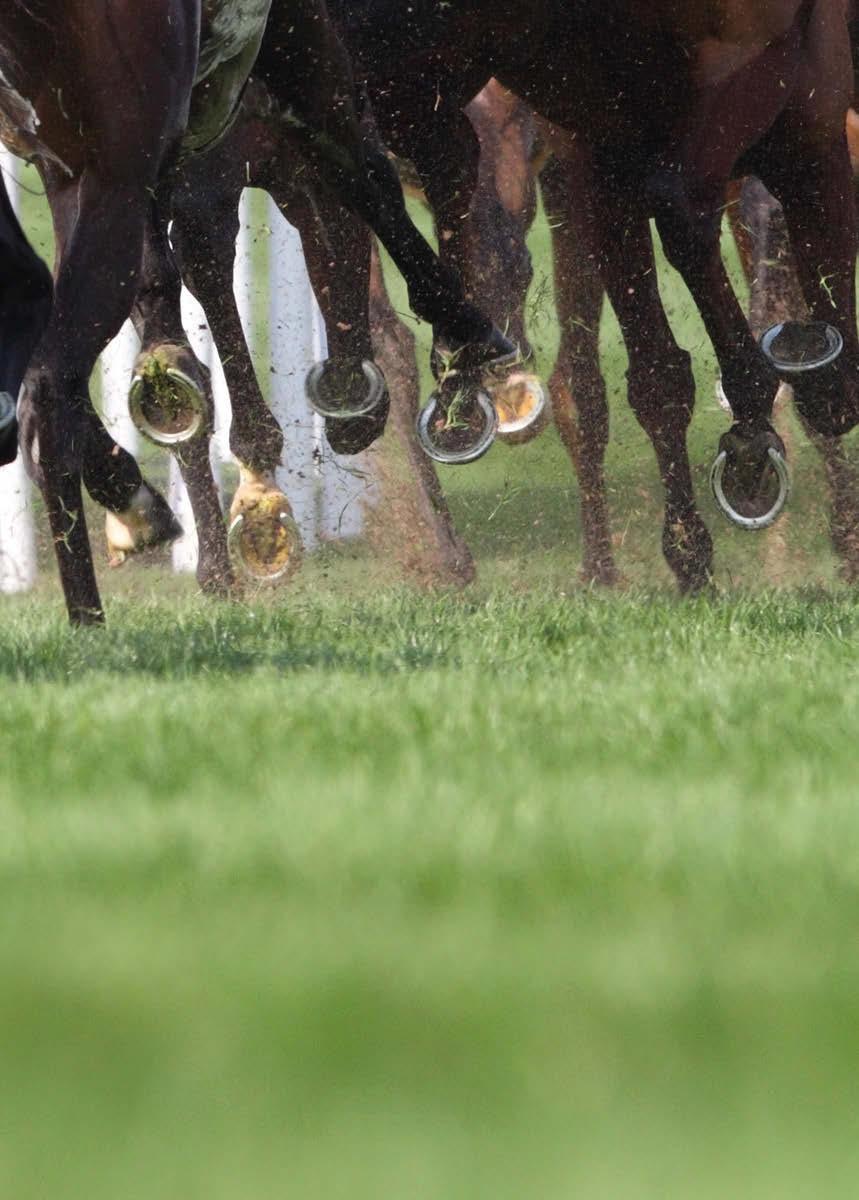
• All risks of mortality
• Theft
• Stallion’s congenital or permanent infertility
• Broodmare barrenness
• Prospective foal
• Foals from 24 hours
• Yearlings unsoundness of wind
• Horse at grass
The problems facing Britain’s breeding and racing industries have been well publicised. The majority view is that they can be cured by more of the one word that rules many lives: money. It would allow increased investment in product, people and participants, with everyone getting appropriate returns for their different risk profiles.
How that might happen occupies many a conversation, some of which lack fact and understanding of the landscape. For example, a Tote monopoly is suggested as the solution. That might have been an argument in 1962, when the Betting and Gaming Act was introduced, if ‘racing’ had seen the full potential and value of its product and taken equity participation, rather than relying on the Betting Levy Act of 1961 for its share of staging the show!
This levy arrangement generated £105 million in 2023-24. Around £3bn is annually bet off course on British horseracing – down from £5.74bn in 2009 – and the capital value of participating bookmakers is a double-digit multiplier of that number. If those who guided horseracing 62 or so years ago had chosen ownership participation rather than a guaranteed income, things could look very different today, even taking into account the increased competition for the betting pound.
A Tote retail offer, owned by the industry, failed to appreciate the potential that high street shops provided, both as an income stream and brand building exercise. It didn’t compete; it didn’t persuade the customer, or for that matter the industry, and therefore did not succeed. Racing can only look to the past and say “if only.”
The next lost opportunity to turn racing’s fortunes came when 1986 legislation allowed TV screens into the main area of betting shops. A consortium of bookmakers spotted the potential, formed Satellite Information Services (now Sports Information Services) and paved the way for today’s in-shop coverage and the racing channels Sky Sports Racing and racecourse-owned Racing TV.
No-one could have foreseen the explosion generated by internet and digital technology, but the industry stood back while the racecourses acquired media rights for a modest outlay. These now generate circa £300m annually, part of which is distributed as prize-money and the rest supports the P&L accounts and balance sheets of the UK’s 59 racecourses. Taken together, levy and media rights income add up to £400m for racing’s product. In comparison, Australia, the current beacon for prize-money, allocates around £450m a year, a not dissimilar sum, which underlines that it’s British racing’s own fault for allowing its future to slip into the hands of those who have interests other than the health and future of the sport.

So, having missed two potentially transformational opportunities, will racing do the same next time? There most certainly will be a next time, and maybe the biggest of all will be part of the British racing programme with global appeal, both from a spectator perspective and a betting option.
World Pool provides both options and in two short years is generating circa £20m from 17 to 18 fixtures alone. That’s onethird of all the Levy Board can make available from the betting industry, and that has been in operation since 1961.
World Pool’s majority customer base is Hong Kong, but there
“A global betting platform in which British racing retains an ownership stake is not just blue sky thinking”
are other countries that may have the same appetite, which needs unlocking and developing. Macau and Singapore are two examples – the first-named has lost its racing industry while the latter will be closed in October – but both have punters demanding live racing and betting. A global betting platform in which British racing retains an ownership stake is not just blue sky thinking.
Additionally, and just as importantly, as AI-powered entertainment grows, consumers still relish the drama of live action and sport has seen its value to media companies soar in the recent past, simply due to the potential value to these platforms. British racing has yet to scratch that surface.
Be assured, then, that help is on the way and the TBA Board alongside the Thoroughbred Group are closely involved, and in some cases leading the way, to explore and deliver these exciting and transformational opportunities in a form that secures the future of British racing in all parts and for all time. Third time lucky, perhaps?
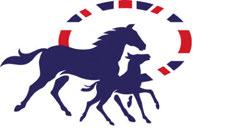
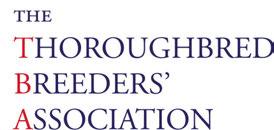
Julie Harrington is to leave her job as Chief Executive of the British Horseracing Authority (BHA) at the end of the year.
During her four-year stint, Harrington has overseen significant changes to the BHA and British racing, including a new governance structure, operational changes at the BHA, and a new ‘people strategy’ with the introduction of the Horseracing Industry People Board.
She said: “With so much now in place to develop and grow the industry strategy, which will secure a brighter future for British horseracing, it felt like the right time to move on and let someone else steer the sport through its next exciting phase.
“It has been a huge privilege to lead the BHA during what has been a period of real change as the sport has developed and implemented shared strategies for a sustainable future, and an ability to speak with one united voice.”
She continued: “I love working in horseracing, it’s an amazing sport to be involved in. I will always be a fan and you can expect to see me at the races in the years ahead.
“I’m proud of the progress the industry has made over the past three years, especially in improving the governance structure, and I hope racing’s stakeholders continue to work together cooperatively to attract new audiences.
“I’m confident that if the sport continues to foster the sense of unity and shared purpose that we have developed


over the past few years then great things can be achieved.”
She added: “Although I took the decision to stand down some time ago, I have agreed to stay on until the end of year to allow a smooth transition to a new CEO.”
Joe Saumarez Smith, meanwhile, will step down as Chair of the BHA at the end of May 2025 and the recruitment process for his replacement has also commenced.
The industry is set to have several new faces walking its corridors of power as it was also announced last month that Nevin Truesdale, Group Chief Executive of the Jockey Club, has asked the Board of Stewards to start the process of finding his successor. It is anticipated he will step down at the end of 2024.
Truesdale, who joined the Jockey Club in 2013, played a key role in leading the petition to parliament against betting affordability checks, which gained more
than 100,000 signatures and led to a debate on the issue.
He said: “The Jockey Club has a unique role; being run solely to invest the money it makes back into our sport. It has been a true privilege and my career highlight to work for and then lead this organisation over the past 11 years.
“Its achievements are down to the world-class people at its heart, without doubt the strongest team the business has ever had. Together we have faced some of the most significant challenges imaginable over the last four years, but our people have remained steadfast in their commitment to help build a thriving sport for the benefit of all.
“Together we have laid strong foundations which will enable my successor to continue to grow the Jockey Club and ensure it continues to invest for the benefit of our sport and the communities it serves.”
Jonathan Neesom, the well-known racing broadcaster who also worked for The Sporting Life and Racing Post, died last month after a short illness. He was 72.
Born in Plymouth and a lifelong Plymouth Argyle supporter, he managed betting shops and was a teacher in London before setting up a point-to-point tipping service.
He first appeared on the original Racing Channel and had been a regular on Racing TV (formerly Racing UK) since it launched 20 years ago.
Neesom also wrote analysis,
close-ups and spotlights for the Racing Post, having started in journalism by compiling point-to-point form for The Sporting Life.
Racing TV colleague Lydia Hislop said: “It’s impossible to encapsulate Jonathan in a few words.
“He touched far more people than he realised, and in his final weeks he was overwhelmed by the kind messages he received from so many.
“For fans of this sport, particularly jump racing, he embodied their passion – an incredibly rare quality to be able to convey. He had that; it came naturally.
“I know this not just because I’ve spent more than 20 happy years standing beside him, revelling in his pithy articulation of exactly what we should be talking about, but also because so many people, even those he didn’t know, have been in touch to ask after him in recent months. Like all of us, they were missing him.”
She added: “His humour, his principles and every single one of his infuriatingly familiar foibles are what I shall miss most. I am so grateful for the time I spent with him and to have been able to call him my good friend.”
Betfred has become the first company to sponsor all five British Classics at the same time, having taken on the 2,000 and 1,000 Guineas relinquished by QIPCO.
In announcing the news, the bookmaker also revealed that a £2 million bonus will be on offer to connections of any horse which wins the ‘Betfred Triple Crown’ – the 2,000 Guineas, Derby and St Leger. The Triple Crown has been won 15 times, but not since Nijinsky in 1970.
As well as backing the 2,000 and 1,000 Guineas in 2025, Betfred will also sponsor an additional seven races across the three days of the meeting at Newmarket.
Betfred boss Fred Done said: “Nobody has ever sponsored all five British Classics and I’m so proud to be the first. I’m honoured as a bookmaker to be supporting the sport I love.
“I want to put the British Classics back where they belong, at the forefront of global horseracing.”
He added: “As the ‘Bonus King’, it seems only right I should offer a bonus. Therefore, I’m offering £2 million to any horse who wins the Betfred Triple Crown.
“It hasn’t been done since Nijinsky and, although Camelot came very close in 2012, it seems about time we were celebrating another Triple Crown winner.”
Amy Starkey, Managing Director of the Jockey Club’s east region, which includes Newmarket as well as Epsom, said: “We have already seen how Betfred’s tremendous enthusiasm and dynamism has elevated the Derby and Oaks, and their passion for racing is fantastic for the sport.
“The offer of this huge bonus for the Triple Crown is another superb initiative and we’re already really excited about how we can promote these iconic British Classic races in 2025.”
QIPCO – the Qatar Investment and Project Development Holding Co. – is relinquishing its sponsorship of the King George weekend and British Champions Series from 2025, in addition to the Guineas races. However, it has extended both its headline sponsorship of British Champions Day and partnership with Ascot to 2026.
David Redvers, Qatar Racing’s Manager and the sponsor’s representative, said: “We wish to
The Leger Legends, the only British charity race for former professional jockeys, will have a new name in its title this year. The event, which will be run for the 15th time over the straight mile at Doncaster on Sunday, September 15, will acknowledge the work carried out by the Injured Jockeys Fund (IJF) to support Graham Lee, who sustained a career-ending fall in November last year.
The race, to be known as the Graham Lee Vickers Bet Leger Legends Classified Stakes, will raise funds for its traditional beneficiaries, the IJF, which celebrates its 60th anniversary this year, and the National Horseracing College (NHC), which was founded 40 years ago.
Vickers Bet will sponsor the race plus a new golf day and gala dinner.
Nigel Brewster, Chairman of the Leger Legends organising committee, says: “We’re very excited by the prospect of building on the excellent fundraising
efforts of previous years with the addition of two new elements – the golf day and the gala dinner.
“While we are always keen to encourage new and additional sponsors, this year’s events are already attracting a lot of support. We look forward to being able to help the two wonderful charities as they continue their great work.”
Some star names have signed up to ride in this year’s Leger Legends race including four-time French champion Olivier Peslier and Cheltenham Gold Cup-winning jockey Paddy Brennan. Tom Scudamore, last year’s winning rider, will be attempting the double.
The raceday will feature a special champagne reception and lunch, with live and silent auctions. Tickets are £170 per person.
The golf day is at Darrington Golf Club, near Pontefract, on Monday, September 2. There will be 18 teams of

concentrate our focus on developing British Champions Day, along with our partnership with Ascot at the royal meeting.
“Their Royal Highnesses Sheikhs Hamad and Fahad Al Thani’s earliest involvement in British racing came with the commitment to helping promote the top tier of the sport. They remain proud of the success of QIPCO British Champions Day – which is a rare innovation in racing.
“In addition to cementing the day’s status in the world horseracing calendar, we’re thrilled to have grown a new, younger audience to attend the races that day, showcasing the sport we have to offer to fans of the future.”
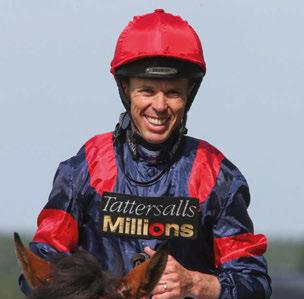
four players each, paying £400 per team, with various prizes along the way and ending with a three-course dinner.
The gala dinner is at the Crown Hotel, Bawtry, including a three-course meal and celebrity panel discussing the Betfred St Leger, compered by Simon Mapletoft. Tickets cost £80 per person.
For further information see https://www.legerlegends.co.uk.

Frederick Larson
Apprentice jockey will be out of action indefinitely after breaking his foot in a fall from a two-year-old at Mick Appleby’s yard.
Newton Abbot
BHA launches an investigation into the deaths of four horses at the track’s meeting on June 25.
Andrea Atzeni
Jockey who relocated to Hong Kong last year will continue to ride in the jurisdiction after a strong first campaign put him fourth in the table.
Robert Cooper
Popular presenter on Sky Sports Racing announces decision to hang up his microphone after 28 years.
Golden Gate Fields
California track stages its last ever meeting on June 9 with a crowd of 5,936 watching on as 83 years of racing came to an end.

Chris Giles
Leading owner will sell nine horses in training, including Grade 1 winner Stay Away Fay, and a broodmare at Goffs’ Summer Sale on July 22-23.
Bryony Frost
A broken collarbone sustained in a fall at Le Lion D’Angers will keep the jockey on the sidelines for a number of weeks.
Today programme
Radio 4 show will not provide daily racing tips except for the biggest meetings in the calendar, ending a tradition that lasted 47 years.
Tim Vaughan
Glamorgan-based trainer handed sixmonth suspended ban and £1,000 fine after Bells Of Peterboro’s positive test for a banned substance.
Harriet Graham
Quits her joint training venture at Stripend stables in the Scottish borders where Gary Rutherford will now train under a sole licence.
Royal Ascot
Attendance over the five days is up by over 7,000 to 273,526 – an increase of 2.8% on 2023.

Victor Dartnall
Calls time on 30-year training career having sent out over 350 winners, taking big prizes with Lord Sam, Russian Trigger and Exmoor Ranger.
Benoit de la Sayette
Young weighing-room star signs up to ride for Clive Washbourn, owner of high-class performers Caius Chorister and Devil’s Point.
Paul Clarkson 71
Husband of trainer Stella Barclay was Director of Racing at Lancashire Racing Stables having previously been a raceday presenter.
Rob Burrow 41
Former rugby player who died after battling motor neurone disease had horses named after him to help with fundraising efforts.
Jonathan Neesom 72
Much-admired broadcaster on Racing TV who also contributed to the Racing Post having previously worked for The Sporting Life

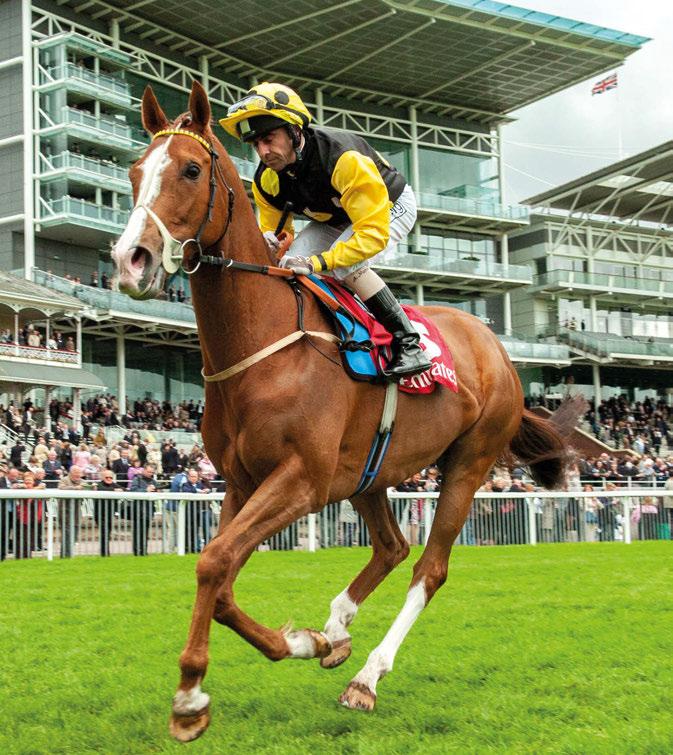
Popular stayer progressed from a handicapper to a Group 1 winner for owner Terry Cooper and trainer Rod Millman, gaining his top-level victory in the Prix du Cadran.
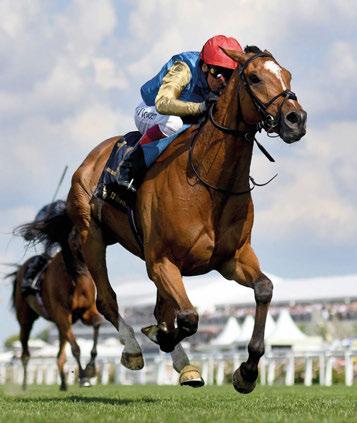
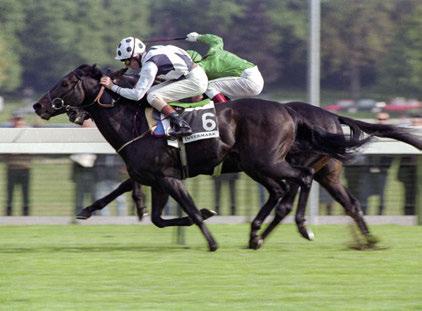
High-class stayer for his breeder Sir David Wills and trainer James Fanshawe, winning the 1998 Prix du Cadran for Richard Hughes.
Ask 21
Dual Group 1 winner went on to sire plenty of jumps winners, latterly from his base at Willow Wood Farm in Cheshire.
Superstar Leo 26
Norfolk Stakes and Flying Childers heroine produced 11 individual winners including Enticing, dam of Group 1 scorer One Master.
Tale Of The Cat 30
Ashford Stud sire produced over 100 stakes winners globally including multiple Grade 1 scorers Gio Ponti and Stopchargingmaria.
Dariyan 12
The Aga Khan’s Prix Ganay winner sired Group 3 scorer Mister Saint Paul and was latterly based at Haras du Mont Goubert.
Gold Cup winner at Royal Ascot last year for Wathnan Racing and John and Thady Gosden is unable to defend his crown due to injury.
Fast Tracker
Wathnan Racing purchases promising three-year-old Churchill colt following his win in a Listed race at Chantilly.
Sayedaty Sadaty
Son of Anodin, fifth behind City Of Troy in the Derby for owner Ahmad Al Shaikh, is sold to continue his career with Australian Bloodstock.
Haatem
2,000 Guineas third and runner-up in the Irish 2,000 Guineas is bought privately by Wathnan Racing ahead of his victory in the Jersey Stakes at Royal Ascot.
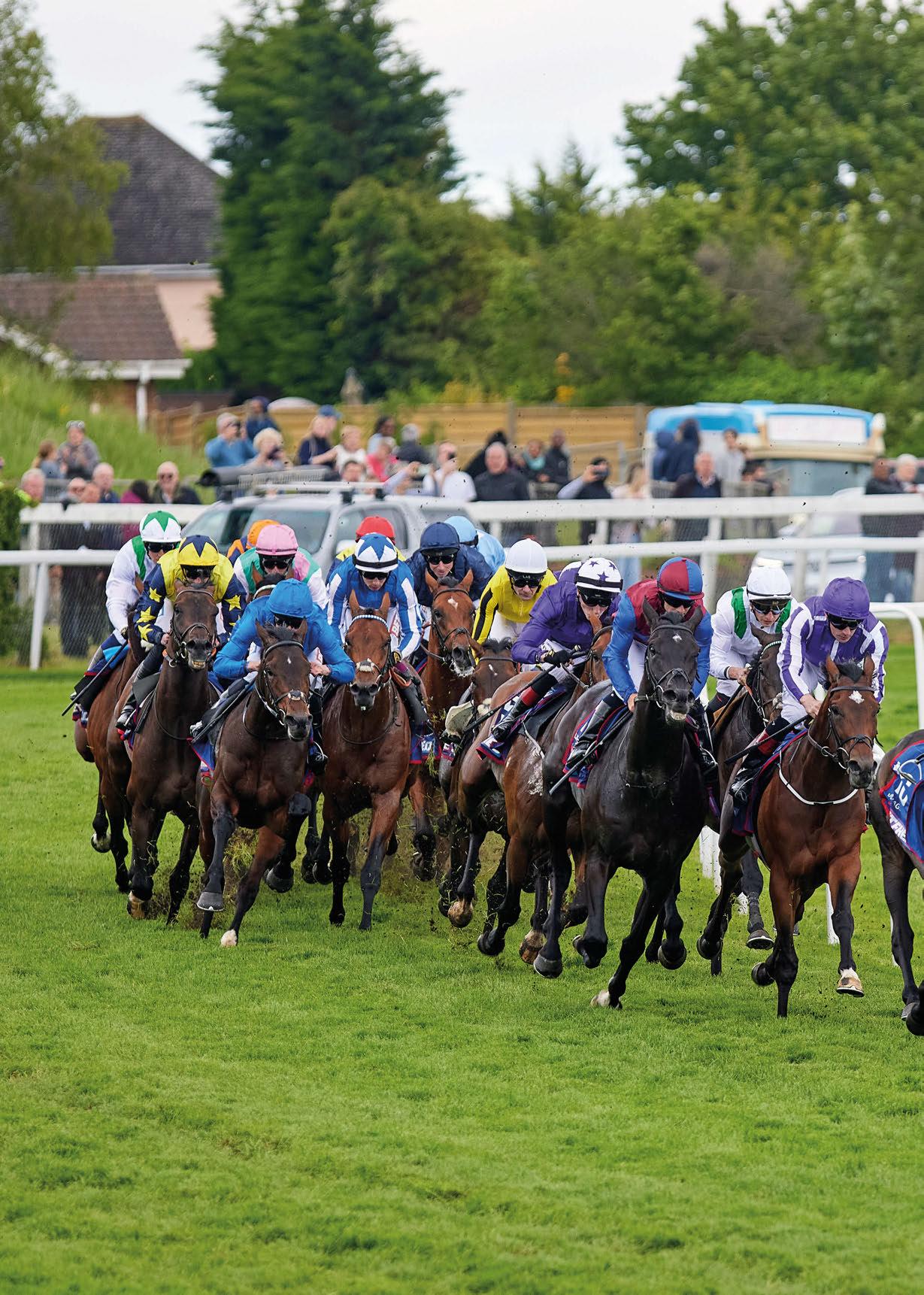

After a lacklustre performance in the 2,000 Guineas, City Of Troy rebounded with a superb victory in the Betfred Derby. Ryan Moore settled the son of Justify towards the rear of the 16-runner field, led by the riderless Voyage at Tattenham Corner (main image), before making stealthy headway in the straight and striking for home two furlongs out, running on strongly to defeat Ambiente Friendly by two and three-quarter lengths. For Moore it was a fourth Blue Riband and a tenth for trainer Aidan O’Brien, while it was the 11th Derby winner to be associated with owners Coolmore.
Photos Bill Selwyn
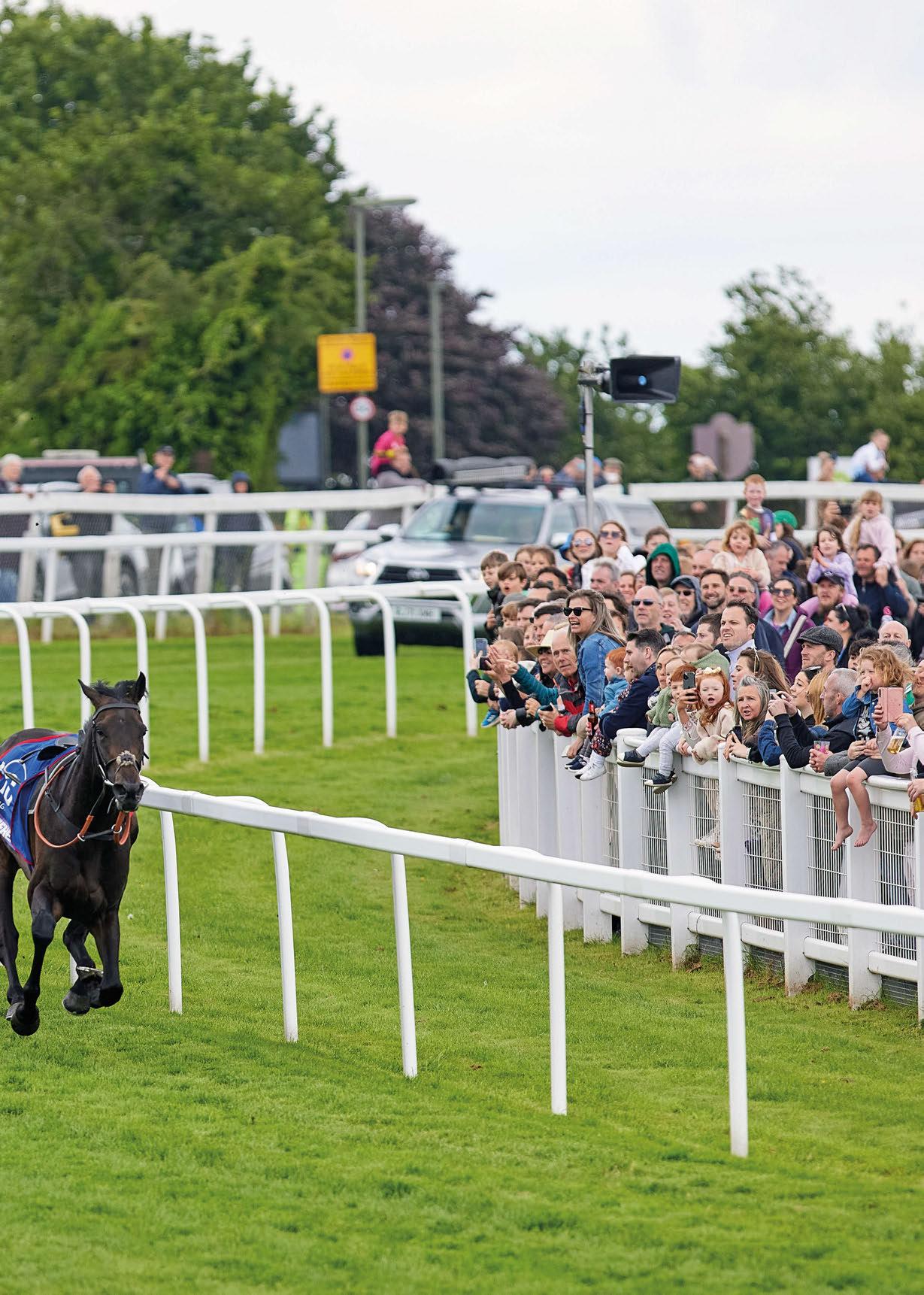
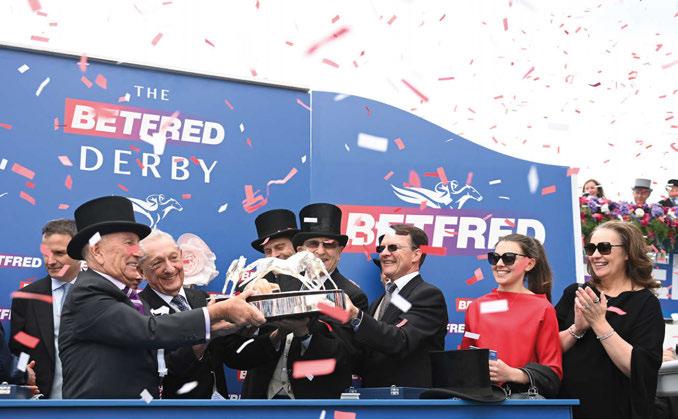
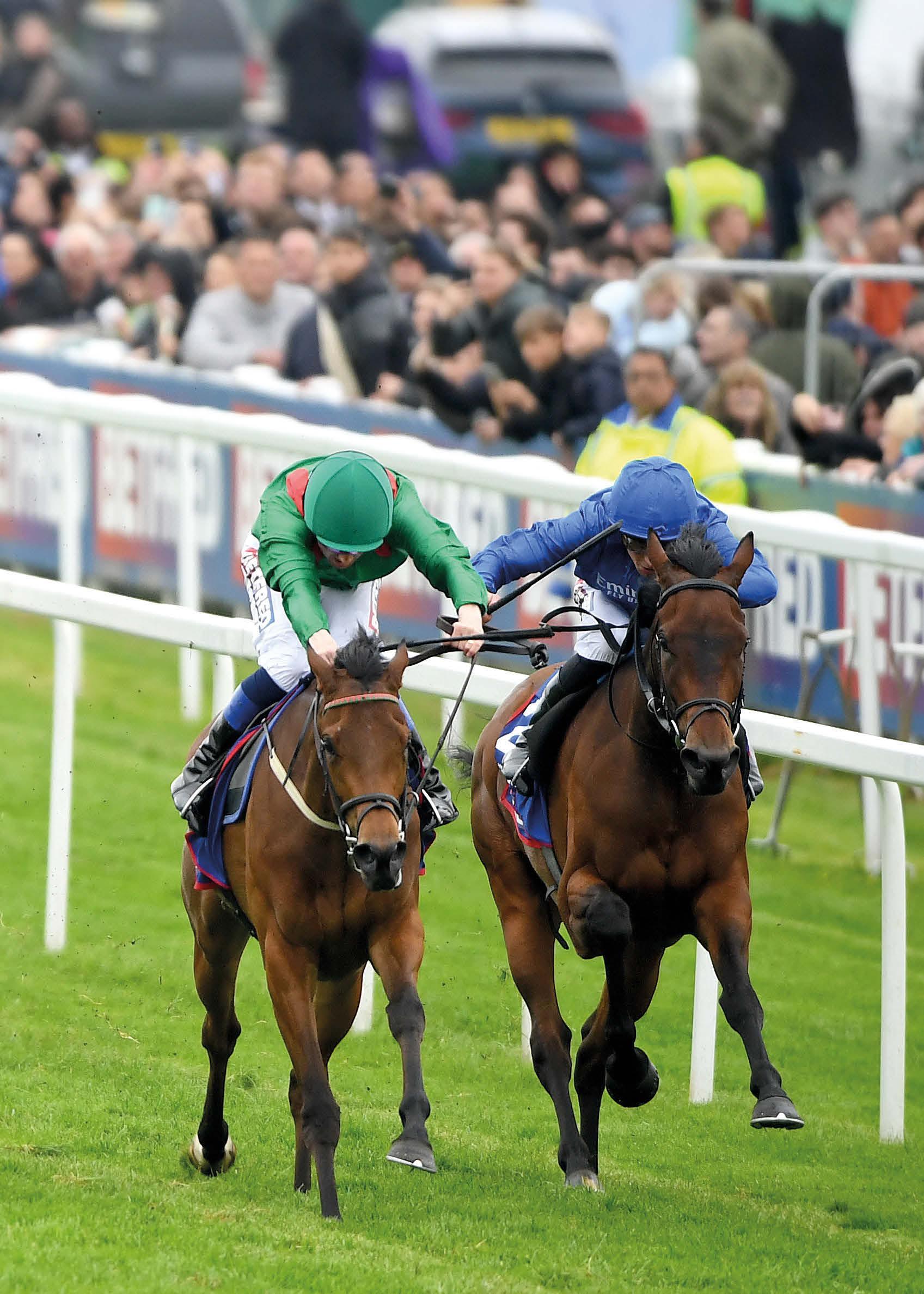
Betfred Oaks
Having captured the fillies’ Classic with Blue Wind in 1981, Dermot Weld had to wait 43 years for his second winner of the Betfred Oaks. Ezeliya (left) was the filly in question, as the Aga Khan homebred outpointed Godolphin’s Dance Sequence under Chris Hayes to give her sire Dubawi his first Epsom Classic triumph.
Photo Bill Selwyn


Sheikh Mohammed Obaid recorded a homebred Group 1 double at Royal Ascot, kicking off with Rosallion’s defeat of Henry Longfellow in the St James’s Palace Stakes under Sean Levey on day one. Fellow three-yearold Inisherin (seen right with his owner, trainer Kevin Ryan and jockey Tom Eaves) made it a week to remember with a decisive victory in the Commonwealth Cup.
Photos Bill Selwyn




Ryan Moore is now the most successful active jockey at Royal Ascot, his six winners this year – all for trainer Aidan O’Brien – helping him overtake Frankie Dettori as his total hit 85. Kyprios (red/black cap) became only the third horse to regain the Gold Cup with a battling defeat of Trawlerman in the 2m4f Group 1 prize.
Photos Bill Selwyn
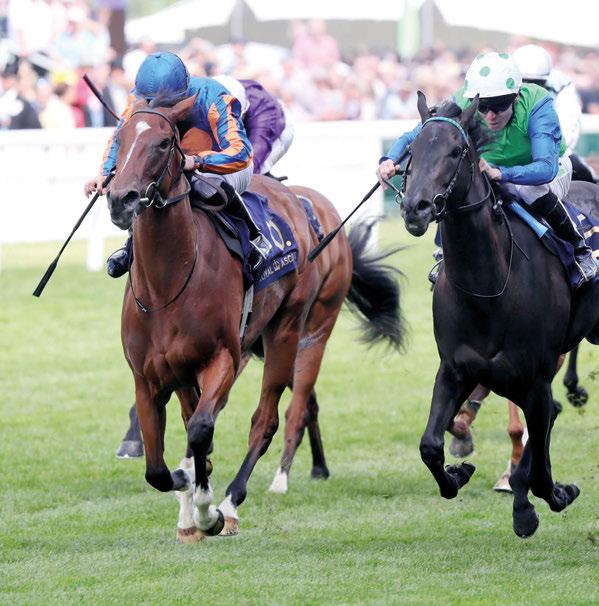
Clockwise from right: Auguste Rodin and Moore proved too good in the Prince of Wales’s Stakes; Port Fairy claimed the Ribblesdale Stakes; Illinois showed his staying qualities in the Queen’s Vase; Fairy Godmother showed a remarkable turn of foot to take the Albany Stakes; Bedtime Story put her rivals to sleep in the Chesham Stakes


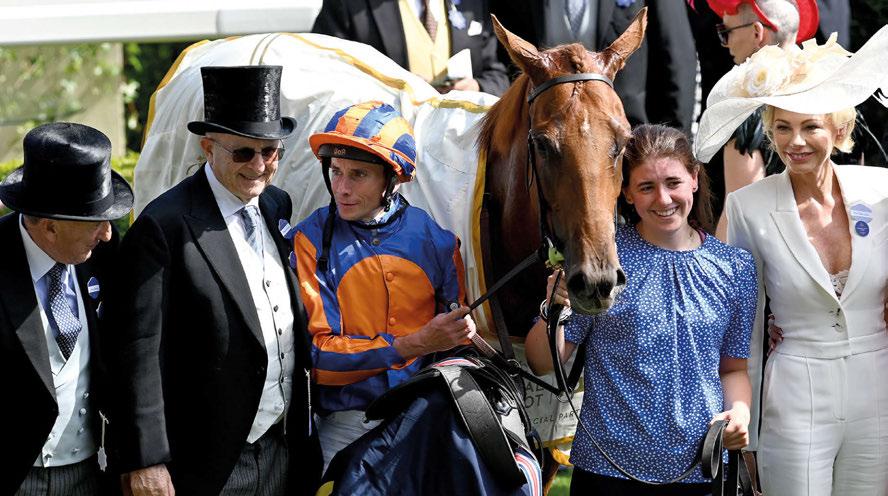
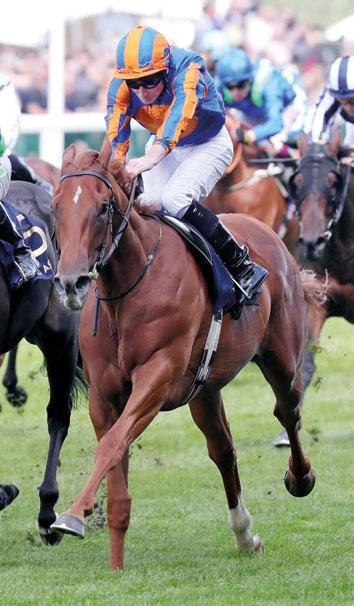
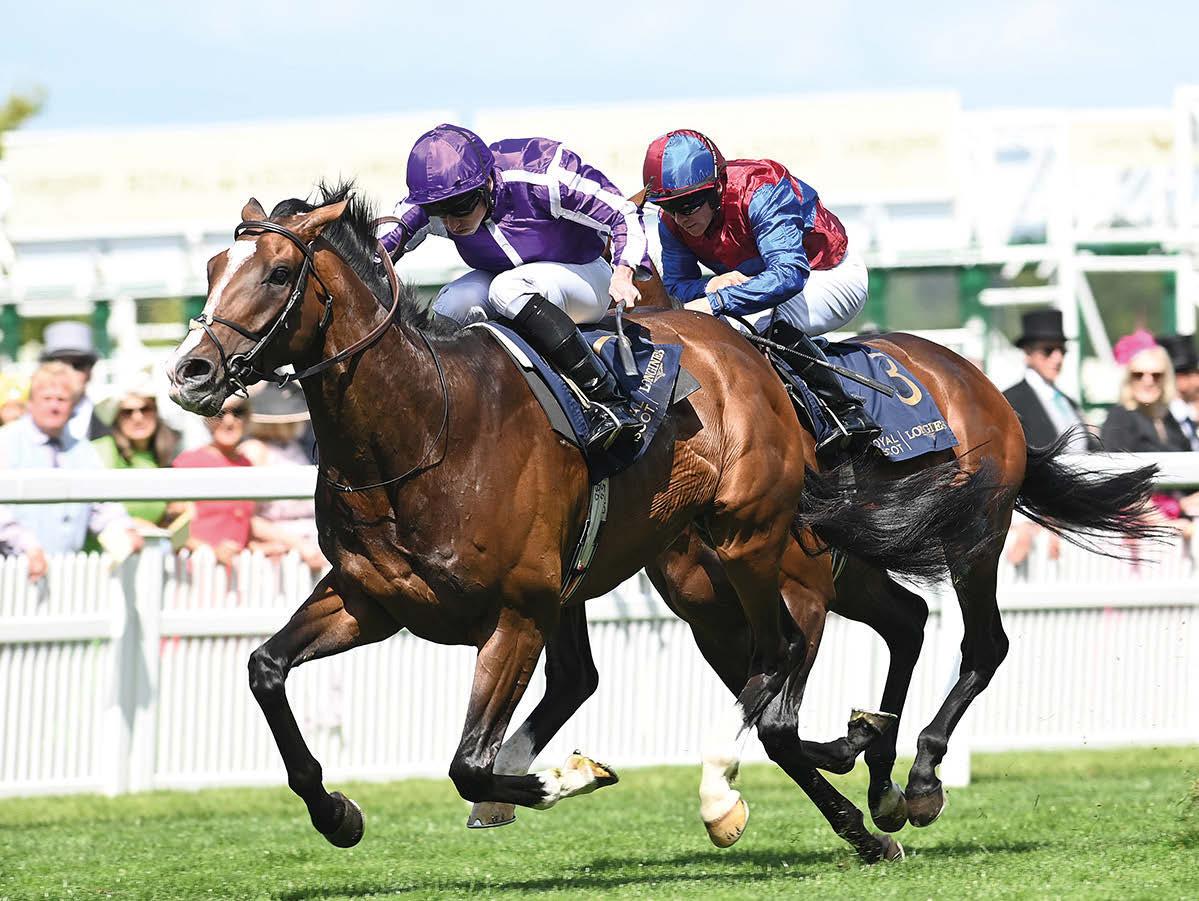
Had things worked out differently, Porta Fortuna would now be racing in the US for her American owners. The decision to leave the filly with Donnacha O’Brien has paid off handsomely, with last year’s Albany Stakes heroine recording a clear-cut success in the Group 1 Coronation Stakes under Tom Marquand.
Photos Bill Selwyn

Foreign raiders: Asfoora was the main challenger from Australia this year and the mare, trained by Henry Dwyer for Noor Elaine Farm, showed why Antipodean sprinters are so highly rated with a thrilling success in the Group 1 King Charles III Stakes under Oisin Murphy; Calandagan (bottom), racing for his ownerbreeder the Aga Khan, produced a sublime performance in the Group 2 King Edward VII Stakes under Stephane Pasquier for the Chantilly stable of Francis-Henri Graffard
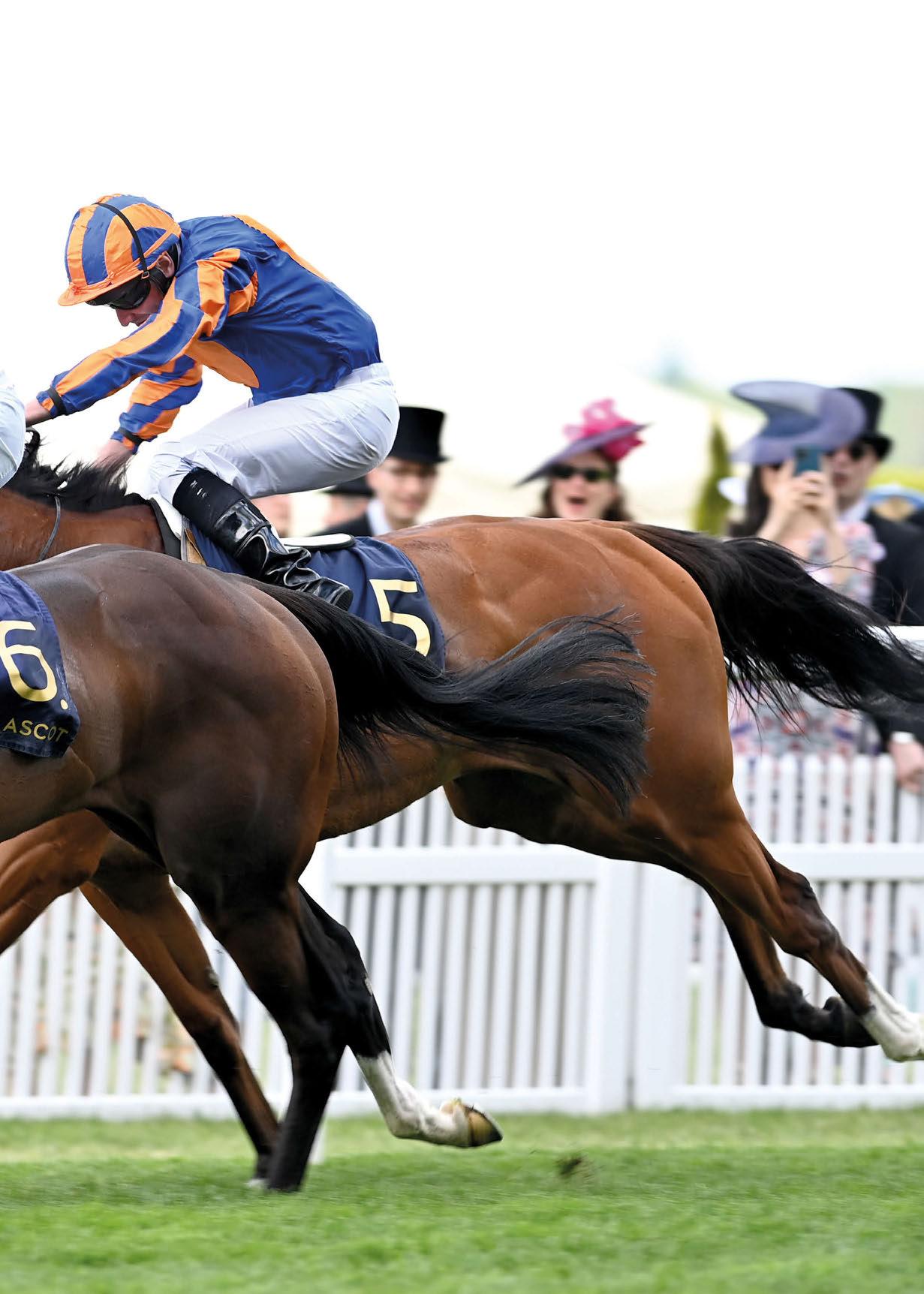




Among those celebrating their first strikes at Royal Ascot was owner and breeder David Howden, a major sponsor at the Berkshire track through his insurance business. Howden certainly enjoyed his moment in the sun as Oisin Murphy steered talented grey filly Running Lion – denied her Classic shot when withdrawn at the start in last year’s Oaks at Epsom – to a two-length victory over Laurel in the Group 2 Duke of Cambridge Stakes.
Photos Bill Selwyn
Clockwise from top: Rashabar (far side) caused an upset in the Coventry Stakes under rising star Billy Loughnane; Dylan Browne McMonagle captured the closing race, the Queen Alexandra Stakes, aboard Uxmal; Ed Bethell and Callum Rodriguez teamed up with Mickley in the Britannia Handicap; Callum Shepherd notched his debut Royal Ascot success when Isle Of Jura, trained by George Scott, romped home in the Hardwicke Stakes
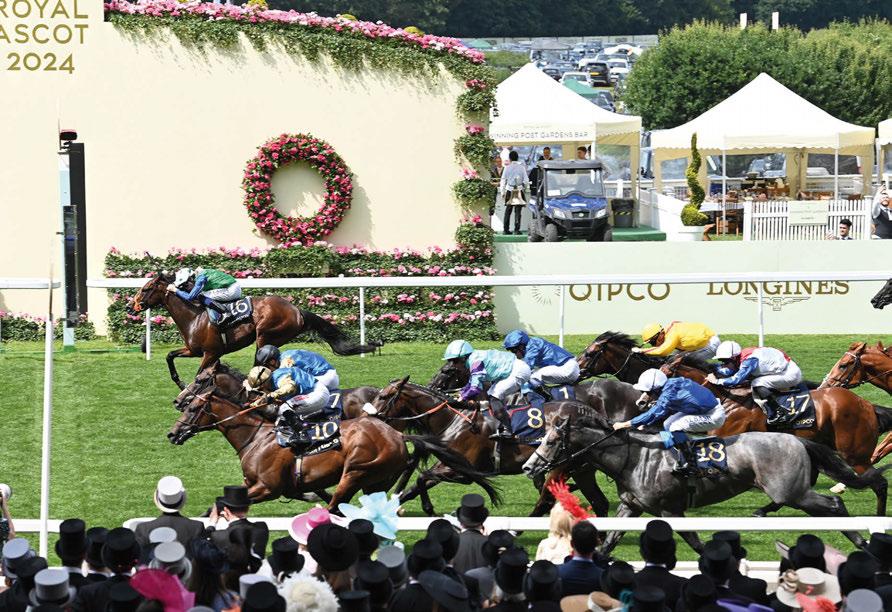
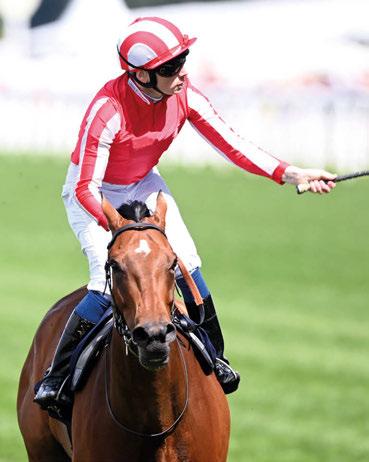
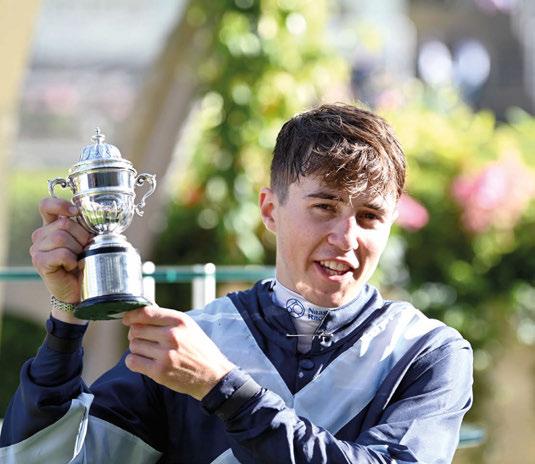
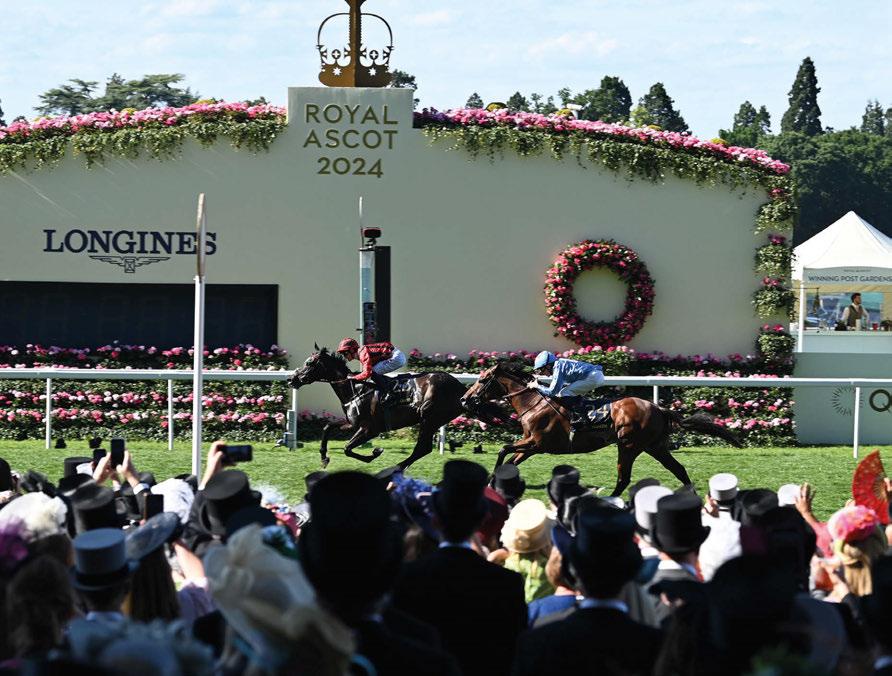

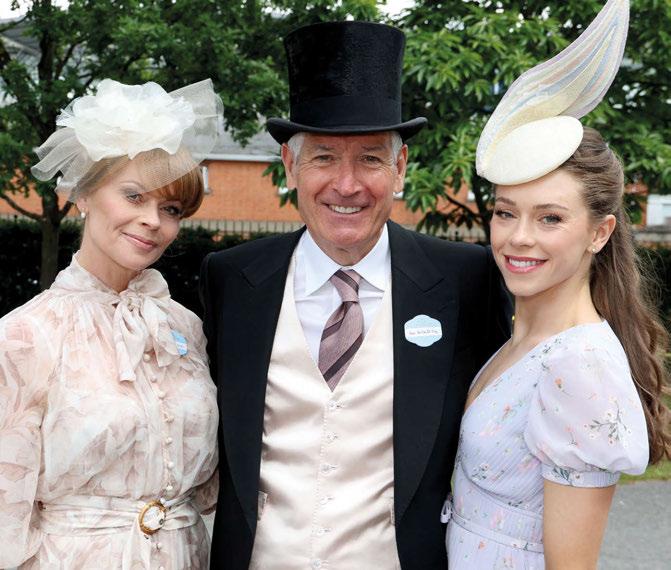


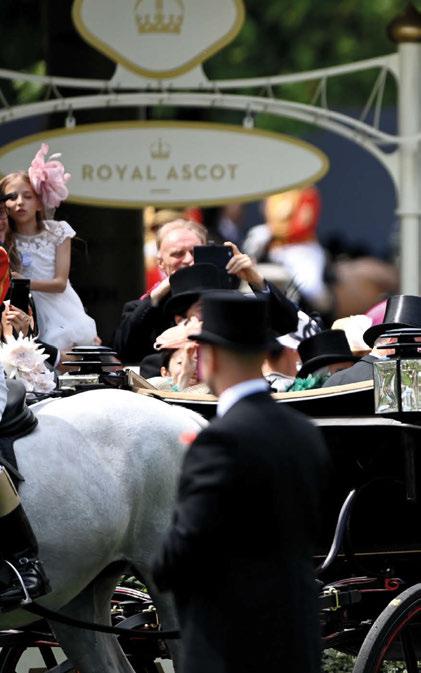







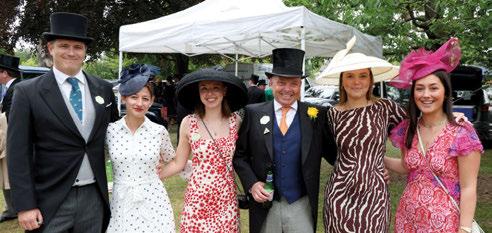
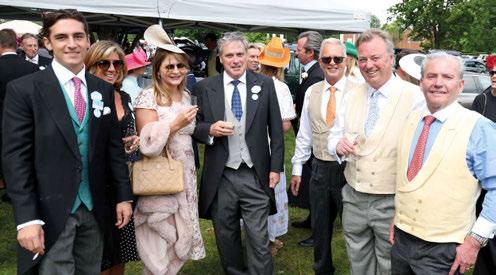










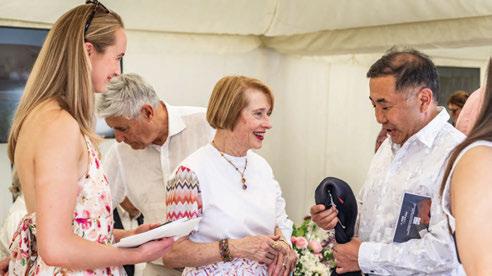





Welcome to South Africa, the New Frontier. It could be a travel guide slogan. It is, however, a rallying call that could tempt British bloodstock interests to open up a fresh, two-way market that pitches trade just below the Middle East heights.
The opportunity arose in late March, when South African Equine Health and Protocols (SAEHP), in conjunction with the relevant government department, announced that the reinstatement of direct exports of registered horses to the European Union had been approved. The new regulations, including specific but not particularly onerous conditions, came into force on May 20, ending 11 years of blight imposed by EU restrictions following an outbreak of African Horse Sickness and eight years of intense, often exasperated lobbying against the ban on unrestricted exports by SAEHP.
Chris van Niekerk, the founding Chairman of SAEHP, his successor David Abery, Managing Director Adrian Todd and champion trainer Mike de Kock deserve huge credit for having led the charge in sticking with the cause, when the end game seemed far away and even local bloodstock personalities threw scorn on the project.
De Kock, who came to international fame through his success from a Dubai winter base, had to travel horses for the best part of

six months to satisfy quarantine conditions. Little wonder his operation went into reverse. “The ban just killed our business, and killed the South African business too, in that we used to get a lot more international buyers,” he explained.
For a period, de Kock also operated out of Abington Place stables in Newmarket, which he persuaded prominent South African owner and breeder Mary Slack – daughter of Harry and Bridget Oppenheimer – to buy. She campaigns a handful of horses in Britain, famously defeating the late Queen with Claymore in the 2022 Hampton Court Stakes at Royal Ascot.
Slack, who with her family firm Mary Oppenheimer Daughters spent billions of rand bailing out the bankrupt racecourse and betting operator Phumelela, also became one of the first overseas owners to be granted a licence to race in Hong Kong, which introduces another element to the campaign against the EU ban.
De Kock nominated Hong Kong Jockey Club Chief Executive Winfried Engelbrecht-Bresges for special mention, describing him as “an administrator of celebrated stature, whose belief in the South African thoroughbred stems from his witnessing the exploits of horses like Variety Club, and was fundamental to his assistance in allowing monies to be assigned to our cause.”
During the period of negotiations, Engelbrecht-Bresges stepped up to become Chairman of the Asian Racing Federation, of which
Sorry, but the award for The Most Witless Promotion in British Racing 2024 has already been won. The trophy, in the shape of a chocolate teapot, goes to whoever dreamed up the Derby draw that took place opposite Wetherspoons in Epsom marketplace 48 hours before the big race.
I say sorry because having moved from one Classicstaging town, Doncaster, to the close proximity of another, Epsom, in 1980, I have a proprietorial interest in the Derby.
The meeting had been an annual destination, covering it for the Sheffield Morning Telegraph from the early 1970s, hence I have witnessed the ups and downs of the event long enough to have developed an affinity that grew even stronger when jobs on the Daily Telegraph and Racing Post meant decamping to the outskirts of Epsom and taking stock of local culture.
Therefore, it was depressing but no real surprise to see even Nick Luck floundering under a flapping gazebo, trying his professional best to whip up interest among a nonexistent crowd, as the Mayor of Epsom & Ewell, with chain but minus tie, and Love Island’s Frankie Foster, with tie, juggled make-shift, numbered ping-pong balls.
Luck has become the busiest international compere and this year alone has presented events in the US, Australia, Saudi Arabia, Bahrain, Dubai, Hong Kong and Doncaster, but this must have been the most despairing. There were more people outside Costa in Gillingham marketplace, watching in the rain as the League 2 strugglers introduced their latest signing in an end-of-May stunt to rival the Derby debacle.
A Facebook flyer announcing the Epsom event, which went out very late, had promised FREE CUPCAKES. Yes, free
cupcakes, in capital letters. Oh dear. No wonder social media heaped torrents of abuse on to the shoulders of Tom Sammes, who having graduated from Bristol University, cut his marketing teeth in golf before joining the Jockey Club as Head of Strategy in September 2021 and then being switched to Epsom as General Manager. He represents the new broom sweeping into the future with relatively late-coming Chairman Brian Finch.
Yet, just a week later, with less public reaction but no less significant, another event in which the racecourse was involved further illustrated Epsom’s disconnect with its local community.
The racecourse hosted an event that culminated in lighting the Downs beacon to mark D Day celebrations, for which another late-run flyer made mention of ‘entertainments, and fish and chips’. Yes, there were entertainments, excellently played out by the Surrey Show Choir and Epsom & Ewell Brass Band, and yes, there were fish and chips – dispensed from the single food outlet that had been opened in the grandstand, where the queue snaked around the hall and ended 40-or-so deep in frustrating hunger.
Infrequent racecourse visitors who missed dinner at home to sample the meal deal would not have been impressed by the food offer. Examples such as this and the woeful promotion of the Derby draw illustrate how much work manager Sammes has to do to get many more people among the local community on side.
No shortage of ideas about how to revitalise the Derby –when was it last vitalised, I ask, because it was already losing
South Africa is a member, so his involvement was not surprising. It should have been expected, but no doubt the canny EngelbrechtBresges also had his eye on the commercial opportunity.
Hong Kong owners had been encountering economic conditions that made it hard to sustain interest in their usual sources of Australian and New Zealand horses. South Africa would provide a more suitable and accessible market, if only easier movement was possible.
While the Hong Kong Jockey Club backed SAEHP financially, its bloodstock spotters kept their eyes, and ears, on the yearling sales, and it was no surprise when, shortly after the first announcement that the direct export ban was being lifted, the HKJC bought four colts at the BSA National Yearling Sale in Johannesburg for a total of almost £400,000.
Despite being rocked on all sides by racecourse failure and betting collapse, alongside the export ban, South Africa has continued to prove it can produce quality bloodstock. In the 2023 Longines World’s Best Racehorse rankings, the country filled nine places between ratings of 119 and 115 in a list of 250.
Horse movement issues will create opportunities both in and out, and thankfully one British institution has already spotted an opening. Tattersalls has specifically targeted the country’s bloodstock interests with direct advertising for its auction of broodmares, fillies and horses in and out of training from 9-11 of this month.
Not only has Tattersalls’ advertising pointed directly to “the recent opening up of direct flights to Europe, which will put the SA industry more in touch with the international scene,” the company has arranged a suggested six-day itinerary, four nights’ subsidised accommodation, assisted airport transfers, and a cashback offer of
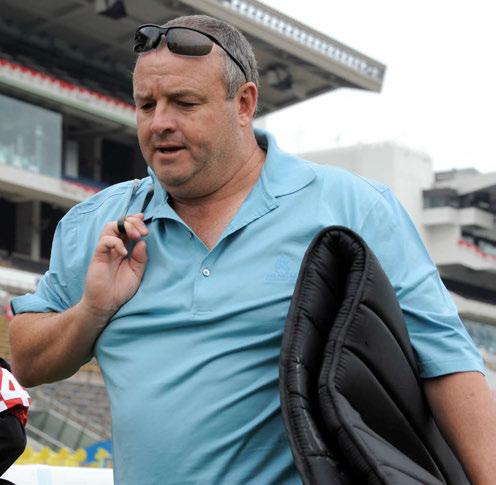
£1,000 to anyone who buys a filly or mare.
Well done, Tattersalls. Now it will be interesting to see what response they get. More significant, though, will be to see whether there is a rush to open up the New Frontier for the general wellbeing of British breeding and racing.

support when shunted off its traditional Wednesday slot in 1995 – emerged in the week of and immediately after this year’s race.
Many were hair-brained, top-of-the-head ruses that had little regard for practicality and came from newcomers to the vicinity of the racecourse or imaginations that would have no
The Epsom management would like the Derby meeting to resonate more with the local community
knowledge of local culture.
Thankfully, the burst of enthusiasm has followed the usual rapid route to social media oblivion. However, for newcomer Sammes and Chairman Finch, the charm offensive begins within a ten-mile radius, and it begins now, not a week or two before the big day in 2025.
In the American horseracing landscape, Kentucky Downs holds a unique place. A turf-only venue situated near the town of Franklin, close to the Tennessee border, the track hosts just seven days of racing each year.
Fuelled by the benefits of an on-track casino, a feature of many racecourses in the States, the prize-money offered at Kentucky Downs is simply phenomenal, especially for victorious Kentucky-breds owing to the valuable premiums offered.
The purses available certainly caught the eye of Alex Cole, Racing Manager to owners Dr Jim and Fitri Hay. The Hays have horses all over the world, including Britain, where last month their gelding Khaadem recorded his second successive win in the Queen Elizabeth II
Jubilee Stakes at Royal Ascot.
Khaadem took home
£567,000 for his efforts in the Group 1 sprint, a superb pot by UK standards. By contrast, the same owners’ Ancient Rome – a stable companion of Khaadem’s at Charlie Hills’ Lambourn stable – pocketed £980,000 after taking the Grade 3 Mint Millions Stakes at Kentucky Downs in September.
Cole explains: “Ancient Rome was based in France with Andre Fabre when I noticed that he was a Kentucky-bred. Fabre couldn’t seem to get the best out of him for whatever reason, so he was brought over to Charlie. I told Charlie the plan [to target a race at Kentucky Downs] and unlike most plans in racing it worked out.
“Kentucky Downs has always been on my radar, mainly because it’s a track that
really doesn’t suit US horses. It’s undulating, they start uphill, there’s a camber and then they come downhill. The Americans are used to flat ovals.
“A big factor in Ancient Rome winning over there was Jamie Spencer. He didn’t panic at any stage – he knows how to ride tracks like Goodwood and Epsom. Jockeyship does play a big part.
“The premiums available for Kentucky-breds was very much part of the thought process. I won’t tell you how much it cost to get there, but it paid off.
“Ancient Rome is a War Front horse bred in Kentucky by Coolmore. I don’t think you could send a Kodiac or a Galileo as they wouldn’t enjoy the benefits of the state premiums.
“You need the right horse and Ancient Rome was the right horse; Group 1-placed at two and fourth in a French Guineas. He’s a solid Group 2/ Group 3 horse that handles fast ground.”

Ancient Rome and Jamie Spencer (pink/green) land a huge pot in the Mint Millions Stakes
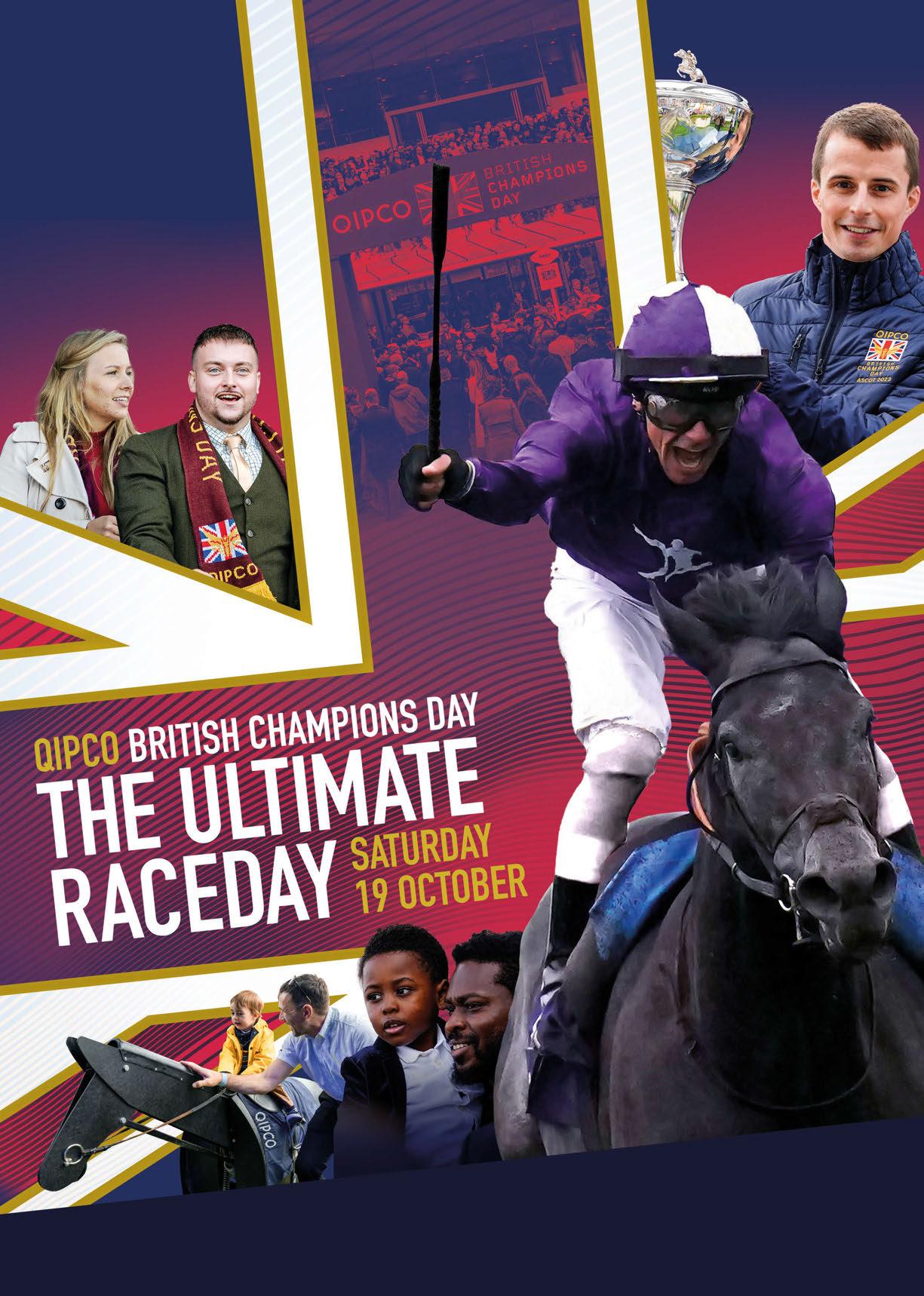
£4 MILLION PRIZE MONEY ENTRIES CLOSE 12PM TUESDAY 6 AUGUST
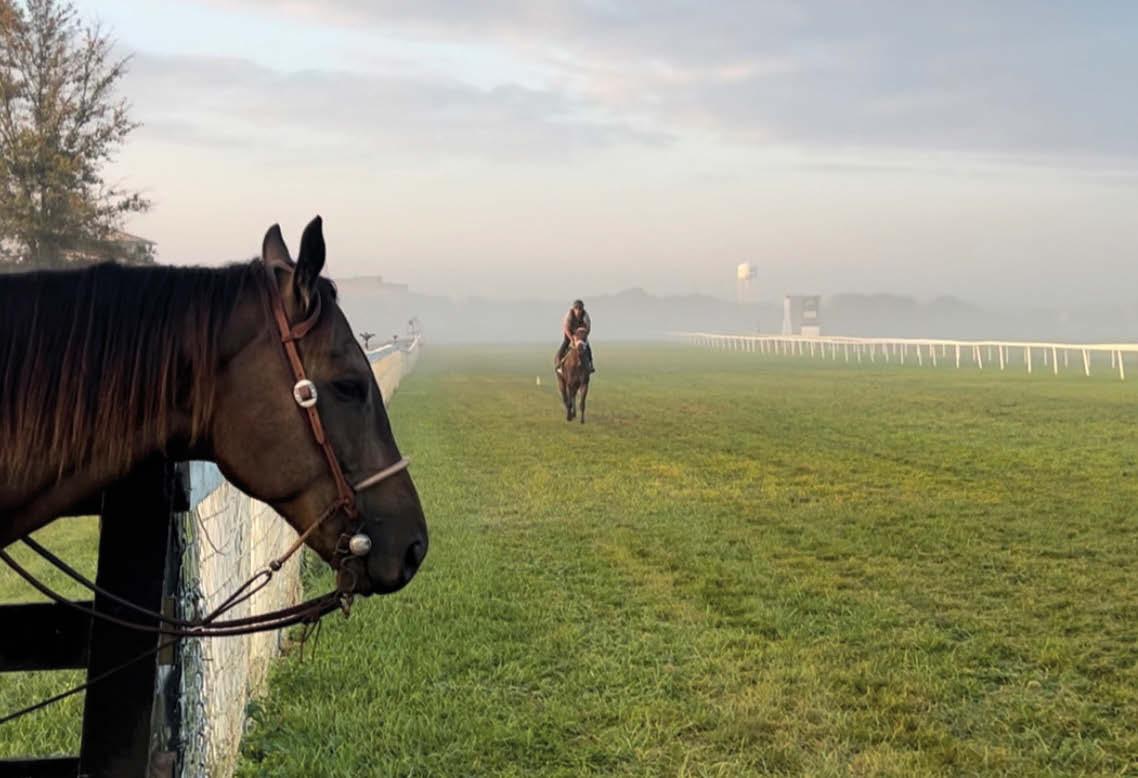
Ancient Rome will head back across the Atlantic later this year and try to repeat his heroics, when he is likely to be joined at Kentucky Downs by the Wesley Ward-trained juvenile Saturday Flirt, purchased by the Hays from her trainer and last seen finishing unplaced behind Shareholder in the Norfolk Stakes.
Not only are the prize funds impressive but the location and setting provide further reasons to race at Kentucky Downs.
“It’s a fantastic place about an hour outside Nashville,” says Cole. “And they don’t give out crappy trophies – the Hays received a signed guitar from country music star Tanya Tucker, which was pretty cool.
“What happened last year was wonderful, but to give the horse his due he also won a valuable handicap at Goodwood in his warm-up. There is prize-money at the good tracks in Britain. But you have to think outside the box.”
Rick Hammerle, Racing Secretary at Kentucky Downs, is looking forward to welcoming back Ancient Rome along with other European runners for this year’s racing season, slated to run from
August 29 to September 11.
The track, which is owned by Ron Winchell and business partner Marc Falcone, is “unique in the US” according to Hammerle.
He says: “We have dirt-only and synthetic-only meets, but this is the only one exclusively staged on turf.
“The Hays received a signed guitar from country star
Tanya Tucker”
“The layout of the racetrack is like nothing else in the States. It’s a mile and five-sixteenths; I’d describe the shape as like a lightbulb. There’s a big, wide turn and then they come down a long, almost quarter-mile stretch.
“There’s a casino on the property and in short, some of the money that comes from the casino goes into a fund, the Kentucky Thoroughbred Development
The course at Kentucky Downs is European-style in its design
Fund (KTDF), which is earmarked for purses and to improve the Kentuckybred brand.
“If you only race for seven days each year, you can put up much bigger purses. It’s a destination for anyone with a good turf horse.”
Hammerle says the track’s owners are keen to preserve the special atmosphere at Kentucky Downs, which has proven so popular with racing professionals and the public alike.
“Ron and Marc took over six or seven years ago and they’ve taken it to the next level,” Hammerle says. “In a small town, Franklin, Kentucky, it has that country fair-type atmosphere.
“People sit at picnic tables for the races while there’s only one indoor chalet that acts as a club house. That’s the beauty of it.
“It’s about 30 miles north of Nashville, which is where most people fly into. It’s the capital of country music and we encourage owners to explore Nashville and have some fun down there.
“We started to give away guitars as trophies for some of the bigger races –it’s been a big hit, as we ask country music stars to sign them. There’s no tin cups here!”

The Emir of Qatar’s Wathnan Racing may be in its youth yet a focus on quality bloodstock and some big results in important races has ensured its silks are already well known on the European stage
Words: James Thomas • Photos: Bill Selwyn
Little was known about Wathnan Racing in early May 2023. But within the space of six weeks and only three runners, the operation went from unheralded newcomer to emerging force.
No purchase prices were ever made public for Isaac Shelby, Courage Mon Ami or Gregory, but given the colts’ elitelevel credentials, it was safe to assume significant sums changed hands.
Securing blue-chip prospects right before major races was a bold strategy, but the magnitude of their results more than justified the means.
Isaac Shelby went down by a short neck to Marhaba Ya Sanafi in the Poule d’Essai des Poulains, giving Wathnan a Classic placegetter with their very first runner in Europe.
At Royal Ascot Courage Mon Ami went one better when registering a famous victory in the Gold Cup, while Gregory annexed the Queen’s Vase. Both winners were trained by John and Thady Gosden and ridden by Frankie Dettori. As starts go, this looked particularly auspicious.
Qatar, Sheikh Tamim bin Hamad Al Thani. The Emir is not only an important, and extremely wealthy, international figure but he hails from a family with strong links to racing. His brother, Sheikh Joaan, is the principal of Al Shaqab Racing, owner of top-notchers like Olympic Glory, Shalaa and Treve. The siblings are cousins of Sheikh Fahad of Qatar Racing, whose silks have been carried by Group 1 winners such as Kameko, Roaring Lion and Simple Verse. And the roots laid down by Sheikh Joaan and Sheikh Fahad run much deeper than simply owning strings of racehorses, as both have developed extensive bloodstock portfolios. The former operates out of Haras de Bouquetot in Normandy, while the latter is invested in the broodmare band and stallion division of Tweenhills in Gloucestershire.
“To deliver four winners at Royal Ascot has to be a source of satisfaction”
The Emir has a history of significant sporting involvement as he bought Paris Saint-Germain football club through Qatar Sports Investments in 2011, also overseeing his homeland’s successful bid to host the 2022 FIFA World Cup.
The Royal Ascot brace inevitably prompted questions about Wathnan’s future involvement in racing. Was this a flash in the pan or were we witnessing the seeding of an empire?
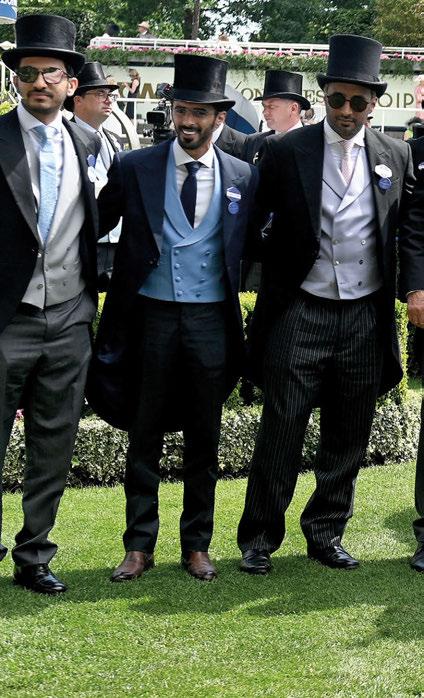
in Godolphin’s expansion into Australia, and its management in Japan and the US.
Tait turned to Richard Brown, a founding partner of Blandford Bloodstock, to act as racing advisor, as well as boots on the ground at European auctions.
Both have tended to play questions about Wathnan’s future plans with a straight bat, simply saying the brief from Qatar has been to “produce a team of horses the Emir and his family can be proud of and can enjoy.”
But actions always speak louder than words, particularly on the Turf, and the bare facts relay that in just over 12 months Wathnan have developed into a significant player. The point was hammered home in no uncertain terms at this year’s Royal Ascot.
As momentum gathered, more details began to emerge. The picture became clearer in the aftermath of the Gold Cup when it was revealed that the owner behind the Wathnan brand was the Emir of
This time around the squad numbered 28. Even more remarkable than the rise in runners was the fact that Wathnan registered an impressive tally of four Wathnan
The operation’s senior representative is Olly Tait. The owner of Twin Hills Stud in New South Wales was an influential figure
The steep upward trajectory is illustrated by the number of runners at the meeting. In 2023 there were just three, with Courage Mon Ami and Gregory joined by Isaac Shelby, who ran a creditable fourth to Paddington in the St James’s Palace Stakes.

winners. For context, only Coolmore had more.
Leovanni initiated the four-timer with a decisive strike in the Queen Mary Stakes, before a day three brace saw the exciting Shareholder claim the Norfolk and English Oak run away with the Buckingham Palace Stakes. The haul was completed when Haatem gave weight and a beating to 18 rivals in a deep renewal of the Jersey Stakes.
Brown, who has been responsible for sourcing the vast majority of Wathnan’s runners, says his overriding emotion in the aftermath of Royal Ascot was relief, before continuing: “That turned into quiet satisfaction for the whole team surrounding Wathnan, and particularly for the Emir and his family. We’ve been given an extremely good opportunity to work with top people and top horses. To deliver four winners, and lots of the other horses ran well as well, has to be a source of satisfaction.”
As well as four winners, Wathnan also had Electrolyte and Columnist fill the places in the Coventry Stakes, as did Haunted Dream and Torito in the Wolferton; Native Warrior headed up the near-side group when third in the Britannia;
Space Legend was runner-up in the King Edward VII Stakes; while Dark Trooper ran a huge race to finish second of 25 in an ultra-competitive Wokingham Stakes.
These results were not achieved by chance, as Wathnan have invested heavily in recent months. Brown mined the European breeze-up sales for juvenile talent and duly unearthed two winners in Leovanni, a £190,000 Goffs UK purchase, and Shareholder, a €460,000 acquisition from Arqana. Columnist and Electrolyte also came from the two-year-old sales and cost £170,000 and £220,000 respectively.
The dozen or so breeze-up recruits were joined by a similar number of bluechip horse-in-training purchases. This group included the progressive English Oak and Haatem, who earlier this season won the Craven Stakes and reached the places in both the 2,000 Guineas and Irish 2,000 Guineas.
Investment doesn’t guarantee results, particularly in an arena as unpredictable and competitive as Royal Ascot, even if it does increase pressure. Owners can spend heavily or they can invest wisely, but the key to success is doing both.
“There’s only one certainty in our sport
and that’s that there are no certainties,” says Brown. “Even with the team we’d assembled, that didn’t guarantee anything. You hear all these horror stories of people with unbelievable teams struggling, so I was completely aware that we might not get a winner. We’d been given a clear remit to try and produce horses that can be competitive at the meeting. So, if you’re not competitive at the meeting, then it means you’ve failed.”
We will never know what might have been had Courage Mon Ami and Gregory failed in 2023, but if their success helped pave the way for the team assembled this year, it is hard not to wonder what the future might hold after another four winners.
Although there is a firm focus on the royal meeting, Brown stresses their purchasing strategy is underpinned by a much longer-term view. “Courage Mon Ami wasn’t bought to win the Gold Cup, much like the horses this year weren’t bought just to win those races,” he says. “They were bought to be good additions to the team.”
The team now numbers close to 50 horses in training in Britain, spread among 16 different trainers. There are six trainers
›› in France with Wathnan-owned horses in their stable, while the Willie Mullins-trained Lope De Lilas was also among the raft of recent private purchases.
There is a pleasing range among the trainers based in Britain, thanks in large part to a policy of leaving their acquisitions with existing stables. This has seen the likes of Adrian Keatley, Eve Johnson Houghton and Ollie Sangster saddle Wathnan runners, as well as the more familiar names of Gosden, Haggas and Beckett.
Northern trainers such as Karl Burke and Richard Fahey have also received the backing of Wathnan, as have younger names like Archie Watson and Tom Clover.
Wathnan’s arrival in Britain can only be seen as a vote of confidence, not only for the trainers they employ but the sport at large. Their support is a particularly welcome development given a lack of fresh investors is among the sector’s many challenges.
“The investment that we’re seeing in our sport is tremendous,” says Brown. “It’s well documented that prize-money in Britain isn’t at the level that any of us would like, but suddenly someone new has come in and invested to these levels – it’s good for everybody.”
The yearling sales at Tattersalls have
already benefitted from the operation’s presence, and the youngsters picked up there could potentially take Wathnan to the next level. The bloodlines among the dozen would entitle any owner to dream
“Someone new has come in and invested to these levels – it’s good for everybody”
big, especially with the group having been spread between the Beckett, Gosden and Haggas stables.
The purchases include Wicked, a 600,000gns Kingman sibling to Magna Grecia and St Mark’s Basilica; Magnetite, a 575,000gns Frankel brother to Elarqam out of Attraction; Dunamase, a 500,000gns Kingman brother to Age Of Kings; and Fitzmaurice, a 470,000gns Wootton Bassett brother to Chindit.
The team’s Arqana August Sale recruits include the €950,000 Subsidence, a son
of Frankel and Via Pisa; a €660,000 Night Of Thunder three-parts brother to Arabian Crown named Orageux; and Cerelia, a €410,000 filly by Wootton Bassett.
“They’re all well bred; we’ve bought some Frankels, some Kingmans, horses who’ll hopefully be summer two-yearolds and go on and be middle-distance horses next year,” says Brown. “That was the type we were looking for, which is why the breeze-up concept that Olly and I proposed to the team complemented the yearling buys. All the dreams are still alive at the moment.”
It is understandable that Wathnan’s spending habits have drawn attention, but Brown emphasises that the team have not been given a blank cheque to buy everything on their shortlist. Brown illustrates the point by saying through gritted teeth that one of the ones who got away went on to win at Royal Ascot. He declines to give a name.
“There’s been plenty [of horses in training] we either haven’t been able to buy or we’ve decided not to buy because they’ve cost too much,” he says. “We’d have bought less than 50 per cent of the horses we bid on at the breeze-ups and even less than that at the yearling sales.
“We’re very careful with our valuations and if the horses go beyond the valuation

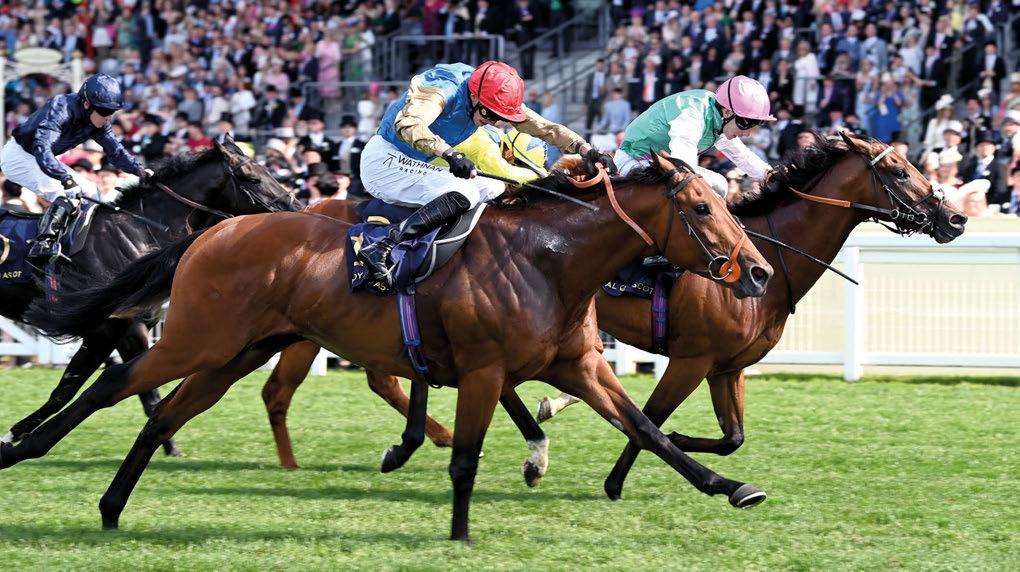
then we’ll stop. We either get the horse or we walk away, those are the two options. And we’ve walked away from a great deal.”
While it may not be acknowledged

publicly, at least not directly, there is a weight of evidence that suggests Wathnan is laying the foundations for something altogether more permanent. This goes deeper than just a purchasing strategy.
In October the operation announced that James Doyle would leave his role with Godolphin to become Wathnan’s first retained rider at the start of 2024.
“Having horses in different places, it was going to be important to have some continuity, and also going into big meetings we wanted to ensure that we had the services of a world-class jockey,” says Brown. “I’ve always been a huge fan of James’s.
“I knew he was the man we wanted –we were absolutely delighted to get him. He’s a world-class jockey, a world-class bloke and his feedback is absolutely world class. He’s an incredible addition to the team.”
Wathnan’s presence in Britain has also been boosted by the arrival of Hamad Al-Jehani, a leading trainer in Qatar who is overseeing a select string from the lower yard at Kremlin House Stables in Newmarket. Al-Jehani, who landed last year’s Qatar Derby with the Wathnanowned Jeff Koons, only saddled his first British runner in mid-May, but has already been represented at major festivals. Beshtani finished second in a valuable Epsom handicap on Oaks day while Haunted Dream chased home Israr in the Wolferton Stakes.
“To have a second at Epsom and a
second at Royal Ascot, he’s made an incredible start with only a tiny number of horses,” says Brown. “He’s brilliant to deal with and a superb horseman. I’m sure that number will grow organically; this year was just about him coming over and getting a feel for it. Training in Newmarket is very different to training in Qatar, but he’s grasped it pretty quickly from the look of things.”
Brown’s talent search has not been exclusive to Wathnan’s runners, with Tommy Allen recruited as Al-Jehani’s assistant. “The two key things to get right were a yard and an assistant,” says Brown. “Tommy is a very talented young guy, so he was somebody we were keen to get, and he came very highly recommended by George Boughey. Hamad and Tommy seem to get on like a house on fire and they seem to be working really well together. I think the results on the racecourse show that.”
There is also a wider support team involved in managing the growing Wathnan string and identifying new recruits. This includes Brown’s Blandford Bloodstock colleagues Tom Biggs, Stuart Boman and Tom Goff.
“It’s a unique opportunity and we’re just grateful that Olly recommended us, and that the team in Qatar listened to that recommendation,” Brown says. “We’re taking that responsibility very seriously, and I’m lucky that I’ve got a big team who bring lots of different opinions and thought processes into it.”
Resources – be that financial, human or equine – are one thing, but participants also require the temperament to handle the inevitable lows, as well as the highs.
Wathnan’s results at last year’s Royal Ascot could so easily have given a newcomer a skewed perspective on how easily success can be attained. However, Brown says the team’s competitive spirit is counterbalanced by the kind of pragmatism that goes a long way when it comes to racing thoroughbreds.
“The key thing is the Qatari representatives that have come over have always said we win and lose together,” he says. “They’re absolute gentlemen and they’re sportsmen, so they understand it’s a sport.
“Of course, we had some real disappointments at Royal Ascot but they took those equally as well as they took the victories. With every operation racing multiple horses, there’s enormous investment gone in. Whether you’ve bred them, bought them at public auction or a bit of both, it guarantees absolutely nothing. And that’s not lost on them.”
Only time will tell what Wathnan’s next move will be, although one logical step would appear to be establishing a breeding programme. The operation already has two bona fide Flat stallion prospects in Shareholder and Haatem, while its fillies include two Queen Mary winners in Crimson Advocate and Leovanni, as well as the recently retired Remarquee, winner of the Fred Darling Stakes and runner-up in two Group 1s.
“There is the option of breeding,” says Brown. “But the breeding season is still
For all Wathnan Racing’s statements of intent, arguably none resonated with followers of the sport quite like the appointment of James Doyle.
The leading rider spent ten years with Godolphin but decided the time was right for a new challenge when Olly Tait and Richard Brown reached out with a proposal to ride in Wathnan’s red, blue and gold silks.
“I had to slightly take on trust a lot of what Richard and Oliver were telling me,” Doyle says as he reflects on the initial approach. “They said this is the start of what will be a very exciting journey going forward. Luckily I’ve known Richard for quite some time now and he’s a good friend. It’s still early days in this role but it’s great to roll forward out the back of Royal Ascot, where we had four winners and 28 runners. That really backs up what Richard and Oliver said.”
Doyle is no stranger to high-profile roles, as he was also Juddmonte’s retained rider prior to his job with Godolphin. When Brown put a prospectus together to send to the team in Qatar, Doyle’s list of Group 1 winners ran into three pages. This experience stood him in good stead heading into the pressure cooker environment of Royal Ascot.
“I’m lucky in the sense that with Juddmonte and then going to Godolphin for a number of years, Royal Ascot has always been a high-pressure

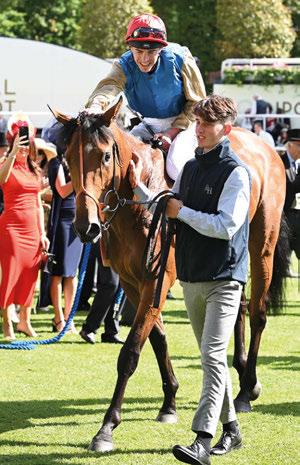
Doyle was aboard all four of Wathnan’s winners at this year’s royal meeting, and he is understandably looking forward to getting back on the likes of English Oak, Haatem and Leovanni. He says that Shareholder’s victory in the Norfolk was “pretty spectacular,” adding: “Especially considering he only raced first-time-out 12 days beforehand. He’s a ball of speed and has a huge stride on him.”
The rider also gave a special mention to Space Legend, who he says has “a huge future” after finishing runner-up to Calandagan in the King Edward VII Stakes, despite still learning his trade.
“There’s obviously a strong team of two-year-olds, then there’s the older horses, including those who won at Royal Ascot,” he says. “There’s plenty of unraced two-year-olds to look forward to as well, so I’m hugely excited for the future.”
has resulted in Wathnan Racing bearing all the hallmarks of a superpower of the future. A sizeable and expensively assembled racing string? Check. Elite-level stable jockey? Check. A team with a strong track record of delivering success? Check. There’s even a slick social media presence to boot.
Of course, Wathnan still has something to prove, as all racing operations do. But it seems there is no longer a question about the scale of the outfit’s ambition. The question now is how far that ambition will take them.
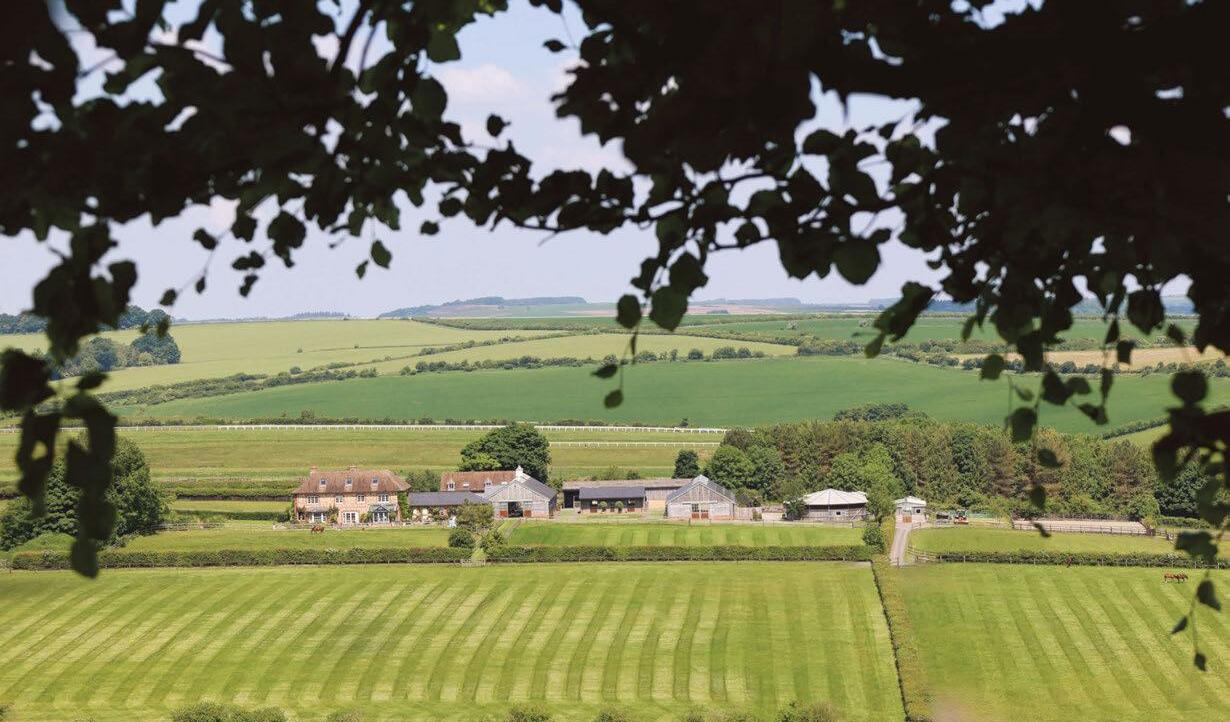

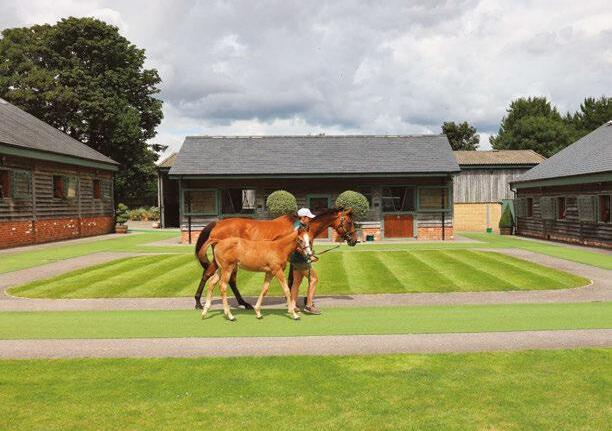
An Outstanding Country House and Stud Farm
M4 (J14) 6 miles, Hungerford 8 miles, Newbury 14 miles
• Windmill House: 3 main reception rooms, kitchen and conservatory, 3 bedrooms, 4 bathrooms, space on second floor for 3 more bedrooms and 2 bathrooms. Office. Well stocked mature garden.
• Accommodation barn with 2 flats
• Exceptional stabling with: 23 boxes, covered lunge ring, outdoor school, Horse walker, water treadmill
•·Railed paddocks over chalk downland
Approximately 37 acres (14.806 ha)
Price Guide £4.25 million
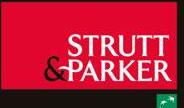
+44(0)1635 521707
The exports of Adayar, Hukum and Westover were viewed in some quarters as a reflection of our market – by contrast, each has been warmly received by breeders in their new roles in Japan
Words: Martin Stevens
The departure of British-trained middle-distance aces Adayar, Hukum and Westover to begin their stallion careers in Japan this year was something of a throwback to another era.
Japanese breeders resolved to improve the local breed in the late 1980s and 1990s after decades of acting as a dumping ground for unfashionable or underwhelming European sires, and set about buying winners of the Derby, Irish Derby, King George VI and Queen Elizabeth Stakes and Prix de l’Arc de Triomphe in bulk.
Among those sent to stand in Japan during that era – with mixed results, it has to be said, as many later returned home or were repurposed – were Carnegie, Carroll House, Commander
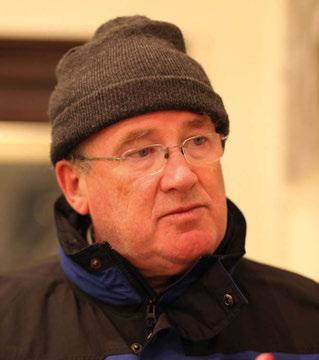
In Chief, Dr Devious, Dream Well, Erhaab, Generous, Helissio, High-Rise, Lammtarra, Oath, Opera House, Pentire, Tony Bin and Zagreb.
Perhaps because those Europeancampaigned stallions had been nowhere near as successful in Japan as the US champion and Horse of the Year Sunday Silence, the mass exodus slowed in the new millennium, with Alamshar, Bago, Conduit, David Junior, Harbinger, Novellist and Workforce among the few exported.
The flow was reduced to a mere trickle in the last decade, until the announcements last year that Derby and King George winner Adayar and fellow King George scorer Hukum would be retired to Darley Japan, and Irish Derby hero Westover had been sold by Juddmonte to stand at the Yushun Stallion Station.
The trio of European exports might be turning back the clock to the 1990s but they have arrived in a breeding landscape that has changed dramatically since those days.
Japanese horsemen have improved their stock so successfully, with Sunday Silence and his dominant son Deep Impact the key drivers of change in the breeding shed, that their output is now proven to be superior to international rivals on a regular basis.
Explaining why Adayar, an attractive son of Frankel and Irish 1,000 Guineas second Anna Salai, was retired to stud in Japan and not into a Flat role in Britain or Ireland as some here had hoped, Darley Japan’s President Harry
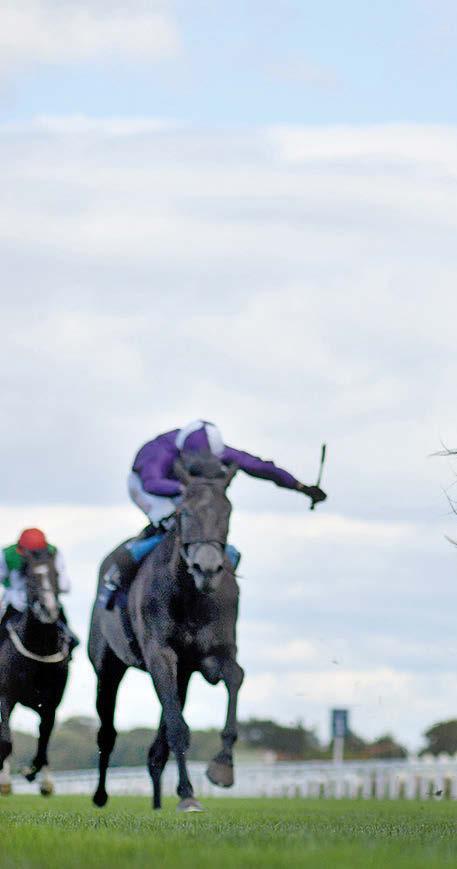
Sweeney says: “It was a pragmatic decision made by Liam O’Rourke as Triple Time, another son of Frankel, was joining the European roster and Hurricane Lane, another son who was a purchased horse, had been sold to become a National Hunt stallion.
“It probably wouldn’t have been ideal trying to launch him in Britain and Ireland when there had been a hiatus since his heroics in the Derby and King George either, so it was felt that because of the preponderance of staying races in Japan, where even the 2,000 Guineas is run over ten furlongs, people here would appreciate him more.”
As for Hukum, another beautiful specimen who is a Sea The Stars fullbrother to European champion Baaeed, he adds: “He’s still owned by Shadwell, and they weren’t keen to have him standing beside his brother, quite understandably.
“But Sheikha Hissa is very passionate about racing generally and about
Hukum (right) narrowly denies Westover in a thrilling finish to last year’s King George at Ascot
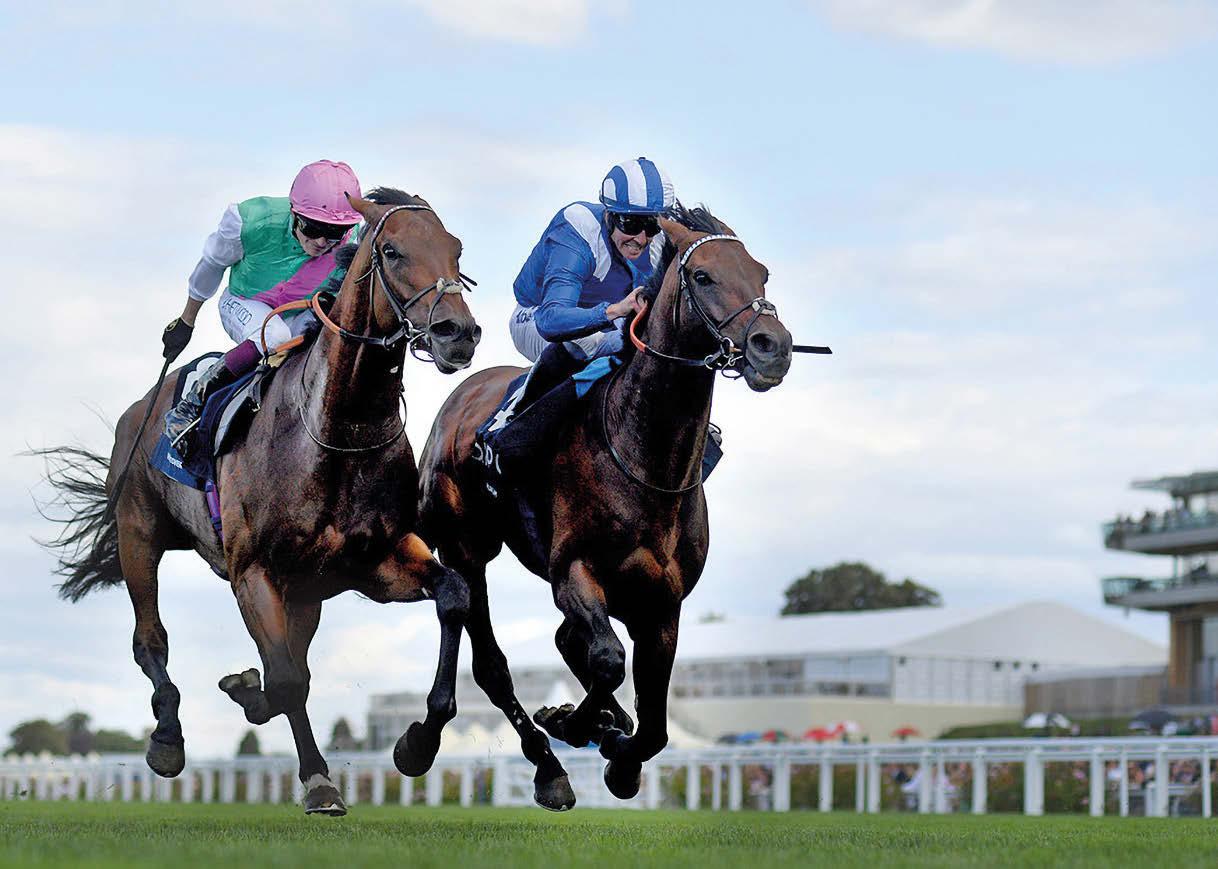
Hukum in particular so, as I understand it, when some offers to buy him came from Japanese studs it led the team to think that they might as well stand him here themselves.”
Speaking in June, with the Japanese breeding season continuing longer into the summer, Sweeney estimated that the two young stallions would each cover between 75 and 100 mares in their debut books.
“It’s been a reasonable start, but breeders here are slightly cautious about mile and a half horses,” he continues. “Many breeders who have been to see them tell us that while they like staying races, what they really love are fast staying horses.
“That sounds like a contradiction, but it just means the horses really have to have the speed to win over ten furlongs. If they win over 12 furlongs, they have to finish fast in doing so.
“They’ve probably also suffered a little bit because of other horses coming into Japan this year like
Westover. There’s a lot of horses competing in a similar space.”
Adayar and Hukum’s popularity in Japan is also slightly restricted by British and Irish middle-distance races having less cachet in Japan nowadays.
“Japanese breeders would certainly
“What the Japanese breeders really love are fast staying horses”
prefer a Japanese Derby winner over an Epsom Derby winner,” says Sweeney. “The number of sires being imported into Japan each year is down to about three, four or five, and some of those
are shuttlers.
“By and large, Japan has moved to a situation where it believes it can produce its own stallions. That’s very different to 20 or 30 years ago when there were 25 or more sires coming in every year, many of them from Britain and Ireland and winners of races like the Derby and King George.
“Japanese breeders aren’t going down the route of precocious two-yearold speed, absolutely not, but they’re also not quite as enthusiastic about those traditional middle-distance races as they used to be.”
With Japanese breeders having wellearned confidence in the bloodlines they have cultivated themselves, mainly those coming from Sunday Silence and Deep Impact, and now also Kitasan Black, a son of Deep Impact’s brother Black Tide and the source of world champion Equinox, there is a little less regard for European breeding.
Frankel is of course recognised as a high-class sire, having supplied
›› Japanese Grade 1 winners Grenadier Guards, Mozu Ascot and Soul Stirring, but Sea The Stars is not quite so popular, having been enthusiastically embraced by breeders there in his early years at Gilltown Stud but failing to repay the compliment.
“Hukum is a particularly attractive horse but Sea The Stars doesn’t enjoy the same profile in Japan as he does in Europe,” admits Sweeney. “In fact, the number of Sea The Stars progeny who came into Japan as racehorses were a bit disappointing to be honest. The great Japanese racemare Vodka went to him a few times, and none of the foals were any good at all.
“That’s hurting Hukum a little as Vodka was such a high-profile mare, and he’ll need to do it the hard way now. But even though there’s some
caution about his sire I wouldn’t be surprised if he gets good-looking foals in his own image, and if his second book consequently turns out to be better in terms of numbers.”
Adayar and Hukum have also had to fight for attention with their own studmates, as Darley Japan also imported Palace Malice and Yoshida from Kentucky this year.
“It wasn’t an ideal situation as we were committed to those two stallions coming in from America and one of those, Palace Malice, turned out to be incredibly popular,” says Sweeney. “In a stroke of incredible luck, only a few days after we brought him over, his son Jantar Mantar won the Grade 1 Asahi Hai Futurity Stakes.
“Jantar Mantar was the Japanese champion two-year-old and he has
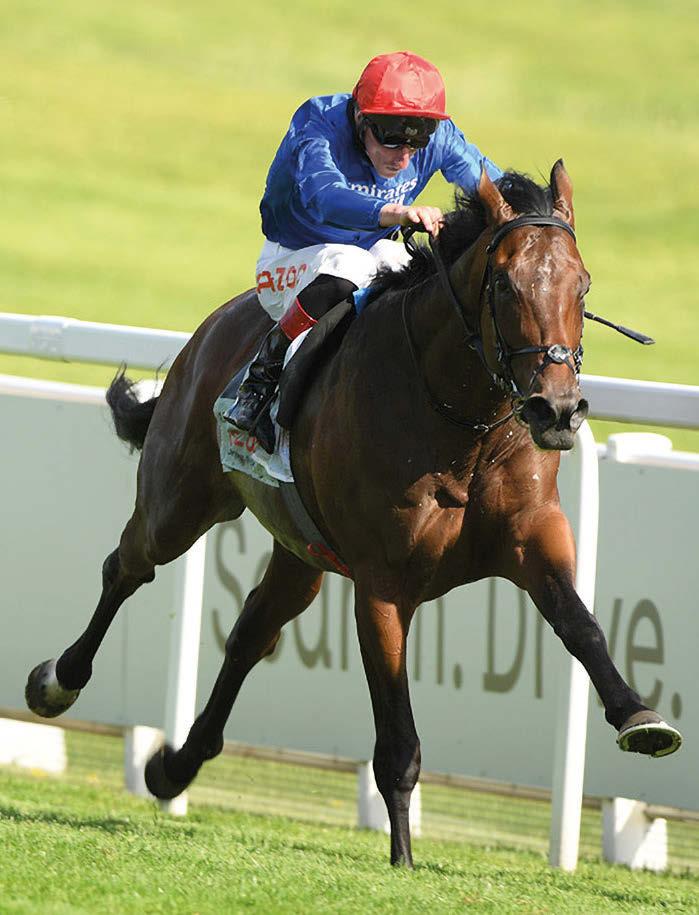
already won another Grade 1 [the NHK Mile Cup] this year. All that has put an awful lot of momentum behind Palace Malice and he’ll cover about 250 mares this year.”
If British and Irish stallion prospects aren’t quite as desirable as they used to be in Japan, to the point that even impeccably bred multiple Group 1 winners like Adayar and Hukum are a little overlooked by breeders there, it is arguably our own fault for allowing our racing and breeding to have fallen behind Japan.
Described by Sweeney as “nearly a utopia”, Japanese racing reinvests pari-mutuel betting revenue into prizemoney, facilities and fan engagement, while breeders favour achievement over further than a mile and across multiple seasons.
“When I was a young veterinarian at college, we used to talk about progeny
“I wouldn’t be surprised if Hukum gets good-looking foals”
testing,” says the Dundalk native, who arrived in Japan in 1990. “We weren’t talking about it in relation to thoroughbreds, rather bulls and cows for milk and beef production, but that’s what Japan effectively has: proper progeny testing for racehorses.
“First, there are so few Group 1 races here – only about 22 or 23 in total – so there’s no hiding place if you have a good three-year-old colt. The race options are down to the 2,000 Guineas, the Derby or NHK Mile: that’s it, you can’t duck and dive.
“There’s no automatic qualification, either. It’s not possible to pay your way into a big race through entry fees; you have to qualify to get in, earn your spot. Then the three-year-olds are forced to run against older horses pretty quickly.
“The possibility of a colt retiring to stud as a two-year-old, as sometimes happens in Europe, is unheard of in Japan. Breeders wouldn’t use them; the expectation is that horses will race at two, three and four.
“Because of that, and the limited number of Group races, we absolutely
know in the end who the best horses are. There’s no question as they’ve constantly been tested against each other.”
Sweeney goes on to describe other elements of Japanese racing’s keen sense of discipline that, regrettably, have fallen into abeyance in Britain and Ireland.
“The Japan Racing Association runs a fantastic racing product, with no shortcuts,” he says. “Horses have to be in the paddock and parading 30 minutes before any race, without exception. You can’t come in at the last moment and then leave, as happens in Europe all too often. That is just not allowed. Young horses have to have the temperament to manage that.
“Equally, horses have to be loaded into the stalls in strict order, there’s no permission given to go last. Horsemen here wouldn’t even know what that meant. So there is a very comprehensive progeny testing procedure, and that’s part of the reason why the Japanese breed has improved so dramatically in the last 30 years.”
Sweeney also credits Japanese breeders’ deep investment in elite bloodstock, facilities and staff, and a lot of hard work, for the country’s rise to the top of the tree.
“There’s self-confidence about the local produce now,” he says. “Japanese breeders struggled in the past but one way or another they’ve ended up with Sunday Silence and Deep Impact.
“Most of the leading stallions in Japan today in terms of numbers were bred here – the likes of Kitasan Black, Equinox and Contrail. In fact Palace Malice is a bit of an exception now, being an overseas horse who’s so popular.”
But could Sunday Silence and Deep Impact’s ubiquity in Japanese pedigrees, along with other prolific influences like King Kamehameha and Symboli Kris S, lead to breeders there needing to find outcrosses, as happened with their European counterparts painting themselves into a corner with Sadler’s Wells and Danzig?
That situation has caused several European breeders to seek accomplished outcrosses in Japan, with Deep Impact siring top-notchers here such as Auguste Rodin, Fancy Blue, Saxon Warrior, Snowfall and Study Of Man, another late son of Sunday Silence, Heart’s Cry, getting last year’s St Leger victor Continuous, and Coolmore sending mares to Kitasan Black, Equinox and Contrail this year.
“We need outcrosses, we know that,

Westover will cover around 100 mares during his first season at the Yushun Stallion Station this year, including several Group winners or producers and many well-bred individuals, according to a spokesperson for the operation.
Yushun formerly stood Prince Khalid Abdullah’s Epsom and Irish Derby winner Commander In Chief during his successful stud career in Japan.
“Westover is a very calm-natured horse who has taken to his new job really well and is very fertile,” said Hiroyuki Shiina. “We were very keen to get a topclass middle-distance turf sire and a son of Frankel. He can act as an outcross to Deep Impact and King Kamehameha mares, which is a big advantage in Japan.”
Frankel’s speed was another major deciding factor in Westover’s acquisition.
“Most of the big races in Japan are run over middle distances on turf, but Japanese breeders don’t necessarily want stamina sires,” continued Shiina. “They tend to think speed is more important than stamina, and shy away from stayers. That’s why we were particularly keen on Westover, as he showed he had a lot of acceleration, and his sire Frankel won over seven to ten furlongs and had natural speed. That was the key factor.”
Westover is another high-achieving horse sadly lost to European breeders for now. A brother to Darley Stakes winner Monarchs Glen out of Prix de la Foret third Mirabilis, he won the Grand Prix de Paris and Irish Derby and also finished second in the Dubai Sheema Classic, Coronation Cup, King George and Arc.
but it’s not really been discussed as a problem yet,” reasons Sweeney. “It does explain why a horse like Palace Malice is getting so many mares, though. A lot of those are from Sunday SIlence lines, as there’s limited places for them to go in terms of proven top-class sires.
“The next big money will be made in Japan by the person who comes up with a top stallion who is a good outcross to Deep Impact and Sunday SIlence.”
Perhaps that stallion could be
Adayar, Hukum or Westover. They might not carry as much prestige in Japan as their predecessors from Britain and Ireland in the ‘80s and ‘90s, but they have the right performance, pedigree and physique to excel.
Ironically, in fact, they’re just the sorts of horses that European horsemen should be breeding from in order to produce runners who can offer some resistance to the rise of more logically bred Japanese superstars on the world stage.
Danny Fantom is on a mission to make racing as accessible as possible and with the launch of his Century Racing Club, hopes to do just that with a taste of the breeding world added in
If enthusiasm for the game was a gauge for future success, then it won’t take long for Danny Fantom’s Century Racing Club to gain a foothold.
It is no secret that the sport’s stakeholders are trying to grow the popularity of racing. Syndicates, many of which offer entry into ownership at an affordable level, have long been seen as key to attracting more participants. Each offer their individual selling points; in the case of Century Racing Club, members will have the opportunity to be involved in the whole journey, from foal to racehorse.
Based in Weston-On-Trent near Derby, Fantom is building up a select
broodmare band at his Westonhill Stud that it is hoped - with the assistance of data and expert advice – will provide the basis to Century Racing going forward. In the meantime, there are already several horses on the books under both codes, including recent point winner Big Boy Barney.
“I’ve been lucky enough through business to buy a few horses,” says Fantom. “I’ve had horses in training for 20 years now. I’ve been involved in various small syndicates but owned the majority of them on my own. I’ve been lucky enough to have a few winners and there is no feeling like it.”

The key, Fantom says, is to make racing as accessible as possible. To that end, there are 100 shares spread across a multi-horse syndicate, likely to be six horses, with an agreement in place that Century Racing members will also receive an annual membership to every Arena Racing Company (ARC) track.
“The process with Century Racing is purely about getting people back to the track,” he says. “It doesn’t matter if you’re one of ten in a syndicate or 10,000, people still want to get to the track to see their horses run. I want it to be where you have a nice day out and meet nice people. Get people back to the races, get them seeing the horses and enjoying the buzz of it all.
“So I put a proposal to ARC that all members of Century Racing would receive annual membership to all their courses for themselves and their guests, and ARC has agreed to do that, which is great. I’m trying to make it as accessible as I can.”
The first horse to head into the syndicate is Big Boy Barney, a five-yearold son of Doyen who arrives from Ireland as the winner of his only start, a point-topoint at Loughanmore. He will be joined in due course by horses with George Boughey and Declan Carroll.
“I’m eager to get things moving,” says Fantom. “Big Boy Barney is the first horse. We’ll turn him out for a bit before moving on with him. He’s a tangible asset – he won his point, the form has been franked and he’s an interesting purchase.”
Down the line, however, the emphasis will be on youngstock and following them through from the start at the stud. At a
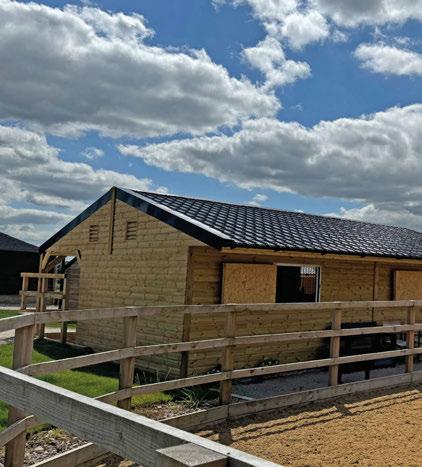
Danny Fantom: ‘I am going to try and give people the best deal out there’
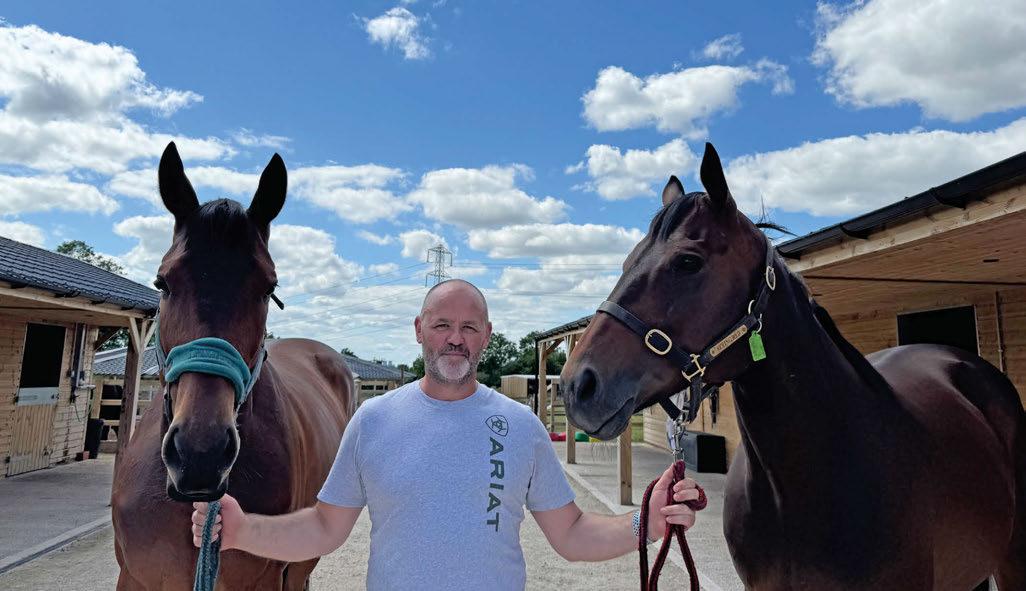
time when the base of British breeders is on a fragile enough footing, the arrival of a new operation like Westonhill is welcome.
“At the minute we have four broodmares, which we foal at the National Stud,” says Fantom. “Westonhill is 64 acres. We moved here two years ago and since then we’ve built new stables, installed horse walkers and put up new fencing. That’s phase one done.
“Next on the plan is to put in a ten-

furlong gallop so we can get to the stage where do our own pre-training. I actually did the trainer’s course as well back in February.
“I’ve been lucky enough to have some really good people help me. I have a very good relationship with the National Stud. I enjoy working with them – Joe Bradley and Anna Kerr there have been a great help.”
“We’re in a tough market and you’ve got to think outside the box”
He adds: “Century Racing Club and Westonhill Stud link together. One will supplement the other – the stud is going to supplement the syndicate but likewise the syndicate also promotes the stud. People will also get to see the full process from foal to racehorse, the full package.
“It’s also another way of keeping the cost of the syndicate down for people. We’re in a tough commercial market and you’ve got to think outside the box. I want to use technology to get where I want
to be. I use Equine Match, a programme developed by Spencer Chapman, which has 30 years of breeding data on it, and then I have all my horses genetically tested through PlusVital. I try to use as many tools as possible from start to finish, and then use the traditional visual methods on top of that.”
Waiting in the wings are yearling fillies by Bated Breath and Aclaim and colts by Ardad and Time Test. Youngstock by Mehmas and Harry Angel are also coming through.
“We would like to get up to ten syndicates on a rolling conveyor, but no more than that,” says Fantom. “We’re not going to do more than 100 shares – in fact, I’d like do some smaller boutique syndicates as well.”
Horse welfare is also a priority. Westonhill is home to several retired racehorses including Fantom’s multiple winner Jackamundo while it is planned that five per cent of profits will be split between racehorse rehoming charities and the Injured Jockeys Fund.
“I haven’t the voice to change anything major but in my own world, I can try through my syndicates,” says Fantom. “We’re not reinventing the wheel but I’m angling for it to have some nice deals attached to it, like the link up with ARC.
“The people who take Century Racing seriously and invest their money – well, I’m going to try and give them the best deal out there.”


We are all acutely aware of the importance of two-year-old racing, not least its role in influencing the commercial market. However, there are currently ripples to the status quo that leaves its place in racing in Germany in limbo.
Following a revision of German animal welfare laws, it is now illegal to train horses younger than 30 months of age. As far as racing is concerned, an exemption has been secured while a behavioural study on the physical and mental health on the horses in question is undertaken and analysed.
Germany already has restrictive rules on two-year-old competition; a two-year-old can race no more than six times in their first year and can only start their racing career in June of that season. It is anticipated that the
exemption will run until 2027, when it is expected that the study – Project Horsewatch – will be presented to parliament. Should the 30-month rule still be deemed appropriate, there could well be implications for other EU countries, including France and Ireland, under EU law.
To that end, a highly informative seminar to discuss the issue was recently hosted in Newmarket.
Organised at the Jockey Club Rooms by Fred Barrelet, consultant to Newmarket veterinary practice Rossdales, it hosted representatives from different corners of the equine world, including international racing regulators, and featured speakers such as trainers John Gosden and Sir Mark Todd in addition to the Florida-based pre-trainer Nick de Meric.
“My concern was that those who were investigating on behalf of the study were behavioural scientists with little knowledge of the industry or how thoroughbreds were reared,” says Barrelet. “So that led me to organising this workshop, to bring them over and spend a weekend in Newmarket where the scientifically valid question of ‘what is the maturity of a young horse and how do we assess it’ could be asked.”
As you would expect, the seminar was well attended, with representatives of the British Horseracing Authority (BHA), France Galop, the Japan Racing Authority (JRA), US Jockey Club, Horseracing Integrity and Safety Authority (HISA) and British Equestrian Federation (BEF) among those in attendance.
“We’ve all got to work together on
this,” says Barrelet. “Sir Mark Todd breaches numerous worlds, which is why I asked him to speak. And we had good representation from the welfare world – Roly Owers from World Horse Welfare and Madeleine Campbell from Nottingham University were also engaged to speak.
“The international delegates also had a day to visit Newmarket, where we had a morning on the gallops, a tour of John Gosden’s yard, a visit to the racecourse and a tour of the National Stud, where we went from paddock to paddock and finished up with the stallions. The German participants who hadn’t seen any of this before or had only been exposed to German racing suddenly had an introduction to British racing and the international game. And good questions were asked.”
He adds: “My aim was not to influence their research but to say ‘this is the context in which you are working’. And I think it worked well.”
The background to this issue goes back several years to the revision of German animal welfare laws. At the time, there was no legally defined minimum age for training and competition and its impact on welfare.
“What came out of it were three directives that are actually probably more legally hard-hitting than our guidelines in that they are used by the courts and also the state veterinarians to interpret German law,” says Barrelet. “In it they introduced a rule that you may not train or compete with a horse that’s under 30 months of age.
“Everybody was fast asleep on this. It didn’t really affect the sports horse world. But then the racing world suddenly woke up and said ‘this is going to affect us’ and went back to the German Equestrian Federation (FN).
A spokesperson there came into contact with the German Ministry of Agriculture and highlighted that it wouldn’t work for racing, and also trotters and quarter horses. The ministry then went back to parliament and said, ‘well, where’s the evidence on the maturity of horses?’ Some evidence was supplied but it was more on physical maturity, and so then the question was, ‘is this a welfare issue and what is the mental attitude of a horse?’ So parliament came back to the ministry and said ‘we’ll fund a study into the maturity of young horses to include the mental aspect as well as physical, and it has to apply to all breeds’.”
And so Project Horsewatch was born.
“There had to be a scientific advisory board and this is made up by representatives from the state as well as private welfare institutions,” says Barrelet. “It includes various equestrian associations across the different disciplines. I was then invited to join the group and I attended their first meeting, where they presented what they were going to do.
“Two things from a thoroughbred perspective concerned me. Within the directive itself, it states that its cosignatories, which are the associations involved, are to support the German federal government in its endeavours to introduce similar legislation at EU level and internationally. So automatically, that becomes France, Ireland and so on – suddenly the global thoroughbred industry is affected.”
He adds: “There is no science behind 30 months in any literaturethat’s arbitrarily plucked out of the sky.”
In Newmarket, Gosden kicked off
“Everybody was fast asleep –then suddenly the racing world woke up”
the seminar’s discussions by looking at when is the young thoroughbred ready to race.
“With young horses I tend to wait for them to present themselves to me,” he said. “If you go looking for them, or pushing them, you will do more harm than good. I find that the most important button when I am training horses is the pause button. But if you have a horse who is precocious and comes forward to you, it is the wrong thing not to train that horse.”
He also highlighted that “bone density increases from early training”.
De Meric pointed to research that demonstrated how early training can be critical to a young horse’s development. Renowned Kentucky vet Larry Bramlage has stated that the ideal training of youngstock is to produce bone that can withstand load. A two-year-old’s metabolism and
Nancy Sexton Bloodstock Editor
physiology can undergo and withstand training to repurpose the developing cells and vasculature for bone growth. Early exercise helps to cope with this growth.
“If the research comes back and says what we’ve been doing for the past 300 years has been wrong, then so be it,” says Barrelet. “But that’s not the case. As John Gosden and Nick de Meric have pointed out, it’s an animal by animal basis and if you’re a competent trainer, each animal will tell you what you can do with it at the right time and age.”
Indeed, George Lambton, a revered trainer of his time, even alludes to the racing of yearlings in the Newmarket area in the early years covered by his autobiography Men and Horses That I Have Known, published in 1924.
Those involved in German racing can do little for now but wait. In the meantime, participants are operating within a restricted arena of increased veterinary checks and costs.
“Technically in Germany, the law is enforced,” says Barrelet. “So to accommodate for operating with an exemption, they have introduced two examinations; one when the horse goes into training, where it undergoes an assessment by a vet who is not associated with the stable, and then another within two weeks of its first start. That includes a pyschometric assessment as well as the standard physical assessment
“As the three trainers said last week, a vet cannot assess a horse thoroughly in 30 minutes. You have to be with those animals day in, day out.”
The past few years have illustrated that racing cannot take its social licence for granted. In her talk, Madeleine Campbell highlighted that in a survey assessing horse welfare in sport, 40 per cent of respondees supported the continued development of horses used for sport, while 52 per cent felt that welfare should be prioritised.
It is true that Germany’s programme for two-year-old racing does not hold the same weight as other European countries (it stages just four two-yearold Pattern races per year) but at the same time, any momentum behind such an outright ban is going to have far-reaching consequences.
“We’ve got the international racing world aware of this now,” says Barrelet. “It’s too early to tell how it will be evaluated politically. It’s concerning but we’ll just have to engage with it.”
Circuit • By
Carl Evans
Not great, but not as bad as some had feared sums up the year’s first sale of unbroken, three-year-old jumping stores.
Held in Doncaster, and reduced from a two-day affair into a single, lengthy session, it continued the downward trend in figures seen recently at all types of bloodstock auction, yet there were plenty of buyers present and desirable lots with looks and pedigree were not short of bidders.
Nothing could match the Blue Bresil filly who topped last year’s sale at £210,000, which was a fitting tribute to her late breeder, Richard Aston of Goldford Stud, but the latest edition still threw up five six-figure lots, the same number achieved at two sessions in 2023. Some good pinhooks were achieved and falls of 13 per cent in the average price to a figure of £25,518 and 15 per cent in the median to one of £20,000 could be classed as acceptable. Turnover was down 28 per cent at just over £4.3 million.
More ominously for vendors of stores at sales which had yet to be staged was the decline in clearance from 81 per cent to 69 per cent. It could have been predicted at Christmas that market correction and rising costs would keep the
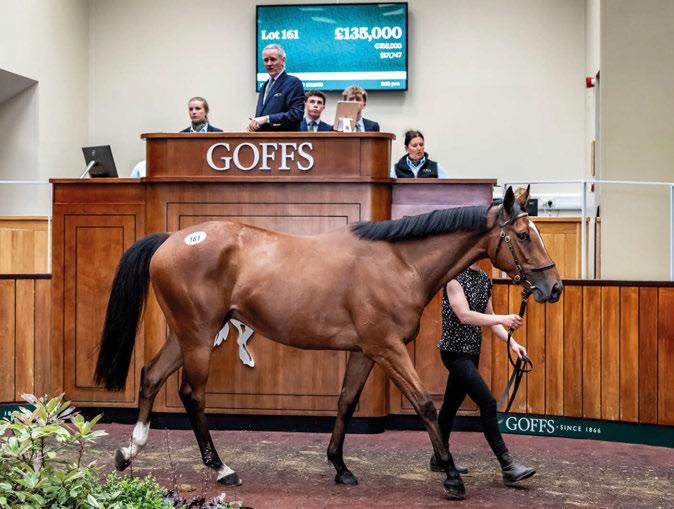
figures in check or pull them down slightly, but no one could have known the wettest winter on record was under way and would be influential.
In the knock-on world of horse selling

that meant stores bought last year or in 2022 were denied opportunities to run due to abandoned meetings, or were faced with racing in bog-like conditions. This was particularly true for point-topointers on both sides of the Irish Sea, for while some racecourses drain well naturally, none would have the drainage facilities invested in professionally-run racecourses.
As a result, point-to-point traders were being cautious, which in part explains why 32 of the 168 sold lots (almost 20 per cent) went down as private sales with buyers cautious in the ring, but prepared to talk about a deal outside. The Doyle brothers of Monbeg Stables, leading purchasers last year when buying 14 stores for £529,000 (including two six-figure horses), bought just six lots this time for £106,000, and four of those were picked up in private transactions. The Doyles were to prove more active at the Goffs Arkle Sale, but once again curbed their spend.
Tom Ellis, Britain’s leading trainer of pointers – until he gained a licence in March – bought four lots for £132,000 last year; this time he did not buy a single horse in his name, while Ballycrystal Stables’ Matty Flynn O’Connor, who

bought three horses for £201,000 in 2022, was another whose name did not appear on the buyers’ list.
Other well-known point-to-point handlers invested, but at low levels, and it was left to licensed trainers to battle for the biggest prizes. Dan Skelton, acting
Top lots
Name/sex/breeding
G Jukebox Jury - Fairy Tale
with ally Ryan Mahon, bought five stores for £377,000 and was the leading buyer, while a surprise second on that table was Wiltshire trainer Simon Earle, who had not bought at this sale in the previous two years, but who gained seven lots for a spend of £172,000.
Bloodstock agent Tom Malone also made his presence felt by buying the top two lots, namely a £135,000 son of Jukebox Jury – out of a half-sister to top-class chaser Master Minded – and a Beaumec De Houelle gelding for £110,000; both horses were destined for a place at Paul Nicholls’ Ditcheat yard. The lastnamed horse had been bought as a foal in France by Johnny Collins of Brown Island Stables, while the top lot had been picked up at the same age from a field in Ireland by Willie and Mandy Bryan of Shropshire’s Worthen Hall Stables. On that shopping trip the Bryans bought seven foals – all
Worthen Hall Stables
Beau Speed g Beaumec De Houelle – Tangaspeed Brown Island Stables
F Walk In The Park - En Vedette
Worthen Hall Stables
Style De Folie g Vol De Nuit - Anowe De Jelois Lakefield Farm
F No Risk At All - Brise Vendeenne
This proved a peppy event, with plenty of highs and talking points and trade which more or less matched last year’s sale.
The clearance rate dipped seven points to 81 per cent, but 378 horses found new owners whose love of jump racing or point-to-pointing was confirmed by their purchases. Turnover of nearly £9m was more or less the same as last year, a comment which also applied to the average price of £23,554, while the median was down seven per cent at £13,000.
The trade-topper was a four-year-old who had been given the prescient name of Minella Premier by vendor John Nallen, the man responsible for a string of successful ‘Minellas’. He bought Minella Premier as a foal, raised him at his Tipperary farm and trained him to win a Ballindenisk point-to-point on debut.
That was the crucial marketing opportunity successfully ticked off, and a clutch of deep-pocketed buyers were in Doncaster hoping to gain Nallen’s horse. Auctioneer Nick Nugent reported that four buyers were in at £250,000, and while agents Mouse O’Ryan and Tom
Goldford Stud
Sold: 168 (69% clearance)
Aggregate: 4,363,500 (-28%)
Average: 25,518 (-13%)
Median: 20,000 (-15%)
bred by Louis Vambeck – and they included a Walk In The Park filly who Skelton bought at this sale for £105,000.
Willie Bryan, an uncle to top-flight jump jockeys Sean and James Bowen, predicted the filly would win next year’s Goffs Spring Sale Bumper, a £100,000 race held at Newbury.
Malone also joined forces with trainer Jamie Snowden to buy Lakefield Farm’s gelding by Vol De Nuit for £100,000, while Skelton’s haul included a £100,000 No Risk At All filly consigned by Sally Aston’s Goldford Stud.
Tom Malone /Paul Nicholls
Ryan Mahon/Dan Skelton Racing
Tom Malone/Jamie Snowden
Ryan Mahon/Dan Skelton

Malone were out of luck, and trainers Laura Morgan and the O’Neill team of Jonjo and AJ fared no better, the £400,000 bid struck by agent Jerry McGrath ensured the gelding would be
a sale-topping £400,000
heading to Nicky Henderson. The head of Seven Barrows said: “He is for Oliver Harris who has some really smart novice hurdlers – we have four and they have all won – and this one joins the portfolio.”

The transaction was the highest at this auction since Interconnected was sold – out of Henderson’s yard by owners Grech & Parkin – to Phil Kirby and Darren Yates for £620,000 in 2019.
Nallen also traded a pair of five-yearold Irish pointers who added to the day’s turnover. Minella Juke was booked for a trip to Gill Johnston in the US after being bought by Dan Astbury for £140,000, while Minella Sixo was sold for £115,000 to
Mouse O’Ryan and Pioneer Racing.
Laura Morgan missed out on the top lot, but with the backing of former professional footballer Alan Rogers she picked up winning pointer Dawn Miss for £220,000 and four-year-old I Ain’t Your Mate for £120,000. The pair were bought in the hope they can match or outperform Rogers’ good chaser Notlongtillmay who died in January.
With the cream of the catalogue’s young pointers traded on day one, focus at the second session turned to two dispersals; the annual Million In Mind draft, which on this occasion was short of star material, and a one-off involving five horses owned by Steve Parkin of Clipper Logistics. His involvement in Flat racing has gone up many notches with the purchase of Dullingham Park in Newmarket, hence the decision to clear his jumping stock.
The stand-out on paper was Mossy Fen Park, placed in a Grade 2 at Fairyhouse for trainer Henry de Bromhead, who duly brought the hammer down with an offer of £235,000.
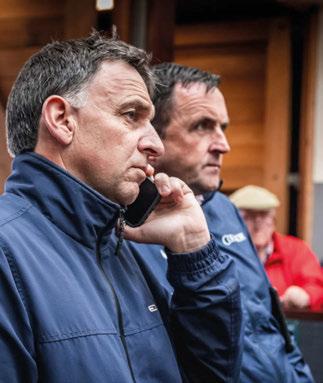
Statistics
Sold: 378 (81% clearance) Aggregate: 8,903,400 (0%)
23,554 (0%)
13,000 (-7%)
Tattersalls Ireland was not the first company to stage a breeze-up sale in Ireland, but it is doubtless glad to be doing so now.
At the latest and sixth edition of the auction – and having dropped ‘Goresbridge’ from the title – the company enjoyed a buoyant event with a 90 per cent clearance rate (up seven points) and record figures for both turnover and average. A total of 21 horses reached or breached the six-figure mark, three more than last year, and while the number of offered lots had risen by six, the market swallowed the additions plus another 15 horses as well.
In his close-of-sale summary, Tattersalls Ireland CEO Simon Kerins reported purchasers had been welcomed from 18 countries and in relation to that he acknowledged the role played by Charles O’Neill and his team at Irish Thoroughbred Marketing. He also thanked Fairyhouse

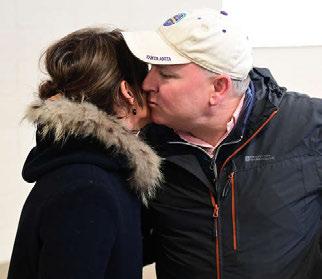
racecourse for producing a track suitable for young breezers.
Quite why this sale should have been so successful was open to several interpretations, but being held after its rivals – it is the final one of its type in the calendar – and giving vendors more time for preparation, particularly with a late foal, was in its favour on this occasion. During a very wet winter and spring which meant many horses were slow to come in their coats, the end-of-May date proved no disadvantage. You have to also wonder whether the shenanigans in getting horses in and out of Brexit Britain is making Irish vendors question whether it is better on occasions to sell at home.
Trade was headed by a Sioux Nation filly consigned by Katie Walsh of Greenhills Farm and knocked down to
Mark McStay of Avenue Bloodstock for €370,000. McStay was acting for a client of trainer Paddy Twomey, whose new recruit was a half-sister to six winners and from the family of multiple Group 1 winner Luxembourg.
This transaction was a tremendous pinhook for Walsh, who had bought the filly privately at the Goffs Orby Sale for €60,000.
Sioux Nation was represented by two fillies, the other being sold to Matt Coleman for €270,000 having been consigned by Lacka House Stables’ Ryan Conran and Pamela O’Rourke. Coleman’s Stroud Coleman Bloodstock would go on to become leading buyer through its acquisition of five horses for a total of €750,000, the quintet including a Profitable colt from Willie Browne’s Mocklershill Stables. This one represented another grand pinhook for Browne, the master of the breeze, who spent a mere €6,000 buying the colt as a yearling, and then reselling him for €270,000. Mocklershill was the sale’s leading consignor by aggregate, trading 14 lots for €814,000.
David Spratt of Gaelic Bloodstock was underbidder on the Sioux Nation filly sale-topper, but 14 lots later he moved in again and with a €300,000 bid secured a son of Earthlight. The young Darley stallion has notched a handful of winners with his first crop of runners, but the
Earthlight - Elusive Laurence Beechlea Bloodstock
F Sioux Nation – Coto Lacka
C Profitable - Fleeting Princess Mocklershill
C Too Darn Hot - Tears Of The Sun Hyde Park Stud
In an era when pop-up sales and online auctions are proving effective, the traditional horse-in-the-ring events have to be light on their feet.
Hence, at short notice, Tattersalls Ireland staged a 23-lot sale of point-topointers and horses-in-training on the eve of the company’s young-but-established May Sale of stores. Demand from consignors was signalled as the reason for putting on this new event, and given the wet weather hold-ups encountered by point-to-point handlers during the winter and spring, a late chance to shift horses
who had run in the final two weeks of the season was an opportunity neither they nor the sales company wanted to miss.
The decision led to a €718,500 addition to Tattersalls Ireland’s turnover through sales of 16 lots that averaged €44,906 at a median of €32,500. Whether the event has a future following a less-wet winter and spring will be interesting to see, but in tandem with the store sale it could become established at a level.
A Flat-bred four-year-old named Arslan who had been beaten in a point-to-point on his only start headed trade when selling for €180,000, but given that Harold Kirk bought the son of
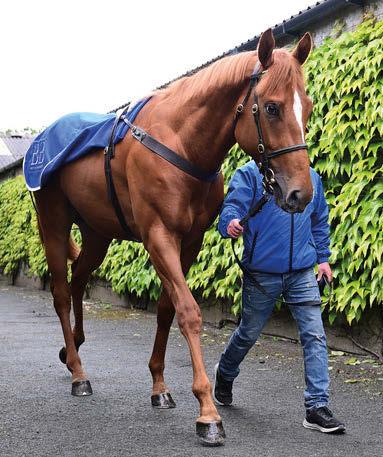
market has been fond of his stock since they first appeared as foals. Spratt’s purchase was offered by Beechlea Bloodstock’s Conor Hoban, the former jockey who retired last year and who consigned the Earthlight for breeders Raith Cairn Stud.
Blandford Bloodstock Statistics
Wootton Bassett on behalf of Willie Mullins it is reasonable to assume he was full of promise. The gelding’s dam was a dual Grade 1 winner in the USA and has been bred to such as Deep Impact and Frankel, but her Wootton Bassett proved too backward when put into training in France by breeders Al Shaqab, and he was culled for €28,000 as a three-yearold at Arqana’s Summer Sale.
He then came into the care of trainer Richard Black, who must have been grateful for the rain which kept coming and enabled him to run Arslan on soft ground on the penultimate day of the Irish point-to-point season, albeit he was
beaten by a rival four-year-old who had the benefit of a run. That horse, Long Branch, was also offered at this sale, but was knocked down to his vendor at €70,000.
If the name Wootton Bassett was an unexpected find in a catalogue of pointers and bumper horses, so too was that of Zarak, who was responsible for just one runner during the Irish point-to-point season, namely filly Dippedinmoonlight. In addition to her sire – who let’s not forget has been responsible for Galway Hurdle winner Zarak The Brave besides a growing list of stakes-winning Flat horses – she brought other plusses to this catalogue, being a sibling to four winners out of a half-sister to the great Goldikova.
In terms of racing performance she was one from one, having landed a point-to-point by 40 lengths in a fast time on the final day of the pointing season, and in hindsight she was an absolute steal when bought a few months earlier at the Goffs February Sale by Wexford trainer Darragh Berry for just €9,500. Berry was handsomely in profit when at this event his filly was sold for €130,000 to trainer Emmet Mullins.
Other catalogued lots proved less valuable, with the third highest-price being one of €48,000 for pointing runner-up Dance Rules.


As far as store sales go, the May version is middle-ground with results slightly ahead of Tattersalls Ireland’s younger July Store Sale. With the current state of the market and the leading Goffs Arkle and Tattersalls Ireland Derby Sales then still to come, it would have been no surprise if trade had been lukewarm or even chilly, but it proved better than that.
True, buyers were cautious about the sums they spent and there were declines in turnover and the average and median prices, but a two-point rise in the clearance rate – to 71 per cent – was welcome and probably unexpected.
Point-to-point handlers were the driving force behind many sales, with Ireland’s perennial champion in that sphere, Colin Bowe, buying the €45,000 top lot, a filly by Bathyrhon, in partnership with James Kenny. Named Lady Blackmore, she had been bought as a yearling at Arqana’s Autumn Sale for €9,000.
Monbeg Stables’ Sean Doyle invested €42,000 in a gelding by Jack Hobbs from John Bleahen’s Lakefield Farm, while Bleahen’s brother Niall of Liss House
gained €40,000 for a son of Affinisea bought by Stuart Crawford and his brothers.
• John Bleahen was not unhappy at receiving €42,000 for a son of Jack Hobbs who he sold at Tattersalls Ireland’s May Sale of stores, but in recent years he could have expected more.
Bleahen, who trades as Lakefield Farm, had bought the gelding for £10,500 at Goffs UK’s January Sale as a young yearling, and will have made a profit on his investment, but in 2024 that is a deal which store vendors have had to accept. Saying there is “a readjustment in the market” Bleahen gave a pointer to the future when he added: “We have crops coming behind so we need to keep them [stores] moving forward. We’ll just have to start paying less for the foals.”
Liss House traded four lots for €102,000 to become leading consignor –and would go on to make waves at the Arkle Sale – while the determined Doyle brothers left with 15 horses having spent €300,000, which gained their Monbeg Stables the role of top buyer.
Top lots
Name/sex/breeding
Lady Blackmore f Bathyrhon – Pennsylvanie
G Jack Hobbs - Penelope Pips
G Affinisea - Phantom Queen
Pre-sale concerns suggested the figures would be grim or worse at this, one of two Irish store auctions offering the best of three-year-old future jumpers.
Yet while de-stress supplements were popular among vendors, events in the ring at the two-day Part 1 catalogue restored a sense that while the game is tough at the moment, it has not imploded. A clearance rate of 80 per cent was not at all bad, albeit nine points down on the figure achieved 12 months ago.
Turnover, which last year reached €20.4m, was down 19 per cent at €16,529,000, yet a seven per cent fall in average to €48,615 and a 12 per cent decline in median to €42,000 were reductions vendors would have accepted before the first lot walked into the ring.
Referring to the mood ahead of the sale, bloodstock agent Tom Malone spoke of “massive doom and gloom” although he was able to add, “thankfully that hasn’t transpired”, while Goffs Group CEO Henry Beeby said: “It is no secret that there was a feeling of trepidation as the sale approached, as it has been a tough year in

Sold: 16 (70% clearance)
Aggregate: 718,500
Average: 44,906
Median: 32,500
Sold: 169 (71% clearance)
Aggregate: 2,165,750 (-10%) Average: 12,815 (-10%) Median: 10,500 (-11%)

several ways,” although he said events in the ring had resulted in “a sale of vibrancy and strength”.
He spoke of the “familiar refrain that it is ‘hard to buy the good ones’,” and noted that while trade was down the figures had only been bettered twice before and that was in the two preceding years.
However, the single-session Part 2 proved a harder sell, as evidenced by a clearance rate of 69 per cent, which drew the comment from Beeby that it demonstrated “the challenges the market is facing away from the headline horses”. Turnover at Part 2 – where geldings by Joshua Tree and Poet’s Word headed trade at €45,000 – was down 32 per cent at €2.2m, the average price contracted 23 per cent to just over €15,000 while the median fell 18 per cent to €14,000.
Whatever the figures tell us the noted pinhooking brothers John, Niall and Hugh Bleahen will not forget the 2024 Arkle
Sale in a hurry and for the right reasons. Niall and his daughter Emily could take particular pride in selling a top lot at both parts, for they traded the aforementioned Joshua Tree gelding at Part 2 to Harold Kirk and Willie Mullins, and they also sold Closutton Stables’ noted double act the pick of the parade at Part 1, a €210,000 gelding by the Polish-bred stallion Tunis who stands in France at Haras de Cercy.
The Bleahens’ sale-topper, already named Leader Des Bordes, was a half-brother to a wealth of black-type performers in France and to the Mullinstrained Kopek Des Bordes, who in March made a winning debut in the valuable George Mernagh Memorial Bumper.
Twenty-four hours earlier Niall and Emily’s Liss House draft had been teed up for the top lot when, during the first session, they sold a No Risk At All gelding to Ian Ferguson for €160,000. That proved to be the joint-highest price on the
first day, matched only by a Doctor Dino gelding offered by Sluggara Farm’s Walter Connors and sold to Gordon Elliott.
Just below that valuation was another son of Tunis who made €155,000 to a bid from Tom Malone and Paul Nicholls. Johnny Collins’ Brown Island Stables was the vendor, while Connors’ belief in the progeny of Doctor Dino came up trumps
Statistics Part 1
Sold: 340 (80% clearance)
Aggregate: 16,529,000 (-19%)
Average: 48,615 (-7%)
Median: 42,000 (-12%)
again when another member of his draft fetched €150,000 to a bid from Kevin Ross.
Returning to members of the Bleahen family, Niall’s brother John, who trades as Lakefield Farm, got in on the six-figure sales when selling a €125,000 No Risk At All filly to trainer Olly Murphy and his bloodstock agent father Aiden, while
Statistics Part 2
Sold: 149 (69% clearance)
Aggregate: 2,249,250 (-32%)
Average: 15,096 (-23%)
Median: 14,000 (-18%)
• Vendors of stores will have been pleased to see the name of Monbeg Stables as leading buyers once again at the Arkle Sale Part 1.
The Doyle brothers who trade under the Monbeg banner involve themselves primarily in purchasing horses with a view to running them in point-to-points and then trading them on. That is the nature of their business and so they can be expected to return to the store market year after year. By contrast a racehorse owner might spend heavily one year and nothing the next.
However, an indication of current challenges facing the Doyles and fellow point-to-point handlers can be seen in figures which show that in 2023 they were leading buyers with 31 purchases for just over €1.6m. At the latest sale they bought 17 lots for €737,000.
Leader Des Bordes g Tunis - Miss Berry Liss House
Techno Davis g No Risk At All - Clarinet Davis Liss House
G Doctor Dino – Garmerita Sluggara Farm
Blackswan d’Oroux g Tunis - Belle Du Bresil Brown Island Stables
G Doctor Dino - Black Luna Sluggara Farm
G Diamond Boy - Cap Soleil Brook Lodge Farm
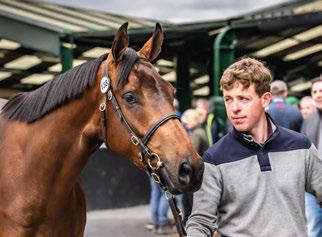
Hugh Bleahen of Clifton Farm bagged a €90,000 double through sales of geldings by Kapgarde and Affinisea to Gerry Hogan and Ellmarie Holden respectively.
• The trend for buying young jumping horses by French or ex-French sires is not new, but it seems to be gathering even greater pace.
Of the top ten sires by aggregate at the Arkle Sale, five stand or stood in France, headed by Blue Bresil, whose 25 sold lots averaged just over €55,000. Four of the top ten have covered solely in Ireland, while Maxios stood for five seasons at Gestut Fahrhof before moving to Ireland.
However, the top ten lots were all by current or former French sires, as were 18 of the top 20 – of the two exceptions, one was a €105,000 son of Getaway, while the other was a €95,000 gelding by Jukebox Jury, who, like Maxios, had begun his stallion career in Germany. The most valuable store by a stallion based in Britain was an €85,000 son of Shade Oak sire Dartmouth.
Harold Kirk/WP Mullins
Gordon Elliott Racing
155,000 Tom Malone/Paul Nicholls
150,000 Kevin Ross Bloodstock
150,000 Mags O’Toole
Louxor De Grugy g No Risk At All - Diane De Grugy Oak Tree Farm 150,000 Tom Malone/Paul Nicholls
Goffs London Sale
An anthropology student could find a rare selection of case studies at this unique occasion, including a crestfallen auctioneer who had just sold a horse for £5m.
Why so glum having brought the hammer down on such a considerable sum, a record for this auction and one of the highest prices likely to be achieved anywhere in the world this year? Because
midway through this 23-lot auction-cumgarden party, the auctioneer in question, Goffs Group CEO Henry Beeby, had knocked down the same horse, threeyear-old Sparkling Plenty, for £8,100,000, which would have been a world record for a filly in training. He had also taken genuine bids from separate parties at £7.8m and £8m.
For comparison, in 2007 Playful Act sold for $10,500,000 (approximately
£8.3m at current conversion rates), while in 2008 Better Than Honour made $14,000,000 (£11m), but they were broodmares. Better Than Honour’s sale involved a buy-out, as did one involving Winx’s yearling filly who in April made Aus$10m (£5.26m).
However, within seconds of the hammer falling it became apparent the highest bid had been made on behalf of Sparkling Plenty’s octogenarian owner-
breeder Jean-Pierre-Joseph Dubois, a man who sells gems reluctantly. True, Sparkling Plenty had become a Classic winner 24 hours earlier when landing the Prix de Diane, and the daughter of Kingman and Speralita had a pedigree to match. Yet the fact that she had remained in the catalogue and not been withdrawn from the sale, as many had expected after such a superb update, implied her vendor would be selling, albeit with a high reserve.
Attempts to clarify the situation went into overdrive, and in a quiet area away from the throng who were enjoying a glorious summer’s evening of socialising and tippling on the eve of Royal Ascot, and while Nick Nugent kept the auction ticking over, discussions were held between Beeby and the various parties, namely Amanda Zetterholm, who had registered the final bid on the vendor’s behalf, underbidder Emmanuel De Seroux plus Amo Racing’s Kia Joorabchian, who had made the £7.8m offer.
Some half an hour later came another twist. Sheikh Joaan’s Al Shaqab Racing was named as buyer at £5m, although that entity’s racing manager, Nicolas De Watrigant, said a 50/50 partnership had been struck with Dubois. Monsieur Dubois had bought his filly in at €600,000 when putting her on the market as a yearling at Arqana, but that proved a wise decision.

Joorabchian did not leave empty handed for with two successful bids he added more than £1.1m to turnover. He bought a two-year-old filly by Kingman out of top-class racemare Laurens for £650,000 and the three-year-old colt Taraj for £480,000. The filly was consigned by Mark Dwyer’s Church Farm Stables on behalf of John Dance, whose racing empire is being deconstructed following allegations of irregularities in his financial business, while Taraj came from Dermot Weld’s stable following a placing in Leopardstown’s Group 3 Derby Trial. He went on to finish unplaced at the royal meeting in the King George V Handicap.
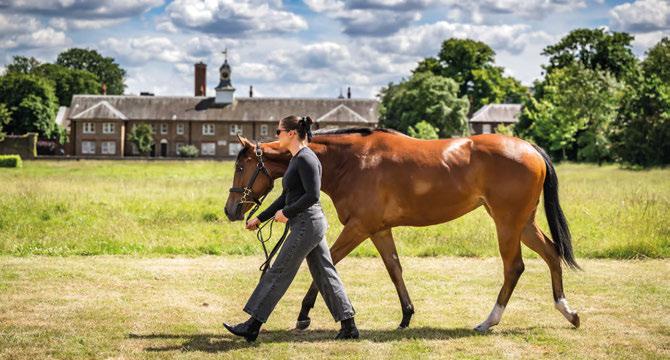
Jim Cockburn’s Teme Valley Racing gained Pentle Bay, a juvenile son of New Bay who had won at Leicester on debut; Racing Manager Richard Ryan said he would eventually head to Australia to race from Ciaron Maher’s stable. Teme Valley paid £400,000 for the colt, but made a paper profit on the evening by selling Cool Dividend for £250,000 and General Assembly for £180,000.
Being held just ahead of Royal Ascot enables the London Sale to attract racing practitioners and celebrities from around the world, not least the USA. From across the Atlantic came TV chef Bobby Flay, who bid in person on the Kingman/ Laurens filly.
It also introduces racing partnerships which may not have been heard of in Europe. Last year that included Tuckernuck Racing, while on this occasion Flurry Racing, the brainchild of Arkansasbased Staton Flurry, made its debut. His representative, Clay Scherer, parted with £300,000 to secure Take Me To Church, a three-time winner for Dunboyne-based Jack Davison.
Statistics
Sold: 15 (65% clearance)
Aggregate: 8,395,000 (+123%)
Average: 559,667 (+63%)
Median: 200,000 (-20%)

It has been another 12 months of huge success for the breeze-up market on the racecourse. Since this time last year we have seen the emergence of the Prix Morny and Middle Park winner Vandeek – bought for 625,000gns at the Tattersalls Craven Sale – join an exalted list of Group 1-winning breezeup graduates. He heads an army of 42 stakes horses that have emerged so far from the big five breeze-up auctions held last year. It is unsurprising therefore that potential buyers were going to take ever more interest in this sales format, and also that vendors were going to respond by bringing better individuals to these sales.
That is precisely what happened this spring. Across the five main auctions, comprising the Craven, Guineas, Doncaster, Arqana and Goresbridge Sales, the average price soared compared to last year from £74,892 to £94,504, a scarcely believable jump of 26 per cent. It is even more incredulous given that 2023’s average was itself a 17 per cent increase on the previous year. But like most bull markets, the rewards are very rarely shared evenly
between all participants. Only 54 per cent of the pinhooked yearlings – and they made up 78 per cent of those sold – gave their vendors a gross profit margin of £10,000 or more. Last year, 56 per cent of the pinhooked yearlings did the same – not a whole lot different.
So where did all this extra money go and why was there not a better return across the board? Inevitably, most of the extra investment was focussed on the choicest lots but as I have already suggested, a significant amount of each vendor’s profit margin was also eaten up by higher yearling costs. This time around the average price for yearlings purchased for resale at the big five auctions this year stood at £46,735, up 21 per cent from the corresponding figure 12 months earlier (which was already an all-time high and 20 per cent higher than the previous year). So in just two years, the breeze-up average price has climbed by 52 per cent and the average pinhooked yearling cost risen by 45 per cent.
Overall, this year was no more profitable for vendors with 150 (25 per cent) making a gross margin of £50,000 or more, while
87 (14 per cent) recorded gross profits in excess of £100,000. In 2023, the corresponding numbers were almost identical at 151 (25 per cent) and 80 (13 per cent). Two years ago, only 114 (23 per cent) broke the £50,000 profit barrier and 50 (10 per cent) the magical £100k margin. And in 2021, it was 102 (21 per cent) and 42 (9 per cent) that met or surpassed those two benchmarks.
All that said, it was important that the 2024 breeze-up market didn’t regress when viewed as a whole against 2023. Just as there were more winners this year, there were also more losers at the other end of the scale, with 174 (29 per cent) of pinhooked yearlings making an outright loss in 2024, again almost identical to last year’s 171 (29 per cent). Ironically, in the two years prior to that, there were fewer loss-making yearlings and smaller percentages, 2022 weighing in with 111 (22 per cent) and 2021 with 89 (19 per cent).
Last year, £58.6 million was spent at the five major breeze-up sales and despite that number rising to £72.9m this year, the sub-structure on the market didn’t change too much, all of the new money being

spent at the top end of the market. Consequently, it was not all that surprising to see most of the extra money create seven new sterling millionaires this year, when there had previously been just one, last year’s Arqana May top-priced No Retreat, a son of Siyouni who was placed on debut earlier this year for Roger Varian. The new millionaires were split seven to one in favour of the Craven Breeze-Up over Arqana and only the Godolphin New Bay colt Anno Domini has won among the three that have started so far.
Up to the end of Royal Ascot, there have been five black-type horses emerge from this year’s breeze-ups and remarkably four were purchased by Richard Brown of Blandford Bloodstock on behalf of Wathnan Racing, featuring Royal Ascot scorers Shareholder, winner of the Group 2 Norfolk Stakes, and Leovanni, winner of the Group 2 Queen Mary Stakes, plus the Group 2 Coventry Stakes second and third Electrolyte and Columnist. All four had been pinhooked as yearlings and all returned healthy profits for their vendors, having originally cost less than £76,000.
With all the talk of million-pound two-year-olds, it always worth remembering that the average price of a breeze-up Group winner in the past six years comes in at a very affordable £146,952.
It’s interesting to speculate how Dark Angel might have fared had he stayed in training beyond his two-year-old season. At the time, the British and Irish sprint programme for three-year-olds was weak, a reason that was partly put forward for his early retirement when it was announced in October 2007 that he was to stand the following season at Gay O’Callaghan’s Yeomanstown Stud.
Dark Angel had been a hardy juvenile, the first real major flag-bearer for his sire Acclamation whose nine-race campaign for Barry Hills had ranged from a win at Chester’s May meeting to the Middle Park Stakes at Newmarket on his penultimate start. In between, there had been victories in the valuable DBS St Leger Sales race (now the Goffs UK Harry Beeby Premier Yearling Stakes) at York and Mill Reef Stakes at Newbury to illustrate that he was very much at home over six furlongs. When he subsequently ran down the field on his first try over seven furlongs in the Dewhurst Stakes, that further consolidated the view that his future most likely lay sprinting.
Opportunities for such a horse, however, were then few and far between. Thankfully, that issue was later resolved thanks to the arrival of races such as the Commonwealth Cup and Sandy Lane Stakes. However, at that time the programme rather forced the trainer’s hand into trying to make the horse in question a miler, with a crack at the Guineas often coming ahead of a drop back in distance against older horses, one notable example being Danehill back in 1989.
By the time the next year’s 2,000 Guineas rolled around, Dark Angel was covering his first book of mares at Yeomanstown Stud. Retiring two-year-olds to stud is obviously not for the purists but it followed the precedent set by Fasliyev, who had been retired by Coolmore with some initial success due to injury eight years previously. Various other operations followed suit in the following years, presumably feeling the need to satisfy the demands of the commercial market, but bar the likes of Blackbeard in 2023, it is a trend that has since quietened down to some degree.
As far as Dark Angel is concerned, he was expected to throw sharp two-yearolds when they first emerged in the spring of 2011. And that he did. For instance, there
was the Richard Fahey-trained Lily’s Angel, who won her first three starts topped by the Lily Agnes Stakes at Chester’s May meeting. At that same fixture, her stablemate Gabrial scored easily on his debut over five furlongs.
As it turned out, both horses came to epitomise a typical Dark Angel; between them, they ran 19 times in good company at two and trained on into consistent Group performers during similarly busy campaigns as older horses. Gabrial in particular became a fan favourite with a record of nine wins in 93 starts and various high-profile placings highlighted by a third behind Frankel in the Sussex Stakes.
Over a decade on and the progressive, high-class type of Dark Angel remains very much a part of the British and Irish racing landscape, as we saw at Royal Ascot where the stallion – now a 19-year-old veteran –was represented by the Group 1 winners Charyn and Khaadem.
Four-year-old Charyn, whose widemargin win in the Queen Anne Stakes
One of the defining moments of the 2008 racing season in North America was the sight of trainer Rick Dutrow heading out to the track in the aftermath of the Belmont Stakes, the sweat drowning his shirt like a tide.
With the eyes of the racing world upon him, Dutrow was marching out to meet his star three-year-old Big Brown following a shockingly bad performance in the Belmont, the third leg of the Triple Crown. Big Brown had won the first two legs, the Kentucky Derby and Preakness Stakes, in such authoritative style that he went off the 30-100 favourite to become the first Triple Crown winner in 30 years but weakened so quickly down the back stretch that he was all but pulled up by jockey Kent Desormeaux, leaving Da’ Tara to win as a 39-1 shot.
Big Brown did return to bag another Grade 1, the Haskell Invitational at Monmouth Park, before retiring to stud as the subject of a hefty valuation to Three Chimneys Farm in Kentucky. He did not have a heavyweight pedigree on his side,
continued an excellent season for his owner Nurlan Bizakov of Sumbe, was a Group 2 winner as a two-year-old in the Criterium de Maisons-Laffitte. He ran some creditable races in defeat as a three-yearold last year but has found a new level of form for Roger Varian this season, with wins in the Doncaster Mile and bet365 Mile preceding his Ascot victory.
Charyn is an O’Callaghan success story from top to bottom, having been bred by Guy O’Callaghan’s Grangemore Stud out of a mare, the Listed-placed Futoon, by Kodiac, who has successfully held court at Tony O’Callaghan’s Tally-Ho Stud for so long. Charyn has developed into a really consistent high-level performer and given the no-nonsense manner of his recent victories, the Queen Anne Stakes is unlikely to be the last of his Group 1 successes. Regardless, Sumbe has another proper stallion prospect on its hands to stand at its Normandy-based farm.
Yeomanstown Stud also bred Khaadem, who recorded back-to-back wins in the Queen Elizabeth II Stakes. He is twice the age of Charyn and has been a classy fixture during each of the past six seasons for Charlie Hills, initially in the colours of Sheikh Hamdan, whose Shadwell Estate Company paid no less than 750,000gns for the horse as a yearling.
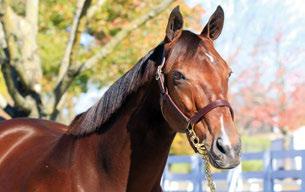
Puca: dam of back-to-back American Classic winners Mage and Dornoch
being a son of the inexpensive but extremely well-bred Danzig horse
Boundary, and having initially started out at a fee of $65,000 in 2009, was advertised at only $10,000 by 2014. Those who were wary were proven right for the most part as out of his 35 stakes winners sired to date, only one, Dortmund, has scored at the top level. Since 2015, he has resided in New York, most recently at Irish Hill and Dutchess Views Stallions for $5,000 where he covered 12 mares last year.
Big Brown, however, has gifted the sport a real blue hen in the making in Puca, who joined an elite group of mares last month as the dam of Dornoch, appropriately winner of the Belmont
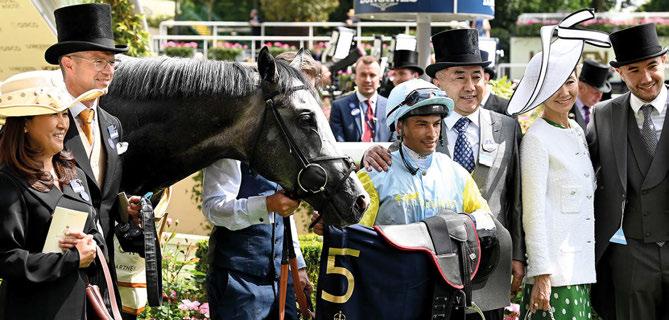
That sale came at a time of major investment by Shadwell in Dark Angel’s progeny. Between 2013 and 2019, the operation spent 9,105,000gns at Tattersalls on 36 yearlings by the sire, of which Khaadem was the most expensive colt. Group 3 winners Heeraat and Markaz, who stood for a time under the Shadwell banner at Derrinstown Stud, were also among the group but the best by far was the brilliant sprinter Battaash, whose lengthy career encompassed a pair of wins in the Nunthorpe Stakes as well as the Prix de l’Abbaye and King’s Stand Stakes.
Today, Dark Angel’s stud career
Stakes (staged this year at Saratoga as Belmont Park undergoes redevelopment).
Remarkably, the Danny Gargan-trained Dornoch is the mare’s second American Classic winner in as many years after Mage, successful in last year’s Kentucky Derby. Both are sons of Hill ’n’ Dale Farm’s impressive young stallion Good Magic, a son of Curlin who boasts 18 stakes winners out of his first two crops. In addition to Mage and Dornoch, the list includes another current Grade 1-winning three-year-old in Muth, the Santa Anita Derby winner, as well as Society Man, who landed the Matt Winn Stakes at Churchill Downs on the same Belmont Stakes weekend.
Mage and Dornoch, who also nosed out Sierra Leone to win last year’s Remsen Stakes, are two of the first three foals out of Puca bred by Grandview Equine, the nom-de-plume of Robert Clay (the founder of Three Chimneys Farm who was incidentally still at the helm at the time of Big Brown’s arrival to its roster) and partners. Grandview required some mares to support Good Magic, in whom the operation had purchased three shares, and Puca, a Grade 2-placed half-sister to top turf runner Finnegans Wake in foal to
contains 17 Group/Grade 1 winners bred off fees ranging from €7,000 to €85,000. The likes of Khaadem, Battash, Art Power, Lethal Force, Harry Angel and this year’s Group 1 Takamatsunomiya Kinen winner Mad Cool underline how speed is the overriding theme, as you would expect from the Acclamation and Royal Applause sire line. But several have stretched out successfully, including the top-class milers Angel Bleu, Persuasive and Raging Bull.
One particularly quick daughter was Mecca’s Angel, whose crowning moment came when taking the 2016 Nunthorpe Stakes for Michael Dods. A 16,000gns
Gun Runner, evidently fitted the bill. With the assistance of agents Alex Solis and Jason Litt, Grandview paid $475,000 for Puca at the 2018 Fasig-Tipton Kentucky November Sale.
The Gun Runner filly she was carrying at the time, Gunning, was also talented enough to secure black type, meaning that Puca is the dam of three stakes horses from as many to race. So the pressure is on for her fourth foal, the two-year-old Baeza, who is from the first crop of multiple Grade 1 winner McKinzie. He realised $1.2 million to Mayberry Farm as a yearling at last year’s Keeneland September Sale.
Puca is just the ninth mare to produce two American Classic winners. The list stretches back to Maggie B.B., dam of the 1879 Preakness Stakes winner Harold and 1884 Belmont Stakes winner Panique. From then on, it comprises Cinderella (1896 Belmont winner Hastings and 1898 Kentucky Derby winner Plaudit), Lady Margaret (1896 Preakness winner Margrave and 1902 Belmont winner Masterman), Ignite (1900 Preakness winner Hindus and 1906 Kentucky Derby winner Sir Huon), Leisure (Preakness winners Royal Tourist in 1908 and Holiday
yearling purchase by her trainer, she changed hands to Coolmore at the end of her racing career and is rapidly becoming a producer of note for that outfit as the dam of Content, a Group 3-winning two-yearold last year, and now Bedtime Story, who turned in one of the most impressive performances of the Royal meeting when tearing apart the Chesham Stakes.
Sons of Dark Angel have so far been a bit hit and miss at stud, although Darley’s Harry Angel is doing his bit to change that perception and young horses such as Angel Bleu, Raging Bull and The Antarctic alongside Charyn are still to come.
However, from an early stage it was apparent that Dark Angel was developing into a fair broodmare sire. Havana Grey, who is now such an important stallion for British breeding, was one of the first flagbearers in that department and Bedtime Story must now be a short order to join him on the list as a Group 1 winner. Space Legend, another progressive type who ran second in the King Edward VII Stakes at Royal Ascot, is also out of a Dark Angel mare.
Given that we’re now seeing his more expensively produced and therefore better-bred daughters coming through, expect Dark Angel to continue to thrive in this role.
in 1914), Prudery (1927 Kentucky Derby winner Whiskery and 1928 Preakness winner Victorian), Weekend Surprise (1990 Preakness winner Summer Squall and 1992 Belmont winner A.P. Indy) and Better Than Honour (2006 Belmont winner Jazil and 2007 Belmont winner Rags To Riches).
In Europe, such mares also breathe rarefied air, none more so than Urban Sea, whose sons Galileo and Sea The Stars both won the Derby, and You’resothrilling, whose outstanding record contains the winners of the Newmarket and Irish 2,000 Guineas (Gleneagles), Irish 1,000 Guineas (Marvellous) and Prix de Diane (Joan Of Arc).
Puca, for her part, has achieved her lofty standing at the age of 12. Last year, the Grandview partners decided to cash in and offered the mare back in foal to Good Magic at the Keeneland November Sale. Although initially unsold in the ring, she later changed hands in a private transaction to John Stewart’s Resolute Racing for $2.9m. She has since foaled a brother to Dornoch and Mage (who has just completed his first season at stud at Airdrie Stud in Kentucky) and is back in foal to Good Magic.

One of the aspects of broodmare care that can be easily overlooked and underestimated is the importance of proper hoof care. Broodmares may no longer need to be especially athletic or look like gleaming sales hopefuls. However, regular hoof maintenance is vital as their pregnancy progresses and they undergo weight gain and hormonal changes. The increased load placed on their hooves during this time makes them more susceptible to several hoof issues such as cracks, abscesses and laminitis.
In thoroughbred breeding, late gestation often coincides with winter when the adverse weather conditions further contribute to a suboptimal hoof environment. As a result, if extra care is not taken, broodmares can become very uncomfortable. It is a false economy to put a mare in foal but not provide her with the necessary husbandry for a successful pregnancy. In simple terms, appropriate hoof care is a vital part of ensuring a broodmare is healthy and able to produce a healthy foal.
Regular trimming of broodmares helps to keep their feet well balanced, preventing the development of cracks and splitting. If hooves become too long in length, this can alter the hoof biomechanics by changing the angles of the soft tissues and bones, resulting in increased strain. It is easier to make regular small adjustments when trimming and balancing feet, whereas leaving too long between trimmings means broodmares
can become uncomfortable after more dramatic readjustments.
Some broodmares cope well with remaining barefoot throughout pregnancy whilst others may require the extra support of shoes. In such cases shoes may help broodmares avoid soreness and bruising as well as making them less susceptible to foot abscesses. Prediction of a broodmare’s foaling date does not always go to plan but as much as possible this should be considered when organising farrier dates. Ideally, trimming or shoeing of broodmares should not be performed too close to a mare’s expected foaling date. This avoids her having to stand for the farrier when she is at her heaviest.
The metabolic and physical stressors placed on broodmares’ feet during pregnancy makes them more susceptible to diseases of the foot. Hoof abscesses are the most common cause of acute, marked lameness and many horses will develop an abscess during their lifetime. They are more common when feet are trimmed incorrectly or not frequently enough. This allows a space to form at the white line (junction between the sole and wall of the foot) which allows dirt and bacteria into the hoof.
Abscesses can also form secondary to sole penetration by an object such as a nail or as a complication from other underlying hoof problems (for example laminitis and keratomas). Broodmares that develop hoof abscesses will usually present acutely painful, are very lame on one leg, reluctant to move and bear weight on the foot. When the leg is examined, the digital pulse
is usually increased signalling inflammation and pain in the foot.
Most abscesses can be dealt with easily by your farrier or vet. They will normally examine the foot before using hoof testers to help localise the source of the pain. In some cases, further diagnostics such as nerve-blocking or radiographs may be necessary to further assess the lameness. Straightforward foot abscesses are usually treated by paring the hoof to allow drainage of pus. This can be followed by poulticing to further encourage removal of the pus. Pus is grey in colour when draining from the hoof, unlike the yellow colour seen when it drains from elsewhere in a horse’s body.
Late pregnant mares can develop episodes of laminitis. The laminae are sensitive tissues in a horse’s foot that connect the hoof wall or capsule to the underlying pedal bone. They are essential in providing support and structural integrity to the foot. Laminitis inflammation of these tissues results in weakening and stretching of the laminae. It is not currently fully understood why some late pregnant mares develop laminitis, but it is hypothesised this is the result of their increased body weight and underlying endocrine disease (Equine Metabolic Syndrome or Cushing’s disease). Laminitic broodmares often have repeat episodes and are predisposed when the levels of soluble carbohydrates (sugar) in their diet is increased. This can occur through consumption of grain and lush pasture.
Management of broodmares with laminitis will depend on the severity of their clinical signs. This can range from more simple measures, such as box rest with thick bedding, up to more dramatic treatments such as hospitalisation for sling support and intravenous pain relief. Laminitis is a very painful condition and treatment focuses on providing pain relief and supporting the hoof while addressing the underlying cause. In some cases, simple oral pain relief such as phenylbutazone or paracetamol may be adequate along with increased padding and support of the hooves. Farriery support is vital to the success of these cases and techniques such as wooden clogs, heart bar shoes, impression material, specialised boots and pads can be used to help support laminitic feet.
Laminitis in late pregnancy mares usually improves post foaling, therefore
the aim is to keep the mare comfortable until that time. Preventing further laminitic episodes can be challenging but it is recommended that the broodmare is maintained with good quality hooves, regular trimming and an appropriate body condition throughout pregnancy and that any underlying endocrine disease is adequately controlled.
Nutritional considerations
Good nutrition can assist with improving the quality of hooves in broodmares. Broodmares have higher protein and essential amino acid requirements to support foetal growth and milk production. Amino acids are also key building blocks in the production of keratin that makes up the outer wall of the hoof. It is therefore important to ensure broodmares have adequate amounts of high-quality protein during this time to maintain their hoof quality as well as supporting their pregnancy.
Biotin, a water-soluble B-vitamin, is needed for the maintenance of healthy hooves and this is produced by hindgut bacteria. Due to the increased energy requirements of broodmares in the last few months of pregnancy, it can be easy to get carried away with a diet that is too low in forage and too high in grain-based concentrates.
A regular supply of good quality fermentable forage is needed to ensure adequate production of biotin. As a guideline, mares should generally have ad lib forage and not greater than 1kg of concentrate feed per 100kg of body weight per day. Adequate amounts of vitamins and minerals such as zinc and copper are also important for hoof quality. This should be reviewed and supplemented as needed to provide a balanced diet. If suboptimal hoof quality remains despite ensuring mares have highquality protein and adequate vitamin and minerals, then it may be worth considering biotin supplementation (recommended amount is 20mg/day).
Broodmares that show evidence of laminitis, insulin dysregulation and equine metabolic syndrome will need their diets modified accordingly. This often involves decreasing the soluble carbohydrates and using other alternative sources of calories such as oil to maintain weight in late pregnancy.
The metabolic and physical stressors placed on a broodmare’s feet during pregnancy make them more susceptible to diseases of the foot. Appropriate hoof care is a vital part of ensuring the health, welfare and investment of a pregnant broodmare.
By Charlotte Easton-Jones
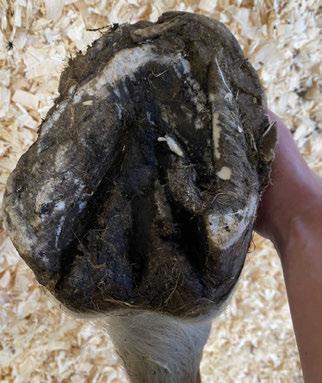
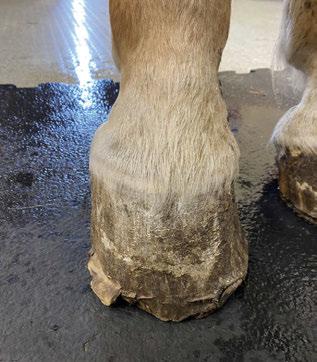

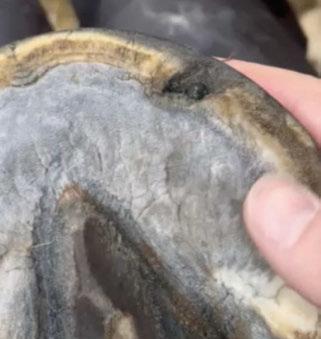

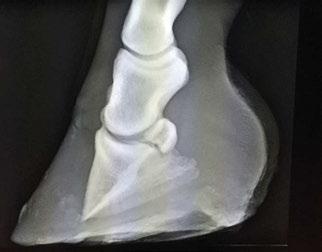

OATAALIN mix is designed to give your horse the best performance, energy and shine, as well as contributing to the avoidance of stomach ulcers in horses in training.
OATAALIN mix is designed to give horses the best of whole natural foods in three key grains: the digestibility and energy of Oats, the Calcium & Vitamins and buffer to acidity in Alfalfa.
Linseed aids skin & coat condition and is antiinammatory with slow release energy.
• Superior Rolled Oats from Highclere Estate
• Pelletised Alfalfa
• Micronised Linseed
“At Highclere we have been feeding OATAALIN to our thoroughbreds. Highly palatable, its excellent qualities are reected in the shine of their coats, their energy levels and their relaxed attitudes.”




Lily. 3YO
Lord Carnarvon), winning at Goodwood, over 1m 1f, jockey A Voikhansky, 7th June 2024.
Ofce: 01635 250600 Mobile: 07950 010692
Email: ofce@highclereestate.co.uk
Web: www.highclerecastlehorsefeeds.co.uk
Richard Hannon Jr., Pink Lily’s trainer, commented:

“Pink Lily when she came in she looked great, she has managed to put on all that weight over the winter and looks better than ever. She is a month further ahead than most of mine in her coat and I am looking forward to running her. Very happy with her indeed!”
Pink Lily (3YO) returning to training 23/1/2023 after 8 weeks of rest and being fed OATALLIN as part of a balanced diet.

I have been using NUTRI-GARD for a while now and have seen the benefts in my horses. They are eating better, holding their condition and looking really well in themselves.

Nutri-Gard is a scientifcally advanced gut supplement formulated to support stomach and hindgut health. Containing 12 key ingredients including prebiotics, postbiotics, and B-vitamins, it is designed to support the entire digestive tract.
Also features:
• Prebiotics
• B-vitamins
• Pectin
• L-Threonine
• DL-Methionine
• Oat fbre
SCAN QR CODE TO FIND OUT MORE FOR Digestive health


Words: Laura Steley
Equine Gastric Ulcer Syndrome (EGUS) became a recognised term by veterinary professionals in the 1990s. It is, unfortunately, diagnosed frequently within our thoroughbred population. Recent studies suggest that the prevalence of EGUS in thoroughbreds in training can be as high as 80-100%, between 25% and 50% in weanlings and yearlings, and up to 60% in broodmares and stallions. Although plenty of research has been carried out and excellent progress made, the syndrome is still not fully understood and is an area of active research for equine scientists.
A horse’s stomach is relatively small, around the size of a rugby ball, holding only 8-12 L depending on the size of the horse. The inside of the stomach is covered by two different types of lining or mucosa. Approximately half of the upper part of the stomach is covered by the same cells that line the oesophagus. These cells do not secrete any acid or mucus and are called squamous mucosa. The bottom half of the stomach contains cells that produce stomach acid and enzymes; this is called glandular mucosa. To protect the stomach lining from this acid, the glandular mucosa is covered by a thick layer of mucus. There is no mucus layer over the squamous lining. The area where these two parts of the stomach meet is called the margo plicatus.
EGUS is the umbrella term for the two different types of ulcers, which horses can develop in either the glandular or non-glandular regions of the stomach. The differential between the two became apparent in 2015. The discovery of glandular ulcers largely came about due to the increase in length of the gastroscopes. When EGUS first became apparent, veterinarians were using human-based endoscopes of around 2.5m in length. This provided a clear view of only the top half of the stomach (an average horse is 2m in length from nostril to stomach entrance).
As interest and prevalence increased, equine specific endoscopes became available with an increased length of 3.5m, thus allowing veterinarians a clearer view of the glandular part of the stomach. It

is important to mention that there is no definite link between the two diseases; just because the upper part of the stomach looks healthy, it doesn’t mean the lower part will be too.
Not all horses suffering with EGUS will show clinical signs. At present, the only way to obtain a secure diagnosis is by performing a gastroscopy. Researchers are always working on developing alternative or complementary ways to help diagnose EGUS; this would be of particular use for the monitoring of horses known to have the disease.
In a study published last year, researchers looked at the potential value of saliva-based EGUS testing. Two proteins, calprotectin and aldolase, were measured in the saliva of five different groups of horses, ranging from healthy horses, individuals with diagnosed EGUS, and undiagnosed individuals with corresponding clinical signs. The study found that calprotectin and aldolase can be measured in the saliva of horses using the assays validated in this study. They were demonstrated to be precise and accurate. In addition, calprotectin and aldolase showed changes in the saliva of horses with EGUS and could be considered as potential biomarkers of this disease, especially for differentiating horses with EGUS from healthy horses.
The clinical signs that have been reported in horses suffering with EGUS are varied. Some of the most common and relevant to thoroughbreds are:
• Change in eating habits – slow eating, leaving feed, pawing
• Behavioural changes – increased aggression, spooking, unsettled
• Increased sensitivity to touch
• Increased reactivity when being girthed, groomed
• Grinding teeth
• Ridden changes – disunited in canter, reluctance to go forward
• Reduced performance
• Loss of condition, dull coat
• Recurrent colic
• Loose droppings
As a general rule, research suggest that behavioural signs are more linked to EGGD, while feeding and condition changes are more likely to be prerequisites to ESGD.
Ulcers in the non-glandular region, known as Equine Squamous Gastric Disease (ESGD), occur due to damage of the poorly protected squamous mucosa via gastric acid. This can be further classified into primary or secondary, dependent on the cause of the disease. Primary ESGD is the most common and occurs in an otherwise healthy gastrointestinal tract. Secondary ESGD is due to delayed gastric outflow (emptying of the stomach) due to other pre-existing conditions, e.g. inflammatory bowel disease.
The day-to-day management of our thoroughbreds is the key determining factor in avoiding the onset of ESGD. The most important and obvious part
of any horse’s management should be ensuring adequate access to forage. Liz Bulbrook, Director of Nutrition at Baileys Horse Feeds, says: “Feeding insufficient forage/fibre and long intervals between forage feeding of over six hours increases the risk. Ideally, the horse should receive a 1.5% minimum of their bodyweight as forage per day, although this is frequently not seen in horses in training on high amounts of compound feed. Under 1% dry matter of bodyweight as forage per day increases the risk significantly.
“Dividing the forage portion through a 24-hour period is recommended, with the largest portion provided at night. The horse has a physiological and psychological need to chew, as chewing creates saliva which aids as a natural buffer to the acids in the stomach.”
A large emphasis should be placed on trying to significantly reduce the starch content of the horse’s hard feed. This is widely considered beneficial in overall equine health, not just in the prevention of ESGD. The intake of starch causes bacterial fermentation within the stomach, leading to lactic acid production. This will act synergistically with the gastric acid, thus increasing the likelihood of ESGD developing. Louise Jones, Nutritionist at Connolly’s RED MILLS, comments: “Limiting non-structural carbohydrate intake is an important part of managing horses prone to ESGD. This is why our Horse Care range of feeds, especially Horse Care Ultra which contains just 4% starch, is so popular for horses prone to ulcers.
“As well as being low in starch, all the Care Range feeds also contain a natural long-lasting gastric acid buffer and FOS, a soluble fibre, both of which have been shown to help maintain a healthy stomach pH.”
Another pivotal element, particularly for horses in training, is attempting to reduce gastric splashing during exercise. Although it is common knowledge that you would not want to provide any horse with a large hard feed directly before exercise, it is now known that exercising horses on an empty stomach is detrimental to gastric health.
Feeding just a pound of forage or alfalfa chaff around 30 minutes prior to exercise can help reduce the splashing of stomach acid, which naturally occurs as the horse moves. Racehorses are particularly affected by this due to the high intensity exercise they carry out, increasing the severity/duration of gastric splashing. Bulbrook adds: “Alfalfa is rich in calcium and magnesium, which are natural buffers (antacids). A small amount
of alfalfa chaff before exercise helps to form a physical fibrous raft on top of stomach contents and helps protect the upper squamous region from acid splash during physical activity. Baileys Alfalfa plus oil would be suitable in these cases.”
Ensuring free access to clean and fresh water is essential. Water intake dilutes gastric acid, therefore water deprivation will increase gastric acid pH levels. If your horse is in work, consider feeding fat-coated electrolytes, as ordinary electrolytes can cause or worsen gastric ulcers. This is a benefit as the coated electrolytes will be more readily absorbed in the small intestine (rather than the
“Exercising horses on an empty stomach is detrimental to gastric health”
stomach), and the fat coating is much gentler on the stomach lining/existing ulcers.
The use of anti-inflammatory drugs (NSAIDs) has been associated with the onset of EGUS, particularly in relation to high dosage and/or prolonged use. There is some evidence to suggest that use of NSAIDs in fasted horses can pose an increased risk, however, on the whole the subject requires more investigation. It is always sensible to discuss the use of NSAIDs with your vet, particularly if you deem your horse to be high risk.
The second, less understood type of EGUS is Equine Glandular Gastric Disease
(EGGD). The glandular region of the stomach contains glands that secrete pepsin and acid but also bicarbonate and mucus, which form a protective layer. The condition seems to be due to gastric inflammation. The cause of this inflammation is hard to pinpoint due to its sporadic occurrence in varied individuals. Unlike EGSD, this disease is yet to have any clear treatment guidance. Studies present conflicting evidence and further work is required and ongoing. The causation for EGGD is thought to be much more behavioural based, with horses that are pre-disposed to a higher stress response at greater risk.
Although EGGD can occur without the presence of ESGD, research has indicated that horses with grade 2 ESGD or above are five times more likely to develop EGGD than unaffected horses. Warmbloods appear to be pre-disposed to EGGD compared to other breeds, suggesting a genetic factor. There has also been research to suggest that increased frequency of exercise (not intensity) can increase the risk of EGGD ten-fold. This poses the question of, in some individuals, is exercise an example of physiological stress on the glandular mucosa? Clinical signs can be misleading, as many are generic pain-related behavioural responses and thorough investigation is required.
All horses thrive on routine, whether they possess an increased stress response or not. As equine professionals, our management practices should revolve around as little routine disturbance as possible. The demands of our industry can make this a tall order.
Julian Dollar, General Manager of Newsells Park Stud, says: “We are mindful of the risk factors associated with Equine Gastric Ulcer Syndrome and we try to manage our horses accordingly within their own environment by keeping to a very regular routine, where there is

From ultra low to traditional levels
A range of options to suit diferent degrees of gastric sensitivity
All designed to fuel performance and recovery

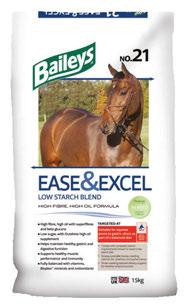
12.5
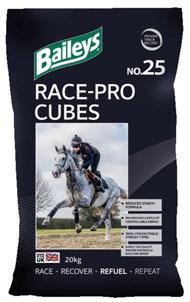
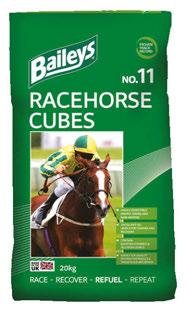
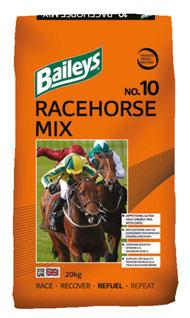
always access to fresh, clean water, and employing a well thought out feeding regime.
“The sales yearlings will continue to have daily turnout and time to graze, and we base their nutritional programmes around good quality fibre sources and the careful choice of appropriate feeds throughout their prep. We watch out for individuals with any clinical signs and continue to pay close attention to detail.”
The appropriate treatment will be prescribed by your veterinarian dependent upon the severity of ulcers seen. ESGD lesions will be given a score of 0 – 4; EGGD lesions are more difficult to assess and do not have a universal grading system at present. Often, they will be noted down by individual appearance.
ESGD is very effectively treated by switching off acid production. Omeprazole, only available via your veterinarian for treatment of ESGD, is hugely effective with numerous studies detailing its success. It can be used as the sole treatment for ESGD; three to four weeks of omeprazole usually provides excellent ulcer healing. Repeat gastroscopy is advised to ensure full healing before stopping treatment.
EGGD is more of a conundrum when it comes to effective medicinal treatment. Even though EGGD is not a direct result of acid injury to the mucosa, acid suppression still has an important part to play. This is due to the thought process that glandular lesion healing will be inhibited via the presence of acid, therefore we should try to decrease the pH level.
There are different schools of thought regarding suitable medications, all of which are undergoing further testing as our knowledge and data increases. Omeprazole, in this case, can be used in combination with sucralfate for a longer period of time (usually 6-8 weeks or more). Sucralfate has a dual purpose of improving blood supply to the mucosa helping mucus production, as well as forming a layer of gel over the lesions. Misoprostal can also be used for its increased blood supply and acid suppression qualities. Combinations of drugs have had varying effects in the treatment of EGGD. It must be considered that behavioural traits of the individual will have a part to play and cannot always be managed appropriately.
Dollar adds: “Our main consideration is to try to prevent ulcers from forming in the first place, but if we do need to use any treatment, we consult with our
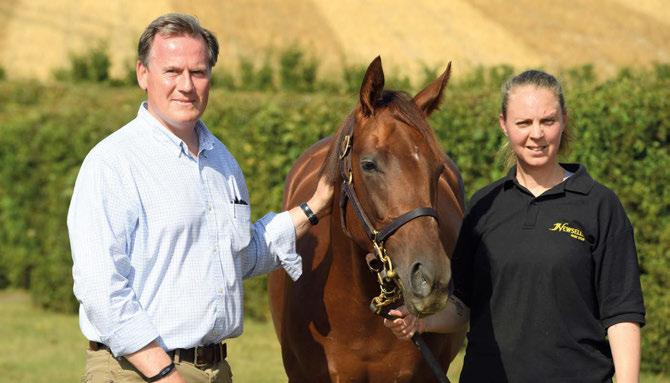
veterinary team about best practice and efficacy of medication – omeprazole, and possibly misoprostol – for horses with signs of concern.”
Prevention is always preferred over cure. Around only 5% of non-glandulous ulcers will heal spontaneously – following medicinal treatment there are ways in which we can support recovery and help to sustain the absence of ulcers via an appropriate nutritious diet and targeted supplements.
The chosen ingredients for ulcer supplements are going to help coat/ protect the stomach lining, act as buffers (decrease acidity), help stomach lining repair and supress acid formation. Common buffers include ingredients such as magnesium carbonate, magnesium hydroxide, limestone (calcium carbonate), marine algae, magnesium oxide and sodium bicarbonate. Some horses may exhibit symptoms that are linked to issues within the hindgut, such as mild bouts of colic and loose droppings. If this is the case, a high dose of live yeast pre and/or probiotics can be of great help.
A variety of evidence supports the use of ingredients such as lecithin and pectin (coating agents), sea buckthorn, vitamin E & C, ficus glomerata extract and thioredoxin (repairing agents) for gastric ulceration. Bulbrook agrees, saying: “Consider using gastric supplements, or feeds, such as Ease & Excel that contain antacids, pectins, beta-glucans, pre and probiotics which support a healthy gastrointestinal lining and overall gut health and efficient digestion. Feeds such as soya hulls, beet pulp and alfalfa are rich sources of pectins and have been shown to have acid-binding properties.”
There are many supplements available
on the market, some of which may not prove to be effective. As a rule, always look for products that have been recommended or backed-up via clinical trials – and purchase products from companies that are part of the BETA NOPS scheme. You can expect to see an improvement in symptoms within 7-10 days, but changes can be seen within a few hours after feeding, dependent upon the severity/type of EGUS and the main aim of the chosen supplement.
The more we can do to manage our horses in the most natural way, the better chance we have of avoiding EGUS developing. Carefully considering energy requirements and how we meet the individual’s need is hugely important. Bulbrook says: “Ensuring the overall diet is nutritionally balanced with quality protein and calcium can have a beneficial effect to gut health. A balanced diet also ensures support for the immune response and general metabolism.”
Pre-empting stressful life periods (weaning), performing gastroscopy sooner rather than later, paying attention to behavioural changes, and allowing as much pasture turnout as possible are all pivotal points. There are forms of Omeprazole, with the view of preventing ulcer formation during periods of increased stress e.g. before travelling or sales, which can be purchased over the counter. Jones concludes: “As a nutritionist, I cannot overemphasise the importance of adequate forage intake in the prevention and management of gastric ulcers in horses.”
Further information: Vokes J, Lovett A, Sykes B. Equine Gastric Ulcer Syndrome: An Update on Current Knowledge. Animals (Basel). 2023 Apr 5;13(7):1261. doi: 10.3390/ani13071261. PMID: 37048517; PMCID: PMC10093336.
A low starch diet is recommended for horses that sufer from chronic, recurrent tying up and persistent gastric ulcers. As a cereal grain free feed, Horse Care Ultra Cubes:
ULTRA-LOW STARCH
4%
Support healthy gastric balance with the inclusion of yeast, the prebiotics MOS and FOS, and a long-lasting gastric acid bufer
High quality protein and essential amino acids aid condition and topline, muscle function, and recovery
We’ve had great success since moving our yearlings and 2 year olds onto the Horse Care Ultra Cubes. The high protein but low starch is great for the young horses introduction to training, keeping them in good condition as well as level headed as their workload increases; I wouldn’t start them on anything else now. It’s important for me to know that the younger horses have good quality protein in their diet to help them develop whilst also getting all of the vitamins and minerals they need.
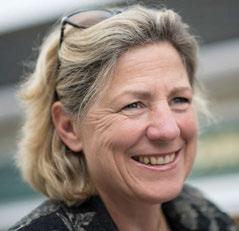




The British Horseracing Authority has announced the introduction of a new licence for racehorse syndicators and racing club managers, which aims to further strengthen the regulation of shared ownership.
The new licence is part of a range of wider efforts to promote the continued growth of shared ownership by giving those involved increased confidence in how syndicates and racing clubs are managed and regulated.
Its introduction follows an extensive period of engagement with stakeholders, including an industry-wide consultation, to ensure that the regulation keeps pace with the increasing appeal of syndicate and racing club membership.
The licence will apply to anyone wishing to manage a syndicate or racing club that advertises publicly or that they are paid to administer. This includes licensed trainers who run their own syndicate or racing club.
Existing syndicators and club managers will be required to have a valid licence in place by January 1, 2026, while anyone applying to set up a new syndicate or racing club after January 1, 2025 will need to ensure they have already been granted a licence.
The BHA has already contacted syndicators and club managers to help ensure the new licence is introduced as smoothly as possible, with step-by-step guidance to support the application process. Ongoing assistance will also be available via the BHA’s ownership team.
The new licensing process builds on the existing registration and regulatory requirements, ensuring that the minimum standards expected by the BHA are clear, understood and met by anyone with financial responsibility for a syndicate or racing club. It will allow the BHA to evaluate applications more thoroughly, assessing key areas such as business competence and an understanding of how to properly advertise and promote shared ownership.
Through the application process, the BHA can also offer applicants additional support and more consistent guidance, with increased clarity about the role of a syndicator or racing club manager and the requirements placed on them under the Rules of Racing.

The licence does not seek to interfere with the commercial business or stipulate how a shared ownership entity should be run as long as it meets the requirements of the licence.
Louise Norman, ROA Interim Chief Executive, said: “We welcome the BHA’s introduction of a new licence for syndicators and racing club managers. This initiative is a significant step forward in ensuring the integrity and transparency of shared ownership in British racing. By establishing clear standards and providing thorough oversight, the new licensing process will not only protect current members but also attract new participants to our sport with greater confidence.
“The ROA fully supports this proactive approach to regulation, which will help sustain the growth and appeal of syndicates and racing clubs for years to come.”
Harry Williams, the BHA’s Head of Participant Services, said the introduction
of the new licence represented “an important step forward as we look to retain racehorse owners here in Britain and attract the next generation”.
He continued: “The vast majority of syndicates and racing clubs are operated to the very highest standards, but inevitably as the number of people involved in setting up, running and promoting them continues to rise, so do the associated regulatory challenges.
“By introducing this new licence, the BHA can take a more proactive approach to managing emerging risks and maintain consistent standards across the board. This will not only provide greater clarity for syndicators and club managers about their role and responsibilities, but also help maintain trust in shared ownership by ensuring those involved feel confident that they are sufficiently protected and supported.”
More information about the licensing process is available on the shared ownership page of the BHA website.


Concern from members regarding the fees charged to owners is something we hear about a lot in the ROA office and when out on the racecourse. From the transparency of BHA charges to jockeys’ fees, it is at the forefront of our thoughts as an association, especially with belts being tightened because of more mainstream cost increases.
Here we review the fees you will regularly see on your statements, look at how they are changing, and explain how the ROA Board has been working on your behalf to reduce costs for owners.
A review of the BHA fees relating to registering as an owner and the ongoing costs was undertaken by the BHA in direct consultation with the ROA and others to streamline and simplify owners’ charges. The resultant plans are to introduce a new structure as follows:
• Joining: all fees to register as an owner – sole, company, partnership, syndicate or club – have been simplified via the new Racing Digital platform, along with reduced fees including sole owners being free of charge.
• Annual fees: these fees will be charged based on whether you are active or inactive. Therefore, an annual one-off fee will be charged. This will replace fees such as authority to act, VAT registration and sponsorship registration for active owners. A standard annual fee will be charged for owners that are inactive but want to remain registered with the BHA.
• Additional: a small number of fees will remain outside the annual fees, including registration and re-
registration of colours and naming fees, as these are not required by all owners at the point of registering with the BHA.
• Race: the current entry handling fee will be replaced with a split entry/ declaration handling charge, with a view to reducing costs for owners at the entry stage when they are less certain of running. It is also envisaged that this approach for owners averaging two entries per run would cost the same as now, and for owners with a higher number of entries per run (i.e. three entries per run), this model will cost them less.
This structure has been crafted to simplify and create transparency in relation to the costs that are part of the BHA regulatory function. It is also intended to encourage owner registrations and with easier understanding of the associated costs from the start of your ownership journey.
The BHA’s new technology platform will be rolled out to implement these new fees. The aspect specific to owners is scheduled for release in late summer and we will ensure owners are kept updated on this over the coming weeks.
The BHA released a blog regarding their new fee structure in August 2023, which the ROA shared and can be found at https://www.britishhorseracing.com/ serving-racehorse-owners-part-1/ Jockeys’ fees
The last increase in jockeys’ riding fees was agreed in February 2024 and followed significant levels of discussion between the ROA and PJA. The ROA Board ratified a below-inflation increase of 3.1%.
Prior to this, the ROA had negotiated
a reduction on the contribution to the Professional Riders Insurance Scheme (PRIS), which is also paid for by owners. The scheme was created in 1974 and provides licensed Jockeys, apprentices and conditionals with income benefits in the event of temporary disablement and capital benefits in the event of death or permanent disability.
The scheme is financed by a fixed surcharge on riding fees, payable by owners in accordance with the Rules of Racing. From December 1, 2023, this was reduced to 11% from 13%. The annual saving to owners through this reduction being applied is £305,000.
Owners also support the Career Ending Insurance scheme (CEI). This scheme provides a lump sum benefit to a jockey in the event of a career-ending injury. This is also funded through a levy on each riding fee of £4.50.
As a part of these discussions, it was agreed with the Professional Jockeys Association that there would be an increase in the per ride fee for CEI from £3.91 to £4.50 in order to meet the expected shortfall in funding for the CEI scheme. This would see an additional £50,000 cost to owners.
Combining both areas, the net annual savings to owners to date based on the above changes is £255,000 and the ROA Board members will continue to review the costs further over the coming weeks in collaboration with the PJA and BHA.
It has been agreed that the industry, led by the BHA, will review the distribution of funds relating to industry charities and non-commercial programmes (e.g. horse/human welfare and industry training). These are in part made by owners through entry and declaration fees and are collected centrally and then distributed accordingly.
We appreciate that owners do not have a clear understanding of these costs and how the funds benefit the charities and the sport’s sustainability directly.
The ROA therefore welcomes this review and will be working closely within the industry to ensure owners are represented and direct views are sought before any future agreements are made. The review will take place in 2025 to allow for the completion of the Racing Administration system into Racing Digital.
What is/was the day job?
I am a Business Angel, funding start-ups in the medical and medical device fields. I built up several companies in this area after I started working for myself in 2007, and when I sold them, I decided to invest again, becoming a Business Angel. It allows me to give something back to the industry, whilst also understanding the problems and pressures associated with start-ups. I am able to mentor those involved as well as contribute financially.
Why did you get involved in racing politics?
I have essentially retired, as I am no longer looking for new businesses to invest in. However, I missed being busy and wanted to get involved in something whereby my opinion would be sought and valued. I saw the article in Owner Breeder looking for prospective Board members and I saw it as my chance to give back to racing, which has been good to me. As an owner, I know what a huge investment we make in racing and that it is often not commensurate with the rewards on offer. Members pay their subscriptions in order for us to fight their corner – I hope to encourage us to stand up for ourselves and have a firmer voice.
How has your background/upbringing influenced your views?
I was brought up in Walthamstow, as the youngest of four children. My mother worked at Hackney and Walthamstow dog tracks – settling dividends for the Tote with mental arithmetic - long before computers did the job, so betting and gambling were around me as a child! I was brought up to respect others, treat everyone the same, and believe that I am no better or worse than anyone else – a perspective that has set me in good
›› Racing account fees
We have highlighted in Owner Breeder the benefits of owners re-evaluating their racing bank account options and how switching to a different account could save money.
The ROA has produced a table which compares the account options currently available to registered owners. Further
stead in the business world. I would like to think I am also carrying this into the racing sphere as well.
How long have you owned horses and how much success have you had?
After I relocated back to the UK from Dubai, I went racing for the first time with a work outing. It was that introduction at Newmarket’s July Course that made me fall in love with racing. Within a year I had joined a syndicate, and more rapidly followed! I first became a sole owner in 2000 with The Cottonwool Kid, who won his first race in my colours.
Probably my favourite horse has been Broke Road. He was only small, but he tried so hard and won nine out of his 46 races for me over jumps. On the Flat I have been lucky enough to have shares in the winners of Listed races with Russian Punch and Vintage Brut. But as with all owners, I have also experienced the loss of a horse, and the frustrations of needing to be patient with one.
What do you love/hate about racing? I like the buzz of being at the races, whether it’s Fakenham or Royal Ascot. I’ve had runners at both and they can equally give a great thrill. Not only is racing a great leveller, it also confirms my outlook that we are all equal on or under the Turf. I don’t necessarily hate anything about racing but do have the usual infuriation about prize-money – which I believe needs to be distributed more evenly – and on the various fees which always seem to hit owners. There is a balance to be struck, which means the owner does not always foot the bill.
What are the priorities for the sport? The sport must be properly financed.
details and a comparison table can be found on our Racing Accounts webpage at https://bit.ly/3VUPagf
We are also aware of the growing frustrations felt by owners relating to the account options available and the fees incurred. The ROA will provide a further update over the coming weeks within our Inside Track digital email communication
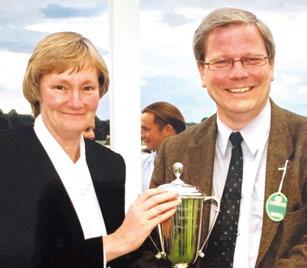
The recent levy problems have highlighted that there is only a finite income and prize-money will not be growing any time soon – yet costs keep going up. Unless you are at the top of the pyramid, owners get a poor return on their investment and it’s our job to change that.
Racing, and racecourses in particular, need to embrace and welcome syndicates – they are the future of ownership because of the rising costs of owning, and are where most sole owners start their journey.
Which horse would you most like to have owned?
Probably Antonin or Docklands Express; it was another one of those good days on track which lives long in the memory. It was the 1994 Racing Post Chase at Kempton and I got the forecast up!
What is your favourite day’s racing?
My wife and I were invited to a corporate outing to Ascot. No one really had any idea about racing, so I showed them around and gave them pointers. I managed to tip the winners of the first five races and a horse that placed in the sixth and never had to buy a drink all day!
What is your racing ambition?
Simply to leave racing in a position better than I found it.
and in next month’s ROA Forum. Whilst we have been at the forefront of discussions on these topics, there is more work to do on your behalf to lobby for a fair deal for owners. We will ensure that we keep members updated but if you have any feedback or thoughts relating to owners’ costs, please do let us know at info@roa.co.uk.

This month’s Bid to Give auction item, available exclusively to ROA members in partnership with Racing Welfare, is a Jane Braithwaite Fine Art commission of your horse or pet, to be painted in oils on either stretched canvas or board (to be advised by client) worth £1,500.
The painting can be up to 24” x 30” including frame and will be painted from images you supply (permission to use photos as reference for a painting must be acquired from
the photographer due to copyright regulations).
Additionally, the package includes hospitality for two at Racing Welfare’s Aintree lunch supported by the ROA on April 3, 2025, where the painting will be presented by Jane.
All funds raised as always will go towards Racing Welfare’s vital work in supporting all of racing’s people. Head to www.bidtogive.co.uk to place your bid before the closing date of 29th July.
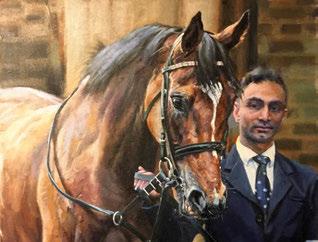
Treatment provided by Racing Welfare has helped a dedicated work-rider to reduce pain levels, improve mobility and get back to work following an injury sustained while riding.
Jo Budd, 47, who has dedicated her career to the racing industry and worked for the past 29 years at Chamings Racing in Hampshire, has been receiving physiotherapy through the charity’s Occupational Health Service.
Jo sustained an injury at work in February 2024, when a filly she was riding bucked and spun. To stay on the horse to prevent a fall, Jo pulled on the neck strap but in doing so, she pulled her rotator cuff.
Jo said: “I initially tried to carry on riding for a couple of weeks after the injury, but the pain just got too much. I was unable to lift my right arm and it was painful trying to canter horses. I went to see my doctor, who signed me off work for two weeks.”
It was then that Jo was put in touch with Racing Welfare.
She continued: “Racing Welfare were very helpful, and physiotherapy was arranged for me at Oaksey House. So far, I’ve had seven sessions and am still ongoing with the treatment. It has definitely helped me by exercising in the gym at Oaksey House and making my shoulder stronger. Lifting my arm to put a bridle on for example is definitely getting easier and riding is no longer painful, thankfully.
“Physio can be really expensive, so it’s great that I have been able to
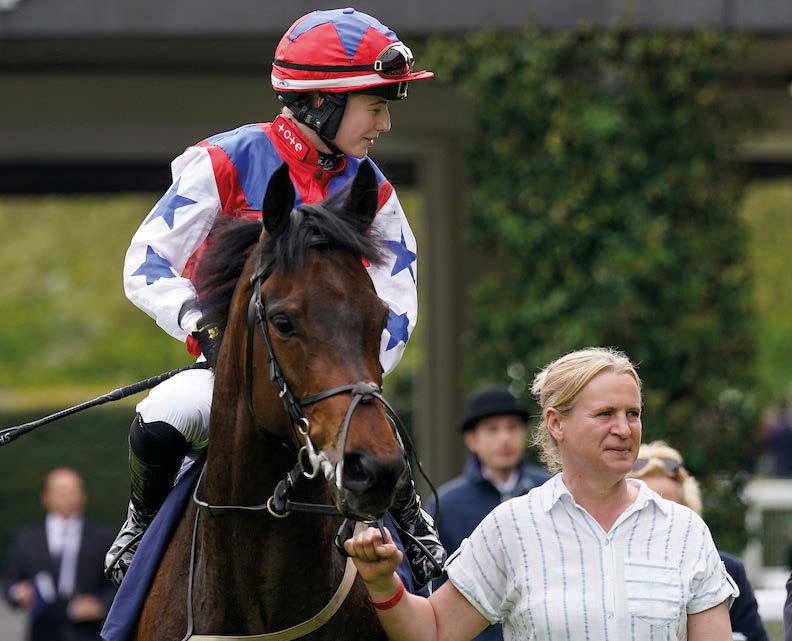
access this treatment for free thanks to Racing Welfare – it has made a massive difference.”
Racing Welfare delivers the service as part of its award-winning Workforce Wellbeing Programme. The programme exists to support the overall wellbeing of people working in the British horseracing industry through a comprehensive range of services.
To say thank you for the support
she receives from Racing Welfare, Jo is taking part in two fundraising events: a charity race at Newbury racecourse as part of Racing Staff Week (June 22-28) and Racing Welfare’s Jurassic Coast Challenge in September – a stunning 20-mile hike along the South West Coast Path from sunrise to sunset, starting at the incredible Durdle Door and finishing in Swanage.
If you’d like to join the walk, go to racingwelfare.co.uk/events to sign up.

Racehorses can improve at any age and for a variety of reasons, yet the progress shown by Jacquelina has owner Trevor Johnson and trainer Phil McEntee somewhat stumped.
The five-year-old mare had a rating of just 54 when she confounded connections’ expectations by winning on heavy ground at Windsor in early May. Over the next month she won a further four times from five starts, finishing second in her other race as her mark rocketed to 82, igniting dreams of black type.
For Johnson, 72, who entered the ownership ranks after a winning run at the poker table, Jacquelina’s story has added significance. The retired florist named her in memory of his wife, Jacqueline, who passed away in September 2021.
He explains: “I had a horse called Gentlemen who sadly died one evening at Chelmsford. In 2022, Phil phoned me to say that the breeder of Gentlemen, Nicola Kent, had a three-year-old filly
out of his dam’s sister for sale. I agreed to buy her.
“When she won her first race at Chepstow in June last year, I wasn’t planning to go but Phil said he thought she would win. It was a very emotional moment.
“My wife’s name was Jacqueline –that name was available – but I used to call her Jacquelina if I wanted something! It sounded like a better name for a racehorse.”
Johnson continues: “She didn’t do too much else in 2023 but won at Wolverhampton earlier this year.
“When she ran on heavy ground at Windsor, Phil said she wasn’t at full fitness – he said she couldn’t win and might be tailed off as she would hate the ground! She won that and then the sequence went on and on.
“Jacquelina won a further four times in four weeks. In her last race at Chepstow, she was saddled with 10st 7lb, having been beaten the day before at Thirsk, and still won by three and a half lengths!”
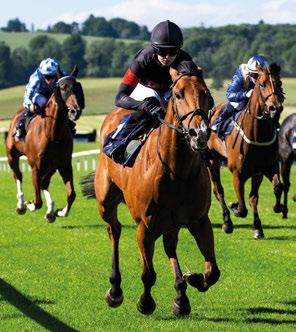
Improving 28lb – or 2st – is no mean feat for any runner. So how has the trainer explained the rapid progress to his owner?
“He hasn’t!” Johnson says. “But I remember Phil phoning me in January to say that Jacquelina is the best horse I own – I currently have six in training with him – because he thought she was an 80 horse. He said he could feel the power when he sat on her in the stable.
“She used to be a bad traveller – if there was another horse in the box, she would kick all the way to the races. If she travels on her own, she’s quiet.
“Jacquelina is having a holiday now,
certainly for a few weeks. She’s won on good to firm and heavy but is perhaps better on softer ground. I think she could get black type on testing going.
“You do see horses that have been plotted rising up the handicap, but very rarely with a mare like her.”
Johnson’s black and red silks – he initially ran horses under the Eventmaker banner before racing under his own name in 2017 – have also been carried with success by the likes of Porfin and Alafdhal. The owner enjoys betting on his horses but has been heavily restricted by some bookmakers online.
He says: “I’d rather lose £100 than see my horse win and not have a penny on them. Having a bet is important to me as an owner.
“At one point every account I had was closed down. One account was closed after I had a bet on a horse that was backed from 8-1 to 3-1 – it wasn’t even placed!
“Jacquelina has certainly surpassed all my expectations”
“Now I bet in shops and actually find it easier. You get to know the staff and I can usually get £50 on each-way. It seems to have changed for the better recently.”
Born and bred in Coventry, Johnson played golf professionally for a few years in his youth. His father’s company, stationery firm Tallon, sponsored the shirts of Coventry City FC between 1983 and 1984.
When Coventry beat Spurs 3-2 in the 1987 FA Cup Final, Johnson – he is still a director in holding company Zintello – and his staff at Tallon were there at Wembley to see the famous upset.
He doesn’t go to football much these days, but you can be sure he’ll be back on a racecourse when Jacquelina returns to training with McEntee, who was recommended by a friend in Newmarket when the owner was looking to move on from Julia Feilden.
Thoughtsofstardom and Luloah won plenty of races between them in the early days of the partnership; his father’s estate owns Racefield Stables on Hamilton Road, where McEntee trains.
Johnson, who has had a winner over jumps but prefers the thrill of sprinting, says: “I had a horse called Philippine Cobra who won a premier fillies’ handicap at York in 2019, which was great.
“However, the Jacquelina story is magical because I named her in memory of my wife. It’s unbelievable really.
“We don’t know where she’ll end up, but I don’t think she’s finished at 82.”
He adds: “It’s easy enough to buy a horse but it’s an achievement to get one to win. Jacquelina has certainly surpassed all my expectations.”

How was your Derby day? Was it the highlight of your day? It was for me, but Epsom is my local course and we live just a short walk from the mileand-a-half start. However, for many people, the Derby is no longer the highlight of their day and if we believe what the media is telling us, it has slipped down the rankings of what the public want to do on the first Saturday in June.
So, what can be done to restore the event to its former glory? There are traditionalists that hanker for a return to a Wednesday Derby. But it is 30 years since the colts’ Classic was last run on the first Wednesday of June and expecting it to slip back seamlessly into its former midweek slot may be too much of a risk.
The Jockey Club said it wants to extend the Derby meeting to a weeklong festival. Quite how that will be organised is still to be determined, but it makes sense to make more use of the course, as it must be costly to build the temporary hospitality marquees for just two days’ racing. It is rumoured that the Oaks could be moved to a Saturday, with the Derby taking place the following Saturday and an additional Coronation Cup meeting in between, possibly on a Wednesday. I agree with moving the Oaks, as Epsom should have more than one Saturday meeting a year, and it would allow the fillies’ Classic to stand on its own and not be seen by many as just an hors d’oeuvre to the main event the following day. However, I’m not convinced that a Saturday/ Wednesday/Saturday would work.
Racegoers are creatures of habit and those that have been regular attendees at the two-day Derby Festival in recent years may not be able to, or want to, attend three separate days spaced apart, particularly those that travel a considerable distance and make a weekend of it. As a regular attendee at the festival meetings, would I go to more than one day if Cheltenham, Newmarket, Ascot, Goodwood, York etc had gaps between racedays? Probably not, or if I did, I would travel there and back on the same day,

therefore impacting revenue for local hotels and restaurants. The Jockey Club need to think very carefully before deciding on the format for the new Derby Festival.
The Jockey Club’s plans for the Derby got me thinking. Is it best positioned to attract newcomers into the sport? The organisation has commercial drivers that may not be best aligned to attracting new racing fans. Its recent record of managing the Cheltenham Festival has come in for much criticism. So, should we as racegoers take more responsibility to promote the sport we love to friends and family?
I asked myself – what have I done in the last year to encourage friends and family to go racing?
I organised trips to Sandown for the Eclipse and Tingle Creek meetings for a group of eight of us, mainly old school friends. Four of us attended the Tuesday and Wednesday of the Cheltenham Festival, and another four went to the Dublin Racing Festival. Two of my grandchildren came with me to Kempton on Boxing Day and it’s that younger generation that we really need to encourage if racing is
to flourish. I like the idea of getting youngsters more involved in racing. ITV’s Ed Chamberlin often talks about taking children racing; it’s an easy sell as they get in free and most racecourses have a family day each year, where fairground rides are often free.
Thinking back to how I first got interested in racing, it was my mum telling me that Arkle was running and that we were all going to watch him on the telly, as he was the best horse in the world! On a Saturday, my dad always had the racing on and when Red Rum won his first Grand National, that was the clincher.
On Derby Day, we hosted a BBQ for friends and family. There were 12 children under the age of 13 and they saw City Of Troy close up at the start. After watching the runners exit the stalls, they couldn’t wait to get back to the house to watch the race and see how the horse they picked in the sweepstake got on. The prizes for the first three were bags of sweets. But the prize for racing could be so much more if those youngsters remember the afternoon they saw City Of Troy as the day a lifelong passion began.


The TBA National Hunt Breeders’ Awards Evening celebrated its tenth iteration on May 20 and there was much to celebrate on the evening, which started with a reception sponsored by Alne Park Stud, followed by a dinner that preceded the awards ceremony.
The Queen Mother’s Silver Salver is the highest honour bestowed by the NH Committee and at the Goffs-sponsored evening, Nick Luck was suitably surprised to be announced as the winner and was given a rousing standing ovation by the 150 attendees.
A member of the TBA’s NH Committee for many years, Nick, a breeder under both codes, has steered each of the Awards evenings to date, as well as been the compere at the previously held foal shows at Bangor-on-Dee.
He commented: “I was absolutely not expecting that, and I am bowled over. Thank you to all of you for your support. I am very privileged to work in this industry – I love all parts of it and thanks to a very supportive family I am allowed to keep doing it.
“This room tonight represents the very best of this industry. We have heard from people who have bought horses for relatively little money and have ploughed good money after bad for generation after generation in the hope that one day one of these wilting flowers will bloom into a magnificent rose and it’s happened to so many people.
“We’ve heard such inspiring stories here this evening and as a broadcaster, I am just lucky to communicate these stories to what we hope will be an ever-growing audience.”
Another big winner on the evening was Will Kinsey. He picked up the Overbury Stud Trophy for the leading NHF horse on account of the performances during the season of Romeo Coolio, a son of Kayf Tara. Later in the evening, Kinsey, along with David Futter, was presented with the Mickley Stud Trophy for High Class Hero, who was crowned the leading novice hurdler.
David and Kathleen Holmes, as well as Alan and Anna Varey of Batsford Stud, were celebrating following the announcement that Passing Glance had captured his first Whitbread Silver Salver, awarded to the leading active Britishbased stallion (prize-money won).
One of Passing Glance's most important winners last season was Strong Leader and the Rainbow family-bred sevenyear-old was crowned leading hurdler. His connections were presented with the Shade Oak Stud Trophy.
Sponsored by the Holmeses and named in honour of Midnight Legend, the leading chase mare winner on the evening was the Thurles Listed winner and Cheltenham Festival third Marsh Wren. Bred by the late Renee Robeson, the eight-year-old is a daughter of Schiaparelli, who was the recipient of the Horse & Hound Cup
(individual chase winners) for the fourth successive time.
The leading chaser award was this year sponsored by Highflyer Bloodstock and Edwardstone retained his hold on the title. The son of Kayf Tara was bred by Robert Abrey and Ian Thurtle.
In celebration of the previous winners over nine years, a hall of fame was set up, along with a celebratory video. Amongst those highlighted was Cue Card, who was bred by Rowland Crellin, and the Wales-based breeder was the recipient of the Batsford Stud Trophy, awarded to the leading novice chaser for Embassy Gardens
Sarah Jane Turner was a proud recipient of the Peel Bloodstock Trophy. Casa No Mento, whom Turner bred, was named leading novice hurdle mare, whilst the leading hurdle mare was judged to be Luccia. Anthony Bromley was on hand to pick up the Yorton Trophy on behalf of breeders Pump and Plant Services Ltd.
The Eric Gillie Ltd Trophy was awarded to Kevin and Anne Glastonbury, small breeders who had achieved plenty of success during the season, including with the mare Lunar Discovery. Her dam, It’s A Discovery, was one of the three candidates for Broodmare of the Year. This award was won by Annie’s Answer – represented by You Wear It Well, Answer To Kayf and Audacious Annie – and Jane Makin was on hand to collect the Dudgeon Cup, sponsored by Elusive Bloodstock.


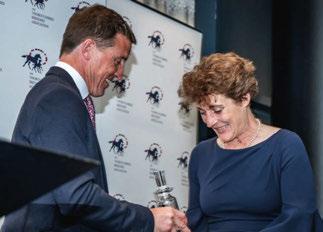



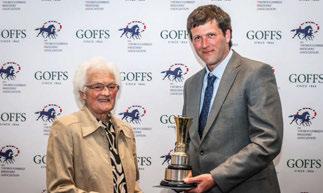
TBA National Hunt Committee Chairman Simon Cox said: “The NH Breeders’ Awards Evening is a key event within the NH breeding community and provided us with some wonderful and inspiring stories.
“As ever, these Awards have been hosted superbly by Nick Luck since inception and we were delighted to present him with the Queen Mother’s Silver Salver. Each year, Nick flies back from covering the Preakness for this event, and we are grateful to him for steering and ensuring the continued success of the Awards each year and his ongoing commitment to promoting NH breeding on a global scale.
“Not only did we celebrate this year’s winners and the shortlisted candidates, but we also looked back at the successes that British breeders had achieved over the past nine years – amongst them Cue Card, Thistlecrack and Honeysuckle. Success breeds success and with improved Britishbred NH foal crops coming through, British breeders’ successes will be even greater and equally celebrated.
“Finally, thanks to Goffs, for its continued support of the event, to Nick Luck for hosting, Alne Park Stud for the champagne reception, and to each of the evening’s sponsors whose support is greatly valued and appreciated.”

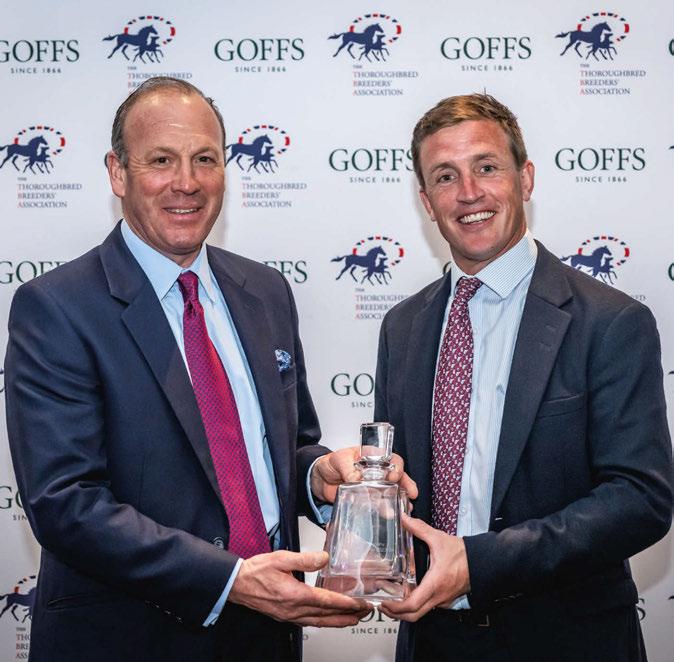
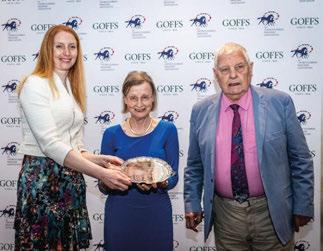
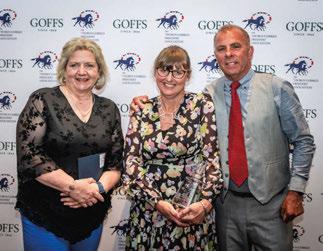
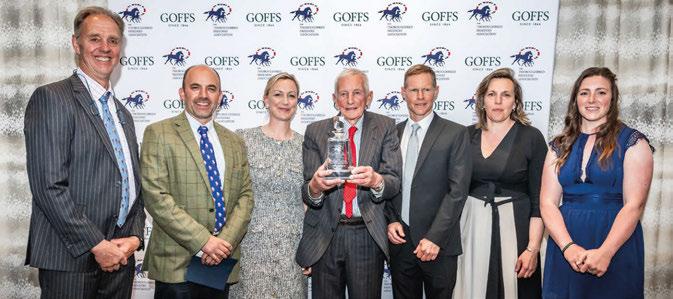

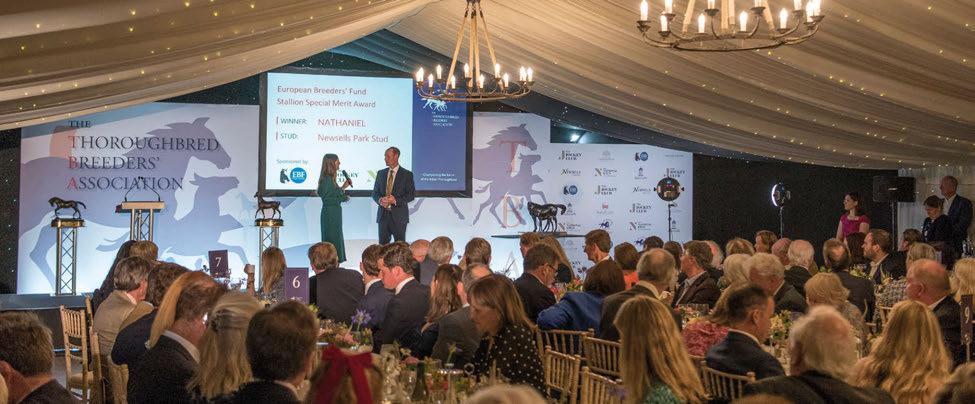
Tickets are now on sale for this year’s TBA Flat Breeders’ Awards Evening, which will take place on Wednesday, July 10 at Chippenham Park, near Newmarket. The event, which takes place ahead of the July Festival, celebrates British-bred successes from the 2023 Flat season, and will be hosted by Gina Bryce.
Breeders, owners, trainers and enthusiasts are welcomed to the Dullingham Park-sponsored event, which includes a drinks and canapes reception kindly supported by Newsells Park and
Chasemore Farm, followed by dinner and the awards ceremony.
A total of 13 awards will be presented during the evening, including the prestigious Andrew Devonshire and Dominion Bronze awards.
The TBA would like to thank Dullingham Park, Newsells Park, Chasemore Farm, Tattersalls, EBF and Barton Stud for their support.
Tickets are available on the TBA website’s events page and are priced at £80 per person.
TBA regional representative Stuart McPhee is the first small breeder to feature in a new column highlighting their successes – the McPheebred Metropolitan was successful in the Poule d’Essai des Poulains at Longchamp on May 12. He was subsequently a fine third in the St James’s Palace Stakes at Royal Ascot last month.
“Metropolitan has been a star from the start,” says McPhee. “His dam Alianza is well bred and good looking and was a very inexpensive buy from Darley as an unraced three-year-old.
“For her second proper covering, I loved Zarak’s pedigree and could just afford him as he was in his third season at stud. Metropolitan has always been a good-looking horse and sold well, by my standards, as a yearling.
“At Longchamp and ever since I have been feeling like I am walking on
air and in a dream. There was so much unexpected joy from all involved in the winner’s enclosure. Marie Laure Collet, who brought him up at Haras de Clairefontaine, deserves lots of credit too.
“I have had so many congratulations and calls. I think horseracing likes to see the small individual do well. I am now looking forward to more wins from Metropolitan and him becoming a successful stallion.”
It was Emma Balding who suggested that he get into breeding, with McPhee saying: “I bought a very inexpensive filly named Kelpie and had her in training with Andrew Balding. She won four times and was placed many times. I was hooked on racing even more. Emma Balding suggested that I kept Kelpie to breed from; it started from there.
“My broodmare band has increased


steadily, and I now have a few mares in Ireland, England, France and Australia. All on very tight budgets... I even bred a runner in the Preakness Stakes early on.”

There were eight individual Group/ Grade 1 scorers globally in May that carried the GB suffix. Amongst them were the first two British Classics of the year, the 2,000 and 1,000 Guineas –both of which fell the way of Godolphin homebreds. Notable Speech (Dubawi) claimed the former, whilst the latter was won in a tight finish by Elmalka (Kingman). She was one of three Kingman offspring to win in stakes company that were bred by Sheikh Mohammed’s operation – Quddwah (Paradise Stakes) and Devoted Queen (Michael Seely Memorial Fillies’ Stakes) completed the hat-trick.
There were also Listed successes for Godolphin homebreds Diamond Rain in the Fillies’ Trial at Newbury, Almaqam in the Heron Stakes and Isle Of Jura in the Festival Stakes. The last-named later took the Hardwicke Stakes at Royal Ascot. Another operation in superb form in May was that of the Thompson family’s Cheveley Park Stud, which registered two top-level winners during the month. Audience (Iffraaj) stretched out for a maiden Group 1 in the Lockinge Stakes while White Birch (Ulysses), already winner of the Group 2 Mooresbridge Stakes earlier in the month, recorded his first Group 1 victory in the Tattersalls Gold Cup.
Homebred filly Unequal Love (Dutch Art) won the Ellen Chaloner Stakes at Newmarket and subsequently captured the Wokingham Handicap at Royal Ascot.
Irish Classic success was achieved for Branton Court Stud when Fallen Angel, a daughter of Too Darn Hot, made just about all in the Irish 1,000 Guineas.
Newmarket’s Guineas weekend was a successful one for British-breds. In addition to taking both Classics, the Ben and Sir Martyn Arbib homebred Stay Alert was an impressive winner of the Dahlia Stakes, whilst the Jockey Club Stakes witnessed the Sheikh Mohammed Obaid-bred Outbox (Frankel) return to something like his best with a game frontrunning performance in the hands of Hollie Doyle. Sheikh Obaid’s yellow and black spots were carried in sparkling fashion by Inisherin in the Sandy Lane Stakes at Haydock later in the month. This improving sprinter hit the Group 1 bullseye in the Commonwealth Cup at Royal Ascot.
There was also Listed success for George Strawbridge on Guineas weekend as his homebred Friendly Soul (Kingman) took the Pretty Polly Stakes.
York’s May meeting featured some notable successes, including the Middleton Stakes victory of Juddmonte homebred Bluestocking, a first in black-type company. The operation was also on the mark with Spirit Ridge (Nathaniel) in the Group 3 Chairman’s Handicap at Doomben and Wendla (Ulysses) in the Mutamakina Stakes at Leopardstown.
Nathaniel was also on the mark with the fillies Understated (Al Shahania) in the Grosser Preis von Rossman at Hannover and You Got To Me (Dullingham Park –Mark Tompkins) in the Lingfield Oaks Trial.
Also at York and the Dante Stakes went to the Yorkshire-bred Economics. He was bred at Copgrove Hall Stud. The fillies’ equivalent, the Musidora Stakes, was won by the Guy Brook homebred Secret Satire,
a daughter of Advertise.
Leading the charge amongst the freshman stallions is Sergei Prokofiev. The Andrew Bengough and partners-bred Arizona Blaze proved tough in the Group 3 Marble Hill Stakes, whilst Enchanting Empress became her sire’s first stakes winner in the National Stakes. She was one of three black-type winners in the month for Whitsbury Manor Stud as Havana Grey’s son Elite Status won the Carnarvon Stakes at Newbury whilst Havana Ball won in Listed company at Hannover.
Study Of Man’s first crop have taken a leap forward as three-year-olds and there were a couple of homebred-winning daughters of his for Kirsten Rausing in May. The Sir Mark Prescott-trained Lingua Franca took the Grosser Preis von Meravis at Hannover whilst Francophone took the Height of Fashion Stakes at Goodwood. Madame Ambassador, a well-named daughter of Churchill, was well deserving of her large black type when winning the Rothesay Stakes at Ayr.
The Lanwades Stud-based Sea The Moon was at the double. Sea The Boss (Eric Cantillon) captured the Jannah Rose Stakes in good style while the Andrew Whitlock-bred Term Of Endearment won her second Group 3 in the Bronte Cup.
Outside of Europe and at Churchill Downs on the Kentucky Derby undercard, Program Trading, bred by Fittocks Stud and Arrow Stud, won the Classic Stakes, a third top-level win for the four-year-old. On the west coast at Santa Anita, the Morera Partnership-bred Anisette also landed her third Grade 1 in the Gamely Stakes.
The Lordship Stud and Sunderland Holding Inc-bred Legend Of Time captured the Grade 2 Pennine Ridge Stakes. The St Albans Bloodstock-bred Silver Knott won the Man O War Stakes.
At Santa Anita, the Desert Code Stakes fell the way of the Miss Sugars Partnershipbred King Of Gosford. In Australia, the Haras de Bourgeauville-bred Bois d’Argent won the Group 1 Doomben Cup.
The Irish NH season concluded at the Punchestown Festival where there were three British-bred black-type winners, headed by Redemption Day. The David Futter and Will Kinsey-bred seven-yearold had been runner-up in the Grade 1 bumper a couple years ago but routed the opposition this time around.
The Grade 3 mares’ bumper went to the Meon Valley Stud-bred Familiar Dreams, a daughter of the now Yorton-based Postponed, while the Sarah Jane Turnerbred Casa No Mento proved too tough in the Listed mares’ novice hurdle.
Results up to and including May 31. Produced in association with GBRI.

The 107th Annual General Meeting of the Thoroughbred Breeders’ Association will be held at Newbury racecourse on Tuesday, August 13 commencing at 10am.
Official matters of business will be discussed in the AGM in accordance with the Articles of Association, where members will also have the opportunity to put questions to the Board of Trustees about current industry matters.
The AGM will include an address from the Chairman reviewing the year’s activity and the publication of the TBA annual report. Matters reserved for the Chief Executive include formal processes such as the announcement of appointment of three Trustees and any items relating to membership which require approval by voting process.
Copies of the annual report and minutes from the previous meeting, in addition to the meeting notice for the forthcoming AGM, are available on the TBA website. Please note that you will need to log in to view these documents.
Booking is free of charge but is required. Please confirm attendance by booking via the events page or confirming via email to info@thetba. co.uk. Refreshments will be served prior to the start of the meeting.
'Alles Ist Gut!' Encouraging a holistic approach to gastrointestinal health Commencing straight after the AGM,
the TBA will host a half-day education event titled ‘Alles Ist Gut’.
Following the successful introduction of the Worm Workshop event held at Askham Bryan College in York last year (recordings available on www.tb-ed.co.uk), the TBA has again brought together a panel of experts to build on those themes and discuss the many benefits of taking a holistic approach to gastrointestinal health.
The three presentations, to be delivered by Prof. Chris Proudman, Prof. Celia Marr and Dr Laura Peachey, will explore the impact of helminths and common veterinary medications on the gut microbiome and describe how these may influence the longterm health and performance of the thoroughbred.
The talks will also cover important subjects such as antimicrobial stewardship and how the thoroughbred breeding industry can play its part in safeguarding the efficacy of these hugely important drugs. Delegates will have the opportunity to ask questions of the speakers during a guided Q&A session, to be hosted by the Chair of the TBA’s Veterinary Committee, Dr James Crowhurst.
The event is free to attend for TBA members and ACCESS subscribers, but places need to be booked in advance via the TBA website. Non-members can purchase a ticket for this event at the cost of £60, which will include an annual ACCESS subscription.
Wednesday, July 10
Flat Awards, Chippenham Park, nr Newmarket
Celebrate the successes of all Flat breeders from the 2023 season in the glorious surroundings of Chippenham Park on the evening before Newmarket’s July Festival kicks off.
Wednesday, July 17 –
SAVE THE DATE
Making Employment Work Forum, Newmarket
Join us for an informative day of discussion on positive recruitment and retention techniques in the thoroughbred breeding industry. With HR professionals, industry employers and representatives from industry training initiatives, the day aims to provide employers with understanding of how to combat the current recruitment challenges faced within the industry. To register your interest in attending, RSVP to melissa.rose@thetba.co.uk. There is no fee for TBA members, but attendance is limited to two spaces per employer.
Tuesday, August 13
AGM/’Alles Ist Gut’, Newbury racecourse
The 107th AGM will take place in the morning, with the announcement of the three elected Trustees. Following this there is an educational event titled ‘Alles Ist Gut’ focusing on gut health of horses.
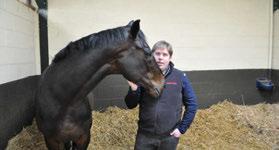
Tuesday, September 17
Wales & Midlands regional day
Spend the day with the Skeltons. The morning will be hosted at the Lodge Hill yard of Dan Skelton (pictured above) prior to lunch in a local pub. It is then around the corner to Grace Skelton’s Alne Park Stud.
For more information regarding these events, as well as to see when regional days have been fixed, either contact the office or check out the regular e-bulletins.

A Yorkshire-bred winner of one of the county’s most prestigious races: there could be no more appropriate recipient of the TBA Breeder of the Month award for May than Copgrove Hall Stud, after Economics claimed Group 2 success in the Al Basti Equiworld Dubai Dante Stakes at York.
Founded by one successful Yorkshire businessman in Vaguely Noble’s breeder Lionel Holliday in 1939, Copgrove Hall was brought back up from scratch by another, Guy Reed, after he purchased the hall and 50 acres of land in 1969.
Less than a year earlier, Reed bought his foundation mare, the four-year-old Ardneaskan, at the Tattersalls December Sales for 4,000gns on the advice of his trainer Sam Hall. Ardneaskan was carrying to Sovereign Path, and the resulting foal immediately put Reed on the road to success, since he was the useful stayer and subsequent stallion Warpath, whose son Shotgun finished fourth in Shergar’s Derby. Now, Ardneaskan is the fourth dam of Economics.
Copgrove Hall manager Brian O’Rourke rightly notes: “Guy Reed would have been so proud. Not only did he breed and race the female side of the family, but Peintre Celebre, the sire of Economics’ dam La Pomme D’Amour, was raised on the stud by the Wildensteins. Guy won decent races at York, such as the Nunthorpe with La Cucaracha and the Ebor with Dakota, but this would have been extra special to him.”
La Pomme D’Amour, trained by Andre Fabre, recorded her crowning glory in August 2013, just a month after Reed’s death, by winning the Prix de Pomone for the second time, her fifth success in a 16-race career. However, her stud career did not immediately spark.
O’Rourke points out: “From her first six foals she had just one winner, and that was in a Newcastle bumper. She’d been mated largely with Northern Dancer horses, so we thought we’d send her to Night Of Thunder, a son of Dubawi, whom we could afford at the time, and along came the colt who grew into Economics.
“He was a cracking foal, a big, strong boy, but maybe lacked a step. We had to sell him as a foal to keep the business’s cash flow going, and he was bought by a very shrewd man, Adrian O’Brien of Hazelwood Bloodstock, for 42,000gns, and he turned him over as a yearling for 160,000gns.”
Economics had not burst on the scene when La Pomme D’Amour’s next foal, by Masar, died, and then a Nathaniel colt foal was sold last year for 19,000gns. She was rested last year but is safely in foal to Stradivarius. “After Economics, we’ll probably go back to a Dubawi next year,” O’Rourke reflects.
La Pomme D’Amour’s mating with Stradivarius was perhaps no surprise, since O’Rourke spent from 2008 to 2017 as manager of the Gold Cup winner’s base, the National Stud, after 12 years in Kentucky and before his move to Copgrove Hall, which continues to operate in the ownership of the Guy Reed Trust.
Reed had no children and everything to do with the stud has been put into the trust for 20 years, with his nephews Clive and John Reed taking nominal charge from their respective homes in Harrogate and Monte Carlo.
The daily business side of the enterprise has been entrusted to O’Rourke, who explains: “I was brought on board to make the place commercial, which I have done. We’ve put up 60 new boxes, and have some very good clients – Jim and Fitri Hay, James and Anita Wigan, David and Vimy Aykroyd and Yulong, so the place is washing its face.”
With 99 per cent of Copgrove Hall’s business conducted among outside clients, the emphasis is hugely different from Reed’s heyday when he had two dozen mares and a large string of horses split among four or five trainers.
“We have just three mares, all from Guy’s original stock. There’s La Napoule, a half-sister to La Cucuracha, who won seven races, and Le Toreador, who won 13. She won only a small race at Wolverhampton but has bred three winners, including Peggy Sioux, a very fast filly over five furlongs who was rated in the high80s and has been retained for the stud.
“Then, of course, there’s La Pomme D’Amour. Who could forget her after Economics?”
Further incentivising and rewarding the breeding, buying and racing of middle-distance fillies and chasing mares.
Don’t worry, GBB isn’t going anywhere.
The core of GBB remains unchanged, but with the addition of GBBPLUS you’ll have the opportunity to put a little extra in your pocket.
* GBBPLUS bonuses will be awarded from January 2025
Registered for GBB
GBBPLUS filly checklist:
100% or 50% GBB A middle-distance filly or a chasing mare
GBB PLUS AVAILABLE BONUSES PER RACE
With an additional GBBPLUS bonus of up to £20,000, races that fulfil all core and extension criteria could be worth up to £40,000 to a filly.
up to £20,000
Class 2-4 maiden, novice, and conditions races at eight furlongs and over for two-year-olds, and at 10 furlongs and over for three- and four-year-old fillies.
up to £20,000
Nurseries over eight furlongs and Class 2-4 handicaps for three- and four-year-olds at 10 furlongs and over.
up to £20,000
A selection of seven fillies only, 10 furlong and over Listed races. These bonuses are only available to 100% GBB fillies.
AVAILABLE BONUSES PER RACE
Class 1s will carry the same value of bonuses regardless of whether they are mares-only or all-sex races.
£30,000
For Class 1-4 steeplechases.
£20,000
For Class 1 hurdles & Class 2–4 mares-only hurdles. £10,000 for Class 2-4 hurdles.
£10,000
For Class 1 NHF & Class 2-4 mares-only NHF. £5,000 for Class 2-4 all-sex NHF.

l


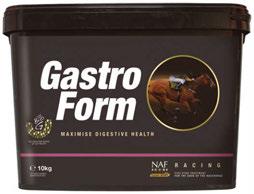




>

Graham
Dench
asks our jury the big questions:
What is racing’s top priority for the incoming government to address?
Ralph Beckett Classic-winning trainer and former President of the NTF
“ The obvious one is a sustainable funding mechanism – in a perfect world we’d have a Pari-Mutuel type system, but that’s not going to happen.
I think the government needs to tell the bookmakers that they have to stop running down the clock. If they are not going to play ball, they need to be told what to do in my opinion, but the government isn’t going to do that – that’s the problem.
I don’t think racing has helped itself in that we were far too anxious to defend FOBTs five years ago. We were compromised by the links that the leadership at the BHA had with the betting industry, and everything that has happened since is in some way linked to the fact that we were very happy to take bookmakers’ money when they were ripping off their customers. There were

some in the bookmaking fraternity that were warning 15 years ago that it wasn’t sustainable, but the larger bookmakers ignored it.
We are still trying to work with the betting industry; I don’t think that’s sustainable. We should be telling them where to get off and we should be telling the government that bookmakers need to pay a decent price for the product.
Everybody is far too conflicted at the top, and nothing has happened. It’s not a secret that the outgoing Chairman of the BHA, Joe Saumarez Smith – who is an owner of mine – is a major shareholder in an online casino, and that’s a problem. But it’s unfair to expect government to sort it out when we can’t sort out our own house. We are far too conflicted. We should be charging bookmakers and not cosying up to them.

Andrew Black Owner, breeder and entrepreneur
“ Racing has been the perennial loser in decades of betting and gaming evolution; it gets caught in the crossfire every time the regulator acts to stem the growth of problem gambling. For as long as we are grouped in with other forms of gambling, we are caught in a downward spiral and are powerless to respond to the growing burden of regulation. We are social and cultural in nature in ways that no other forms of gambling can claim to be, and we have a right to protection. I would like the incoming government to see that horseracing is carved out and differentiated from all other forms of gambling in future legislation – only then can we build effective strategies for future growth.
John Francome
Former champion jump jockey, pundit
and author
“ Visas for overseas workers in racing is number one for me.
When Victor Dartnall retired recently he made a comment which every owner should look to. He said that it makes a massive difference if you can have the same person riding your horse every day, and that’s become very hard for a lot of trainers.

Good riders are a necessity and there are precious few of them these days, I’m afraid. There are plenty of good lightweight riders available in South America, India and so on, but the current immigration laws make it very difficult to bring them over. Pretty much every trainer in the country will tell you this.
I’d also say that if the Labour Party is elected it will only be a matter of time before they ban the whip. Racing needs to get on the front foot to pre-empt that and deal with the issue on its own terms before the government forces its hand.
Alex Frost CEO of UK Tote Group, owner and breeder
“ It is essential that British racing agrees a unified ten-year commercial strategy that embraces the entire sport, and which allows a more far-reaching buy-in.
British racing is only one part of a vast equine industry when you consider its employment and reach. To ensure the support of the next generation, racing needs to be thinking much more laterally and working very closely with those around it, especially government, on both domestic and, crucially, international opportunities of which there are many to go after.
At the most basic level, racing first needs to work effectively with existing international partners to maximise commercial opportunities and income to the sport. We enjoy extraordinary global interest, not matched by any other racing nation, yet too often we fail to present our international partners with a very clear plan for how they can work with the whole of British racing to everyone’s benefit.
From my experience of working with the Department of Business and Trade, the government wants to get behind a leading UK sector like horseracing – but it has to know how it can assist us. Its support can add huge weight to our conversations with leading racing authorities, such as the Hong Kong Jockey Club, Japan Racing Association and PMU. It is incumbent on British racing, and its partners like the Tote, to fully utilise this in a coherent and effective manner as part of a ten-year commercial strategy.

Conor McGinn
Former Labour MP and owner
Gay Kelleway Trainer and ROA Board member
“ Any further delay in resolving the issues around gambling legislation and affordability checks and so on are concerning, but you won’t find me in the doom and gloom camp as I actually think the sport in this country is in a lot better shape than people give it credit for.
That said, there is one area in which the next government could make a big difference, and that’s in relaxing the legislation that makes it so hard to bring foreign staff in nowadays.
You can’t sail the ship alone, and you are only as good as your staff. I’m lucky in that I’ve got a great team looking after my 18 horses, including a head girl who has been with me for 22 years, but a lot of the bigger stables are finding it more difficult than ever to get the right people.
Racing needs staff, and we are not generally attracting the right people from closer to home. We can’t keep relying on kids from the Racing School or from riding schools. There seem to be too many things going on in the lives of most British kids these days, and not everybody is brave any more. Back in the day we would fall off, get up and get on with it, but it’s a different mentality now.
I used to get some great lads from Turkey, boys and girls. They already knew what they were doing, and they were the right sort of weight, but we can’t get them now.
But after 32 years as a trainer, I still think racing is great. I find I’m working harder than ever to attract new owners, but I’m still gaining them, not losing them, and I couldn’t be happier. I still love it.
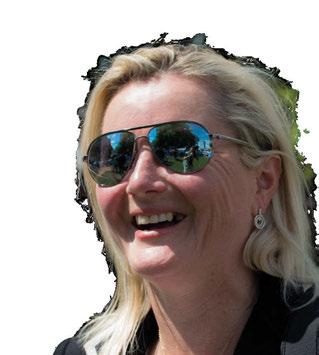
“ I think we always start from the wrong position here. It shouldn’t be what can racing ask of the next government. It should be what can we offer the next government – and we need to be far better at selling ourselves. Ideally, we would be in a much stronger position in terms of our relationship with the incoming government, but we have to focus on the future; we have an opportunity now to essentially present Labour with a compelling story about the benefits that racing brings to the economy, to the cultural and sporting life of Britain and to communities.
We have a great story to tell and sometimes because of the complicated and convoluted nature of some of the discussions we have around levy and welfare and other what might be described as contentious issues, we lose sight of that which is staring us in the face.
That is a very simple, attractive proposition to any government about a great British product that is world renowned and a huge net contributor to the economy.
Let’s go back to fundamentals and first principles here in terms of our relationship with the next government and be confident and positive about our great sport.

Recommend the ROA to a fellow owner, and when they join you'll both enjoy 14 months membership for the price of 12.
By joining, they’ll be supporting the ROA in protecting owner interests on major issues such as prize money and welfare, whilst promoting the thrill of ownership both on and off the racecourse.
Membership includes:
• Third party liability insurance
• Owner sponsorship scheme with the Tote
• 20% discount on BHA fees
• VIP car park label
• Complementary racecourse access
• Monthly Owner Breeder magazine
Individual ROA Membership - £280
Joint ROA Membership (for two people at the same address) - £470 (Maximumof6monthsfreepercurrentmember.Closingdateforapplicationsis30September2024)

Share the ROA experience, and grow the ownership community. Together we are a stronger voice.

Hot is the word. Two Guineas winners in his first crop and an early Stakes-winning juvenile from his second. Plus: his Australian youngsters are off to a G1 star t.
